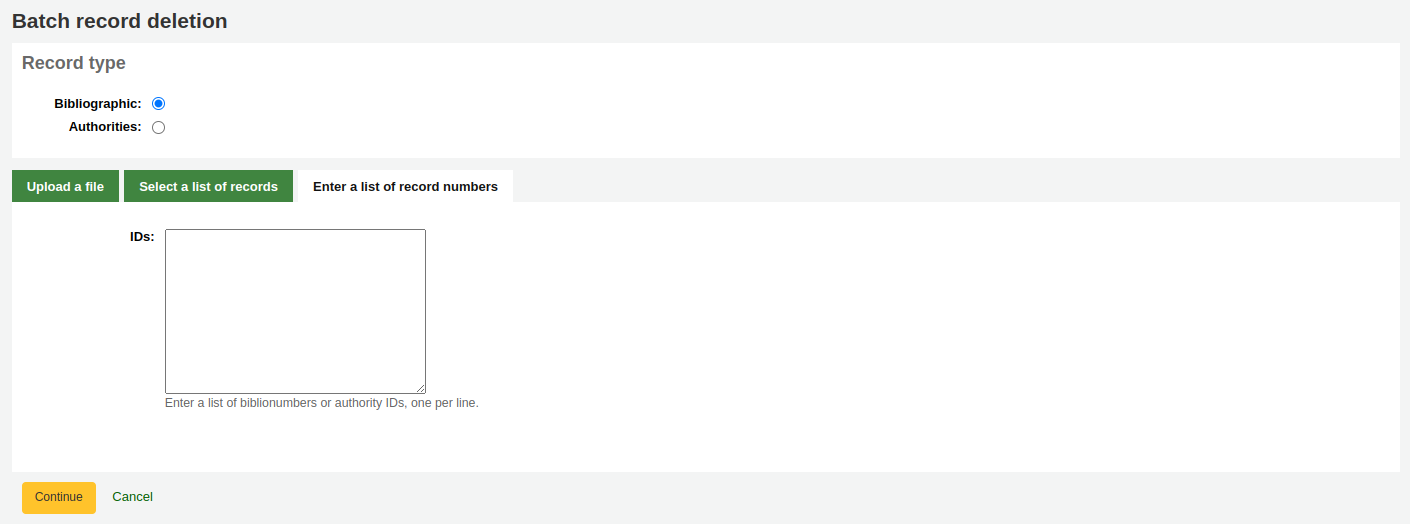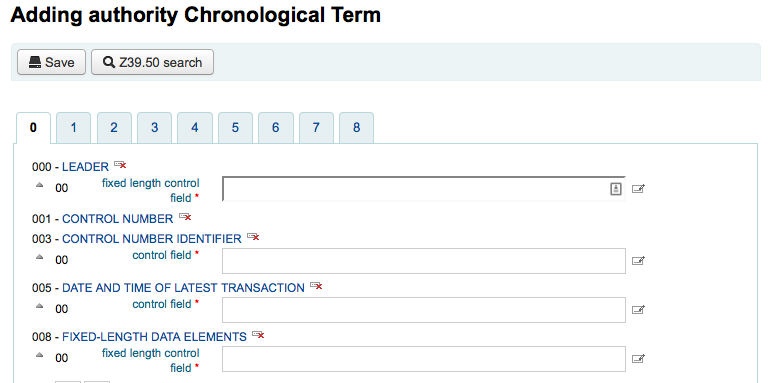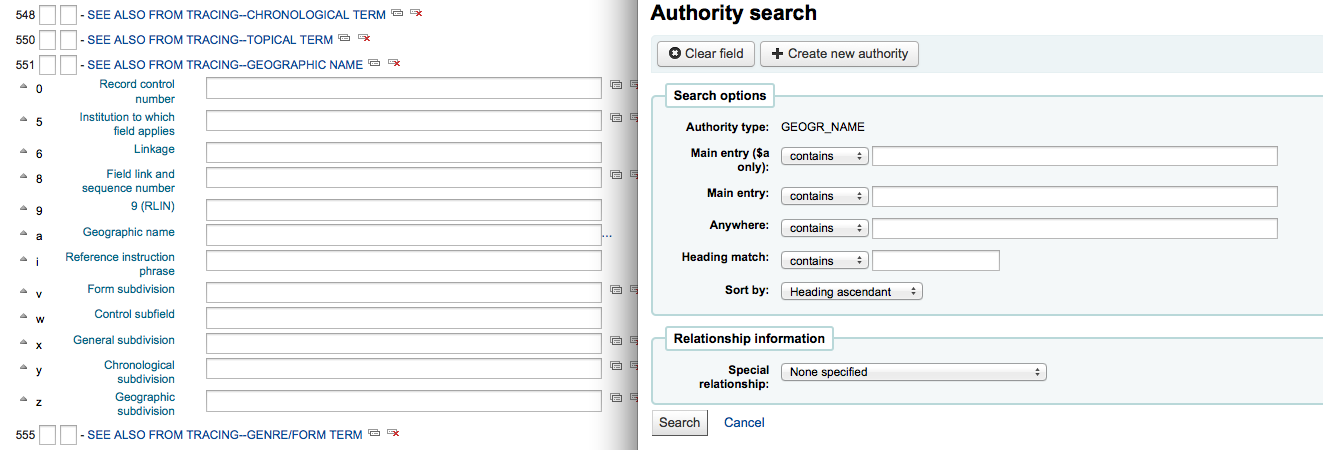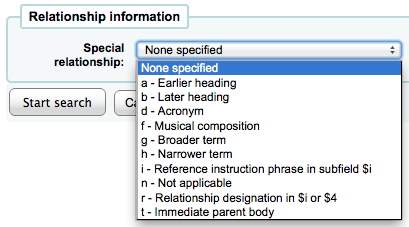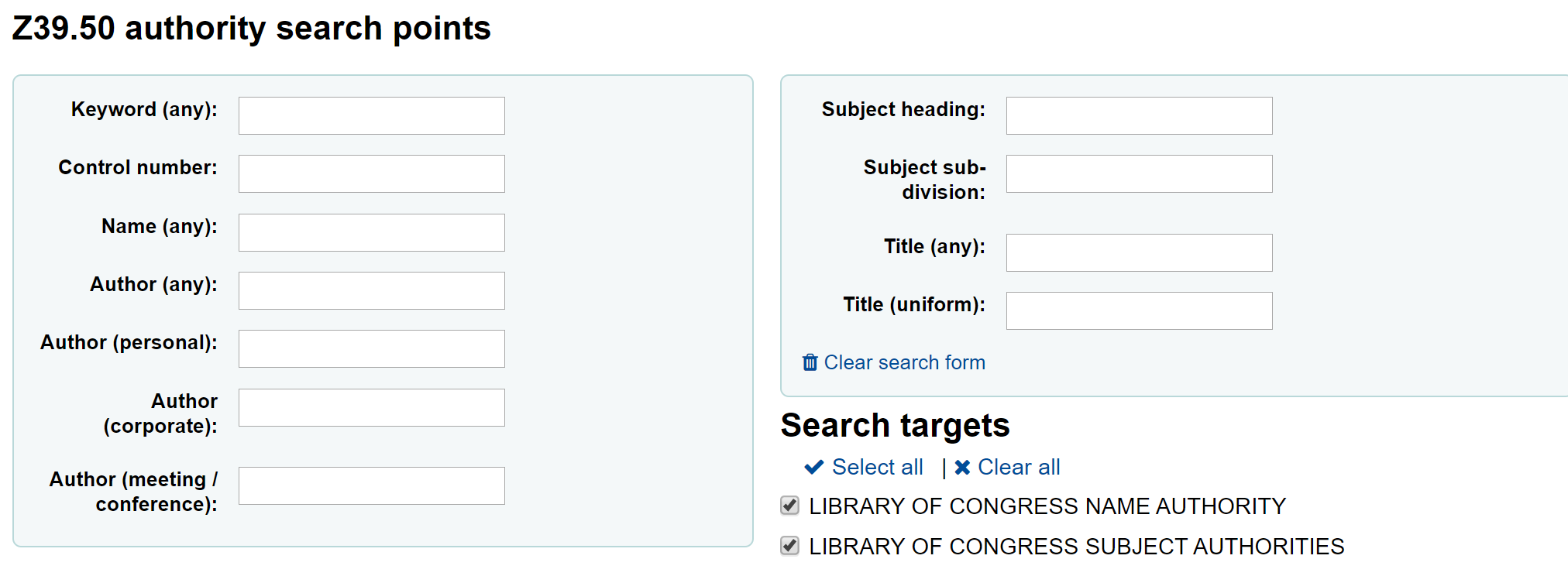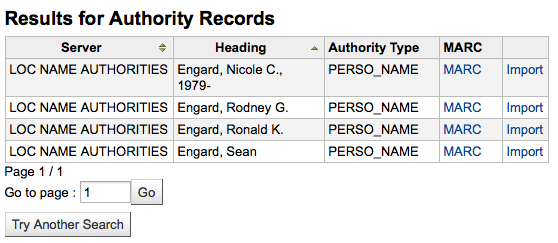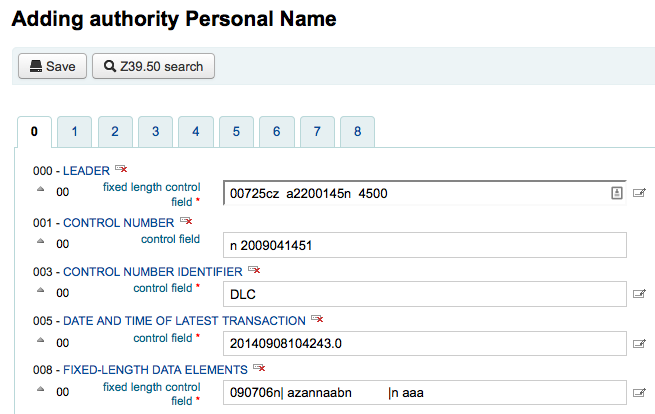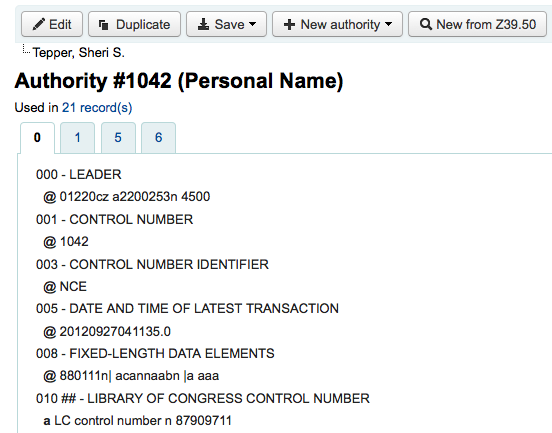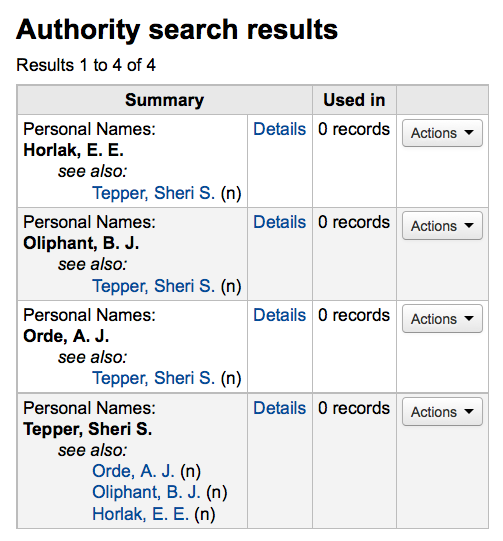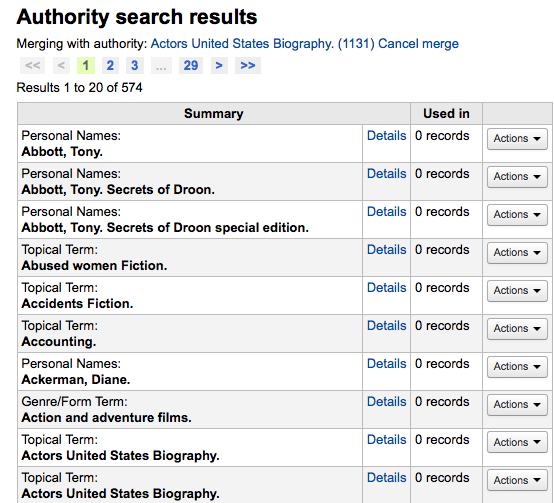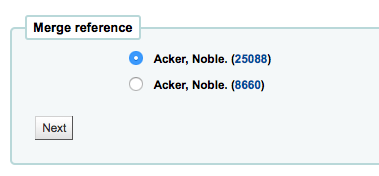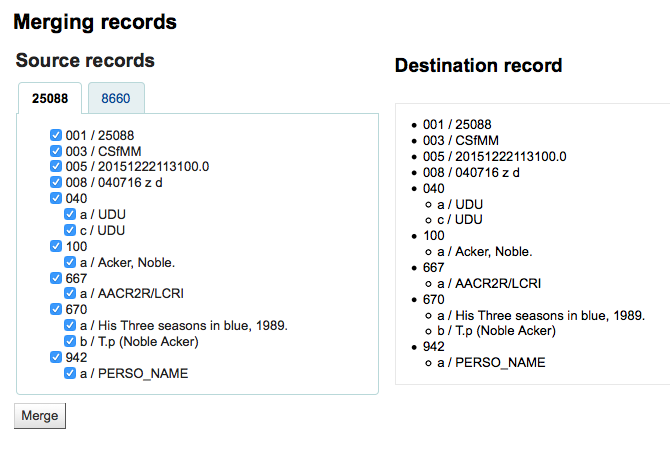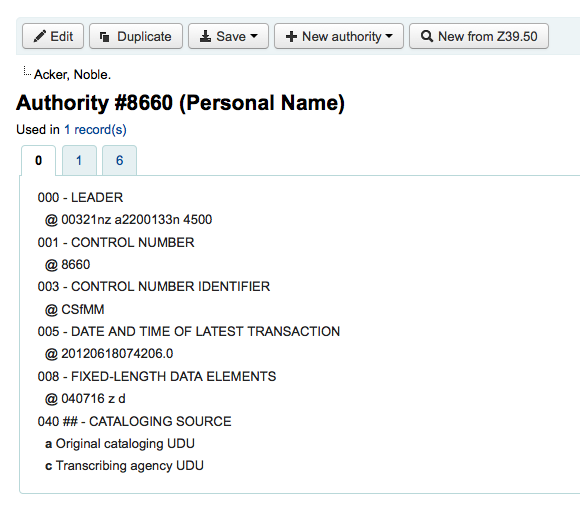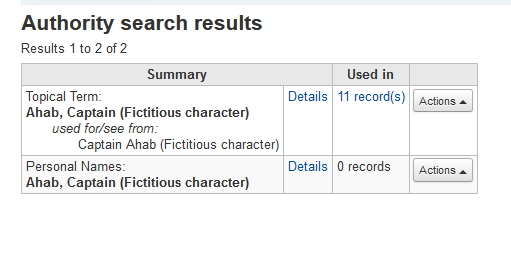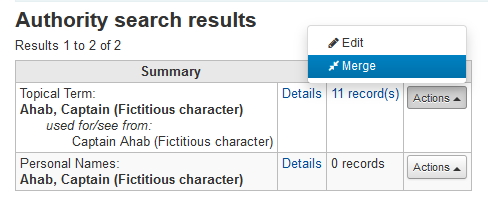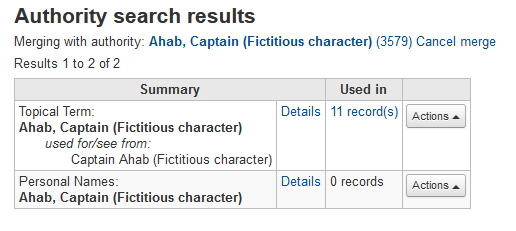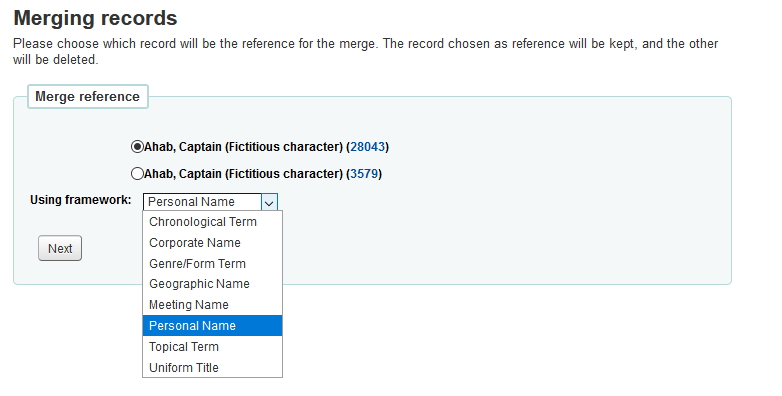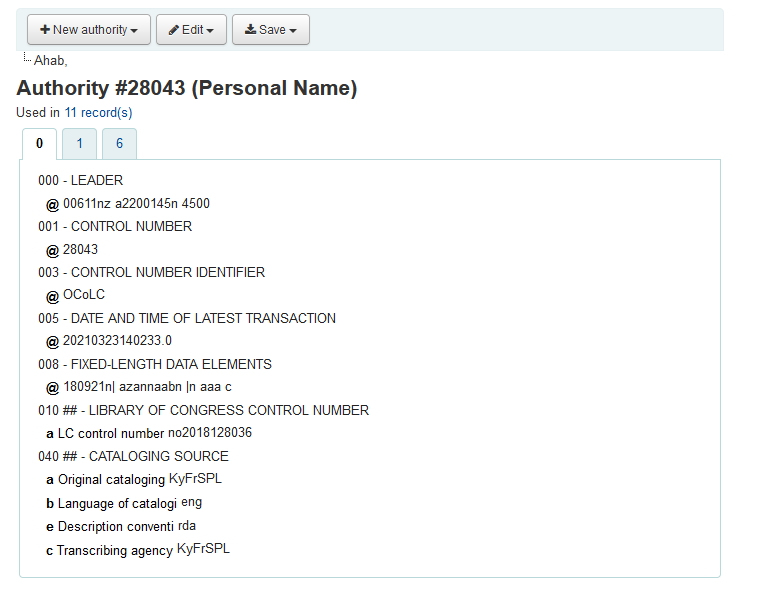編目
到那: 其他 > 編目
Before you start cataloging in Koha, you need to do some basic setup. Refer to the Implementation checklist for a full list of these things. Most importantly, you need to make sure that your MARC bibliographic frameworks are all defined the way you want. Once in the cataloging module you will not be able to add or remove fields and subfields, so your frameworks must be ready before you start cataloging.
You can also use OCLC Connexion to send records directly in to Koha. For more information on that please review the OCLC Connexion Gateway setup appendix.
Bibliographic records
In Koha, the bibliographic record contains the main information related to the material. This includes things like the title, author, ISBN, etc. This information is stored in Koha in MARC.
備註
Koha supports MARC21 and UNIMARC.
Once this information is saved, item records can be attached to the bibliographic record.
Adding records
經由原始編目或複本編目可以新增紀錄入 Koha。也可使用基本或進階編目介面。
To catalog a record using a blank template in the basic editor:
Click 『New record』

備註
The 『New record』 button will open the default bibliographic framework. If you want to use a different framework, click the small arrow to the right of the 『New record』 button and choose the framework.
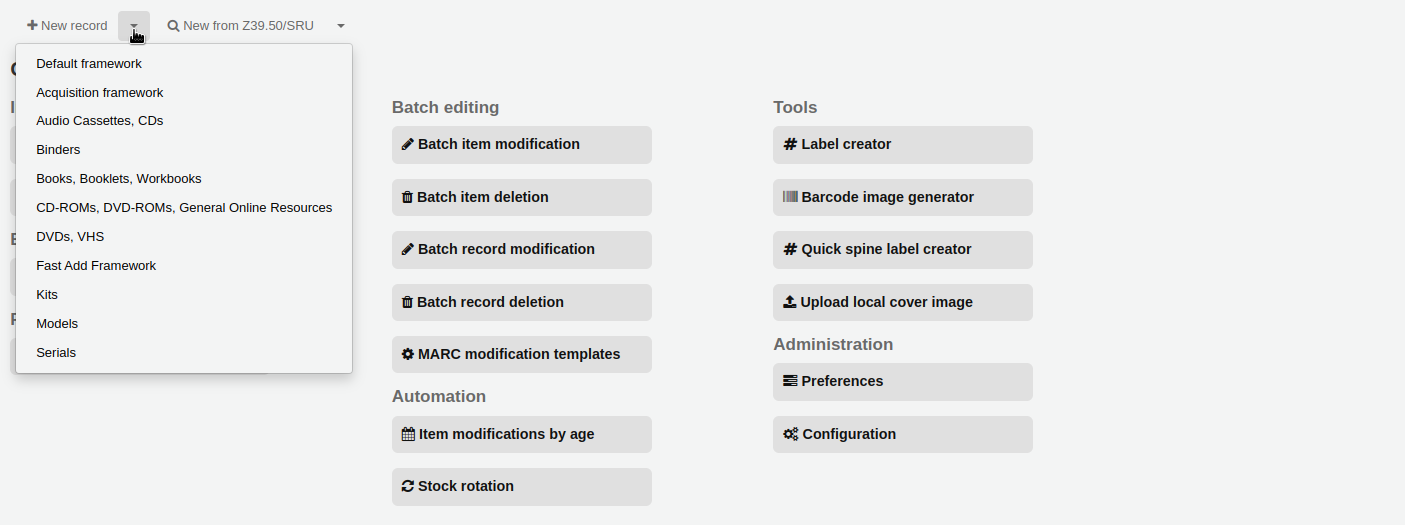
備註
You can create or modify frameworks in the Administration module.
To catalog a record using a blank template in the advanced editor:
Enable the EnableAdvancedCatalogingEditor system preference
按 『進階編輯器』 鈕

To catalog a record based on an existing record at another library in the basic or advanced editor:
按 『新增自 Z39.50/SRU』

備註
The 『New from Z39.50/SUR』 button will import the record into the default bibliographic framework. If you want to use a different framework, click the small arrow to the right of the 『New from Z39.50/SRU』 button and choose the framework.

搜尋打算編目的館藏
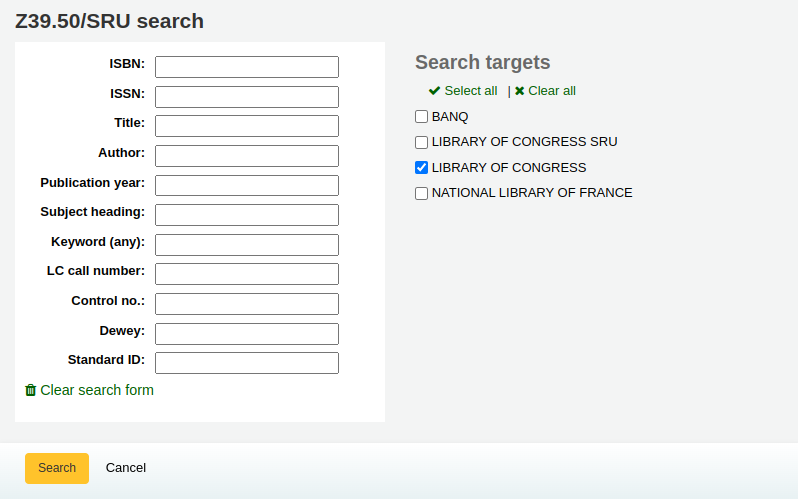
備註
若找不到,試著搜尋較少的欄位,不是所有的 Z39.50 伺服器都接受所有欄位的搜尋。
備註
Search targets can be edited by using the Z39.50/SRU servers section of the administration module.
備註
The display of extra MARC fields and subfields can be configured via the AdditionalFieldsInZ3950ResultSearch system preference.
Clicking the arrow button next to a result (or clicking anywhere on the result line) will give you preview and import options.
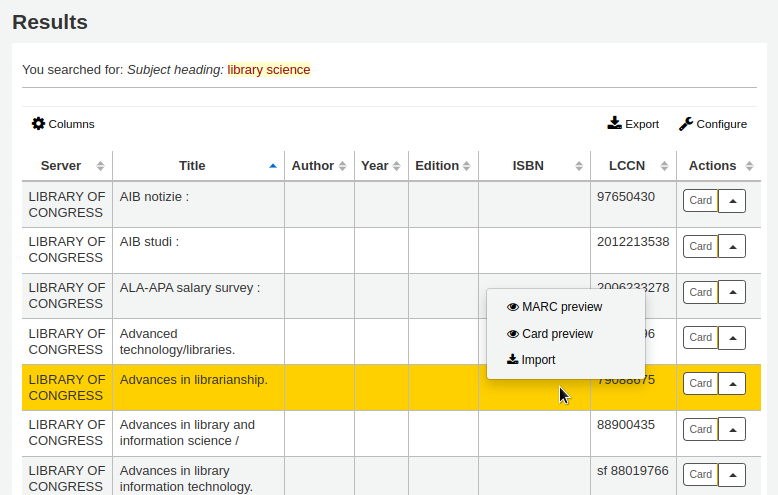
備註
The default option in the button next to a result is the last option used. In the above screenshot, the last option used was 『Card preview』 so the button is set to open the card preview by default.
備註
You can customize the columns of this table in the 『Table settings』 section of the Administration module (table id: resultst).
MARC preview: this option will open the record in plain MARC format.
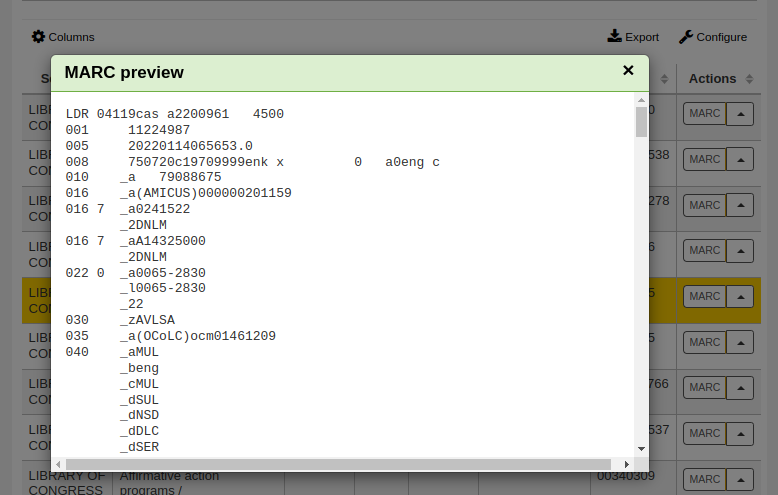
Card preview: this option will open the record formatted like a card catalog.
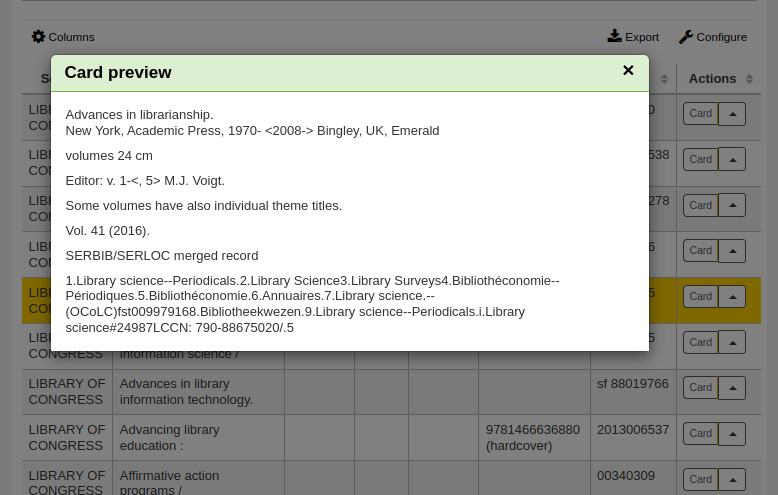
Import: this option will open the record in Koha’s cataloging editor so that you can modify and save the record in your own catalog.
If you don’t find the title you need in the Z39.50 search results, you can click the 『Try another search』 button at the bottom left of your results

Basic editor cataloging
在基本編輯器內,打開空白的框架或經由 Z39.50 匯入紀錄後,將出現繼續編目的表單
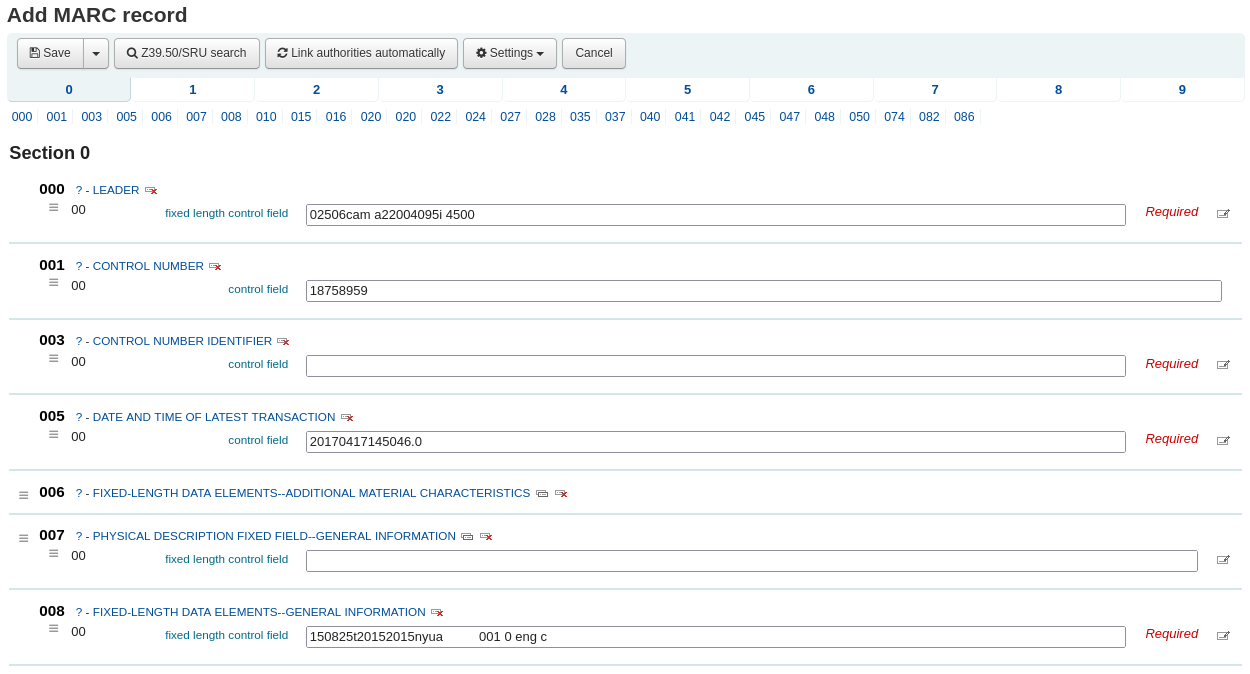
If you would rather not see the MARC tag numbers you can change the value in your hide_marc system preference or each user can check the box next to 『Show tags』 found under 『Settings』.
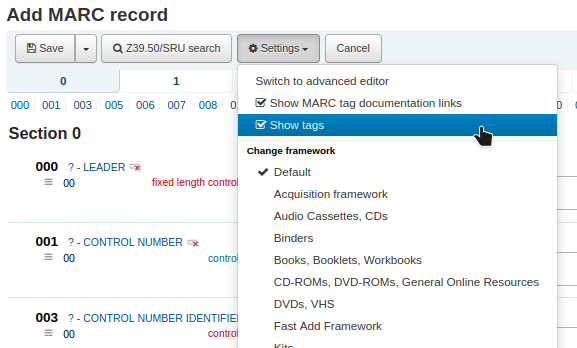
按下欄號說明,就能展開欄號
To get help from the Library of Congress on a MARC tag click the question mark (?) to the right of each field number
It is possible to change the source of the MARC documentation using the MARCFieldDocURL system preference
若覺得螢幕太擁擠,可以不勾選 『設定』 下,位於 『顯示 MARC 欄號文件連結』 說明盒旁的勾選盒,就能隱藏問號
Sometimes fields may not be editable due to the value in your RequireChoosingExistingAuthority system preference. If this preference is set to 「require」, you will see a lock symbol to the left of the field.

若此圖示顯示,您必須勾選欄位旁的該圖示,以搜尋既有的權威紀錄。

從結果清單裡點選 『選擇權威』 進入目錄紀錄

按欄號右方的 『重複此欄號』 圖示,就能複製此欄位

To move subfields in the right order, drag and drop the subfields using the handles on the right

備註
You can change the default order of the subfields in the bibliographic framework by dragging and dropping the subfield tabs when editing subfields.
勾選欄位右方的複製 (按下刪除圖示,就能移除複製欄位) 圖示就能複製分欄

勾選欄位右方的 - (減號),就能刪除分欄 (若有多個同樣類型)
To use a plugin click on the icon to the right of the field
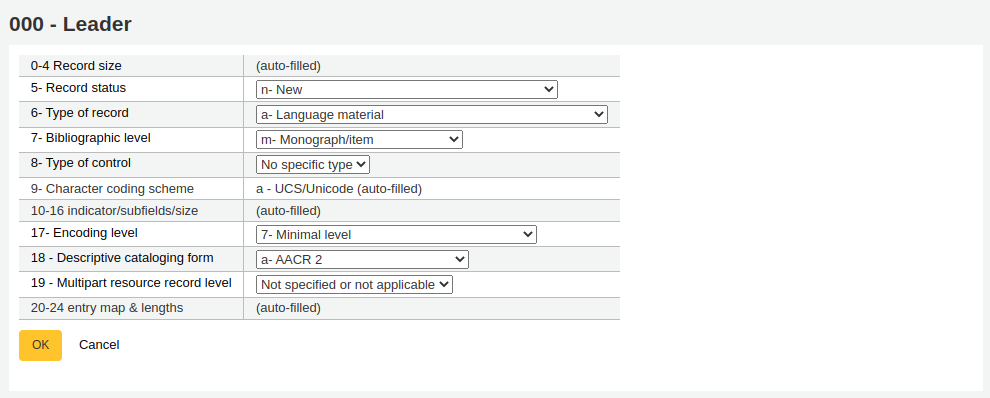
部份固定欄位有編輯器,根據編目的資料類型而改變(如:006與008欄位)
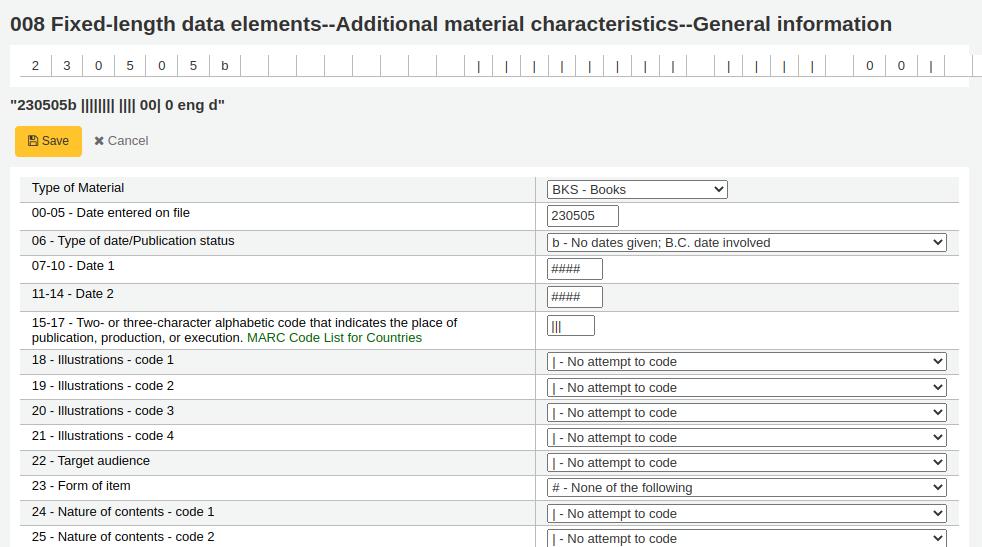
備註
The 『Type of material』 in 008 is determined by the value in leader/06.
完成後,按上方的 『儲存』 鈕儲存並檢視剛才新增書目記錄,或繼續新增/編輯該筆書目記錄的館藏記錄
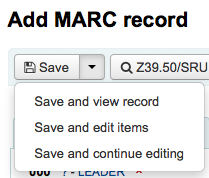
按下 『儲存與檢視記錄』 進入剛才編目的記錄
按下 『儲存與編輯館藏』 先儲存書目紀錄,再進入新增/編輯館藏表單
按下 『儲存與繼續編輯』 儲存書目記錄,並繼續編輯該書目記錄
新增重複的紀錄時,系統會提示您先儲存

備註
To find possible duplicates, the system searches for the ISBN, and if there is not ISBN, it searches for the same combination of title and author.
If mandatory or important fields or subfields are not filled, the system will give a warning. Click 『Go to field』 to go to the problematic field and correct it.
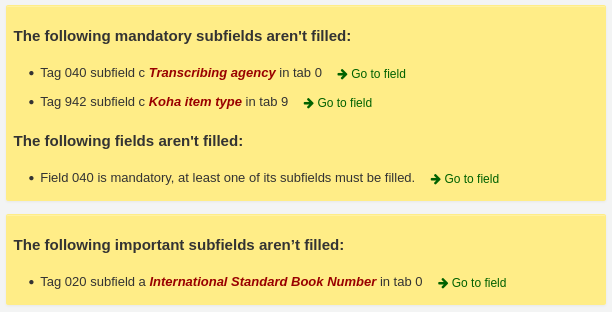
If you scrolled down and need to see the warning again, click the 『Errors』 button at the right of the toolbar.

備註
Important fields or subfields will not prevent from saving the record.
Only mandatory fields or subfields will block saving.
Advanced editor cataloging
In order to use the Advanced cataloging editor you need to enable the EnableAdvancedCatalogingEditor preference.
說明
This feature does not currently include any support for UNIMARC or NORMARC fixed fields.
在基本編輯器內,打開空白的框架或經由 Z39.50 匯入紀錄後,將出現繼續編目的表單

從左方的搜尋盒可執行 Z39.50 搜尋

從這些 Z39.50 結果按右方的連結可檢視 MARC 記錄

按 『匯入』 鈕將把記錄帶入編輯器供編輯之用
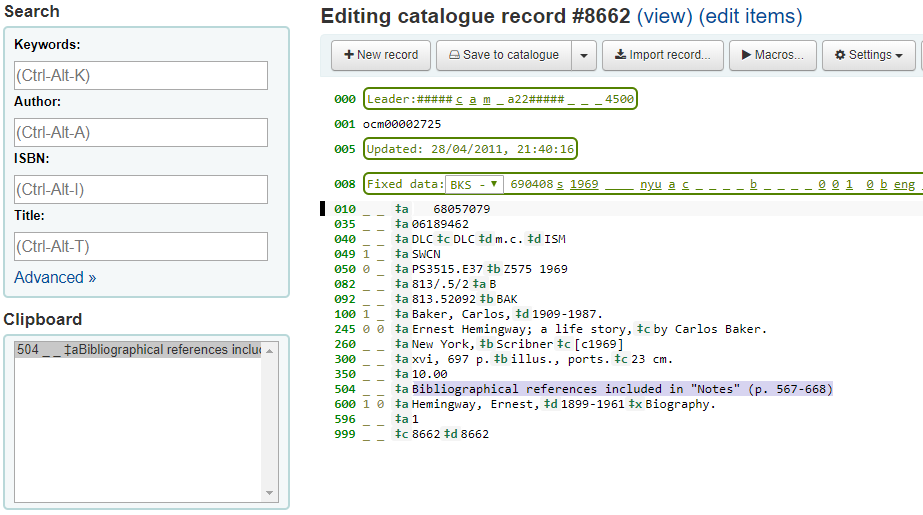
說明
在進階編輯器內新增欄位時,必須在空白的指標鍵入底線,並在前後加入空白。
說明
需在第一個分欄分隔符號前鍵入一個空白,但不必在其他分欄分隔符號前後加入空白。
At the bottom of the editor you will see help from the Library of Congress for the field you are on. In cases where your MARC is invalid you will see red highlighting. To edit the record using only keyboard functions the Keyboard shortcuts button will inform you of the necessary commands.
A clipboard is available to copy and paste text between fields. See the image and table below for the shortcuts used with the clipboard.
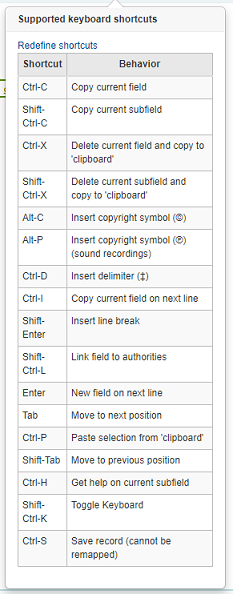
Advanced cataloging keyboard shortcuts
以下的鍵盤快捷鍵可用於進階編目模組以節省時間。
快捷鍵 |
行為 |
|---|---|
Ctrl-C |
Copy current field |
Shift-Ctrl-C |
Copy current subfield |
Ctrl-X |
Delete current field and copy to 『clipboard』 |
Shift-Ctrl-X |
Delete current subfield and copy to 『clipboard』 |
Alt-C |
Insert copyright symbol (©) |
Alt-P |
Insert copyright symbol (℗) (sound recordings) |
Ctrl-D |
插入分隔符號 (‡) |
Ctrl-I |
Copy current field on next line |
Shift-Enter |
搜入斷列標記 |
Shift-Ctrl-L |
Link field to authorities |
輸入 |
新欄位在下一列 |
定位鍵 |
移動至下個位置 |
Ctrl-P |
Paste selection from 『clipboard』 |
Shift-Tab |
移動至前個位置 |
Ctrl-H |
當前分欄的說明 |
Shift-Ctrl-K |
Toggle Keyboard |
Ctrl-S |
Save record (cannot be remapped) |
Advanced cataloging virtual keyboard
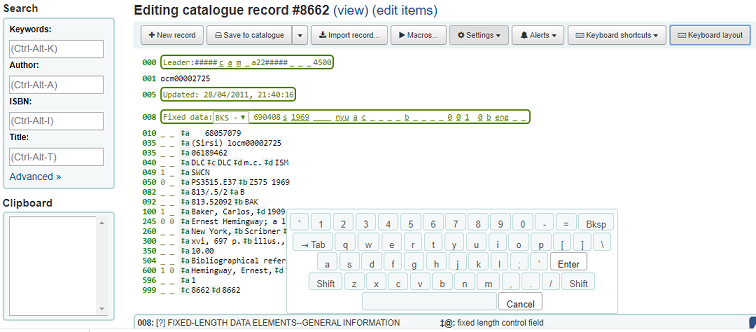
A virtual keyboard is available for adding diacritics and symbols. Use the shortcut Shift-Ctrl-K to display the keyboard. A 『Keyboard layouts』 button will display at the top of the advanced editor that allows you to set the virtual keyboard layout for different languages.
Macros in advanced cataloging
記錄新的巨集:
Select the 「Macros…」 button
將彈出視窗。在此視窗內,選擇 「新增巨集…」,在彈出盒內鍵入新的巨集名稱並選擇 OK。
現在按數字 1 右方,並鍵入巨集的第一列。若有多列,如多欄位巨集,按歸位鍵才會出現數字2,並鍵入第二列/欄位等。
自動儲存您的巨集。做好後按 「x」 關閉視窗,或選擇編輯後要執行的記錄,或選擇其他要執行的巨集。
編輯既有的巨集:
Select the 「Macros…」 button
將彈出視窗。在此視窗內,選擇要編輯的巨集 & 變更它。
將自動儲存您的工作,並且在完成後選擇 「x」 關閉視窗,或選擇編輯後記錄內要執行的巨集,或選擇另個要執行的巨集。
巨集語言的基本語法:
新增 500=‡a以 Rancor 編輯
新增 500 欄位的 ‡a 分欄並 「以 Rancor 編輯」。
245c= by J.K. Rowling.
需要的話,在第一個 245 欄位的第一個 ‡c 分欄著錄 「by J.K. Rowling」。
082a={084a}
在第一個082欄位的 ‡a 分欄 (需要時新增分欄) 設定內容為第一個 084‡a。
指標=_1
將最後提及欄號的指標 (在此例是,082) 設為 「_」 與 「1」。
新增 090a=Z674.75.W67
新增第一個 900 欄位 (僅限已有該欄位) 的 ‡a 分欄並設定為 Z674.75.W67。
新增 090a 於 end=Z674.75.W67
同上。
在 a= a tale of might and magic / 之後新增 245a
在第一個分欄後面,新增 ‡b,並將其內容設定為 」 a tale of might and magic /」。
刪除 245b
刪除第一個 245 欄位的 ‡b 分欄
Importing records
It is possible to import both bibliographic and authority MARC record files in Koha. The files to import can be either in MARC or MARCXML format.
Importing records into Koha includes two steps.
The first is to stage records for import, which prepares the records, and imports them in the reservoir.
The second step is to import the prepared, or 「staged」, files from the reservoir into the catalog.
Staging records for import
Get there: More > Cataloging > Import > Stage records for import
First, find the MARC file on your computer

- Next, you will be presented with options for record matching and item
imports
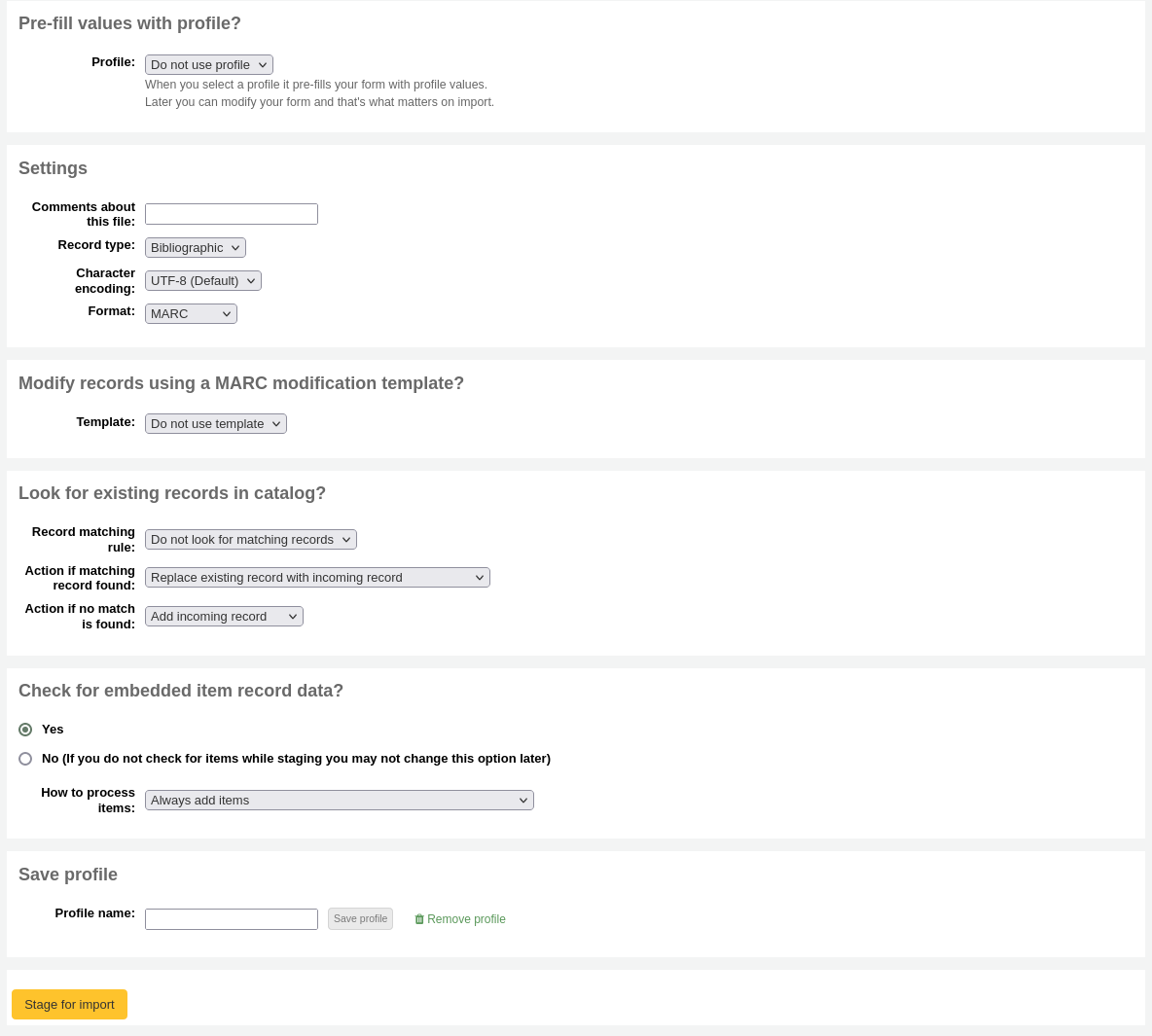
Pre-fill values with profile: if you already have staging profiles set up, you can choose the appropriate profile from the dropdown list
Profiles are used to pre-fill the rest of the staging settings form.
You can create a profile by choosing the various settings in the sections below and enter a profile name at the end of the form. Next time you stage records, the profile will be available.
Comments about this file: enter comments to identify your upload when going to the 『Manage staged records』 tool
Record type: choose which type of records are in this file, bibliographic or authority

Character encoding: choose the character encoding of your file

Format: choose the MARC format of your file

Modify record using a MARC modification template: choose if you would like to use a MARC modification template to alter the data you’re about to import

Choose whether or not you want to look for matching records

Record matching rule: choose which rules to use to check your catalog if these records already exist.

備註
You can set up record matching rules in the administration area
備註
When using the ISBN matching rule Koha will find only exact matches. If you find that the ISBN match is not working to your satisfaction you can change the AggressiveMatchOnISBN preference to 『Do』 and then run your import again.
Action if matching record found: choose what to do with matching records if they are found
Replace existing record with incoming record: choose this if you are importing more complete records than the ones you currently have, or if you made some changes using an external tool (MarcEdit for example)
Add incoming record: this will keep the existing record and add the incoming record, so you may end up with duplicates
Ignore incoming record (its items may still be processed): choose this if you do not want to replace existing records
Action if no match is found: choose what to do with records that are unique
Add incoming record: choose this if you wish to import records that are not already in your catalog (new titles for example)
Ignore incoming record: choose this if you don’t want to import records that are not already in your catalogue (for example, if you’re only replacing existing records and don’t want to add anything)
Check for embedded item record data?: choose whether or not to import the item data (field 952) found in the MARC records (if the file you’re loading is a bibliographic file)

Always add items: always add items regardless of matching status
Add items only if matching bib was found: this will only add items to existing records in your catalog
Add items only if no matching bib was found: this will only add items to the new records you’re importing, not the ones that already exist
Replace items if a matching bib was found: the match will look at the itemnumbers and barcodes to match on for items and will only replace existing items.
備註
Itemnumbers take precedence over barcodes
Ignore items: this will not add any items
Save profile: you can choose to save the chosen settings under a profile to use again later

Click 『Stage for import』
The record staging will be treated as a background job. A progress bar will let you know how the job is progressing.

Click 『View detail of the enqueued job』 to see the summary of the staging
You will be presented with a confirmation of your MARC import

Number of records in file
Number of records with MARC errors
Number of records staged
Number of records matching existing records in the catalog
Number of items staged
To complete the process, continue to the Manage staged records tool by clicking on the 『View batch』 link.
If these records are to be used in acquisitions, you can stop here and add these records to a basket by ordering from a staged file
Managing staged records
Get there: More > Cataloging > Import > Manage staged records
Once you have staged your records for import you can complete the import using this tool.
From the list of staged files, click on the file name that you want to finish importing
Note that records that have already been imported will say so under 『Status』
備註
If you’re coming directly from the Stage records for import tool you will not see this list of staged files, you will be taken automatically to the right file summary
A summary of your staged file will appear along with the option to change your matching rules
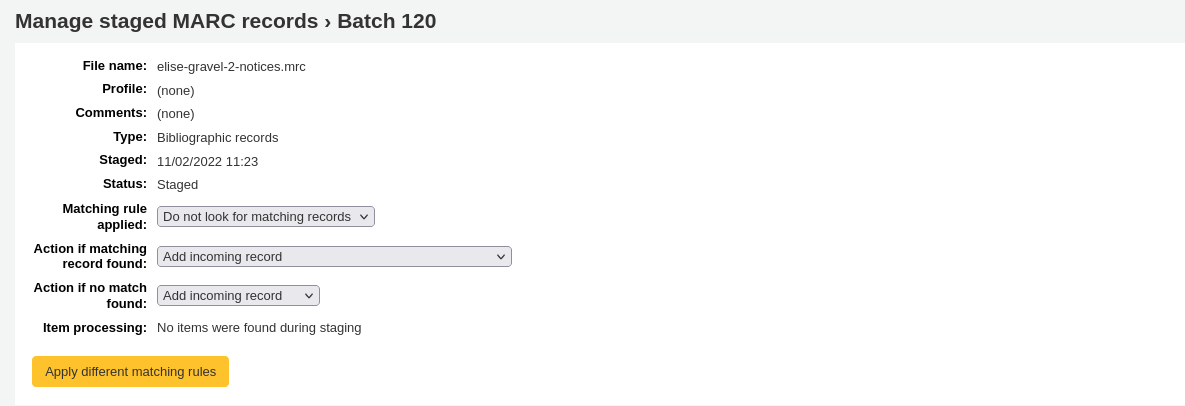
Below the summary is the option to import the batch of records using a specific framework
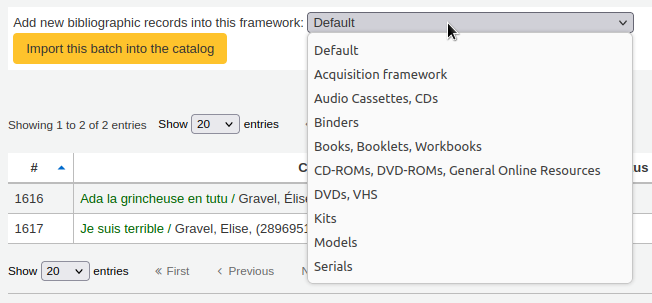
Choosing a framework other than 『Default』 isn’t necessary, but it’s helpful for running reports.
Below the framework selection there will be a list of the records that will be imported
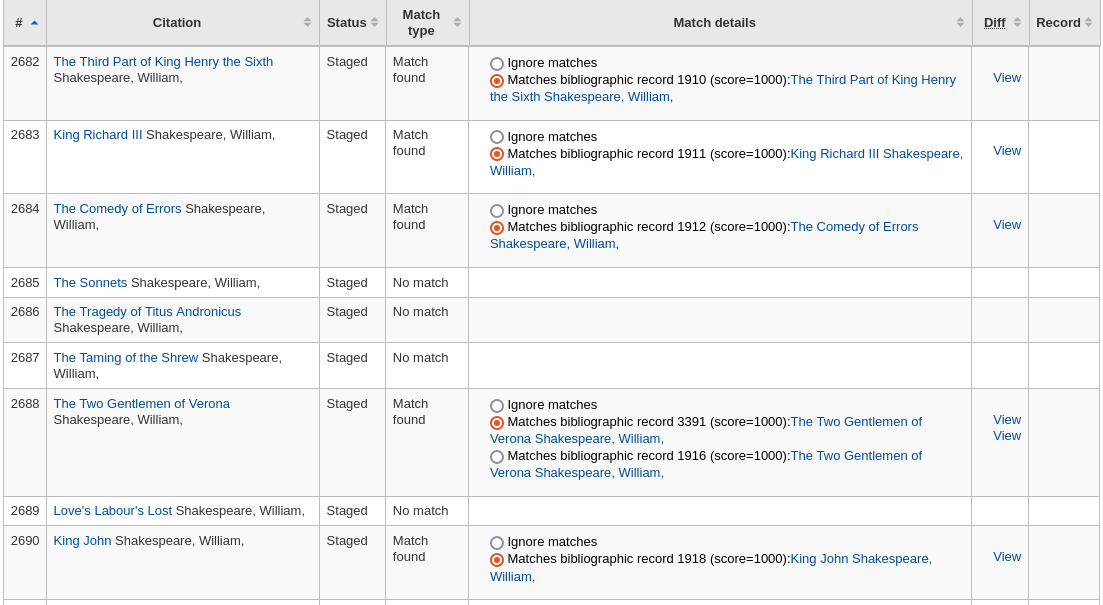
Review your summary before completing your import to make sure that your matching rule worked and that the records appear as you expect them to
Matches will appear with info under the 『Match details』 column

and when clicking the 『View』 link under 『Diff』 you can see the difference between versions.
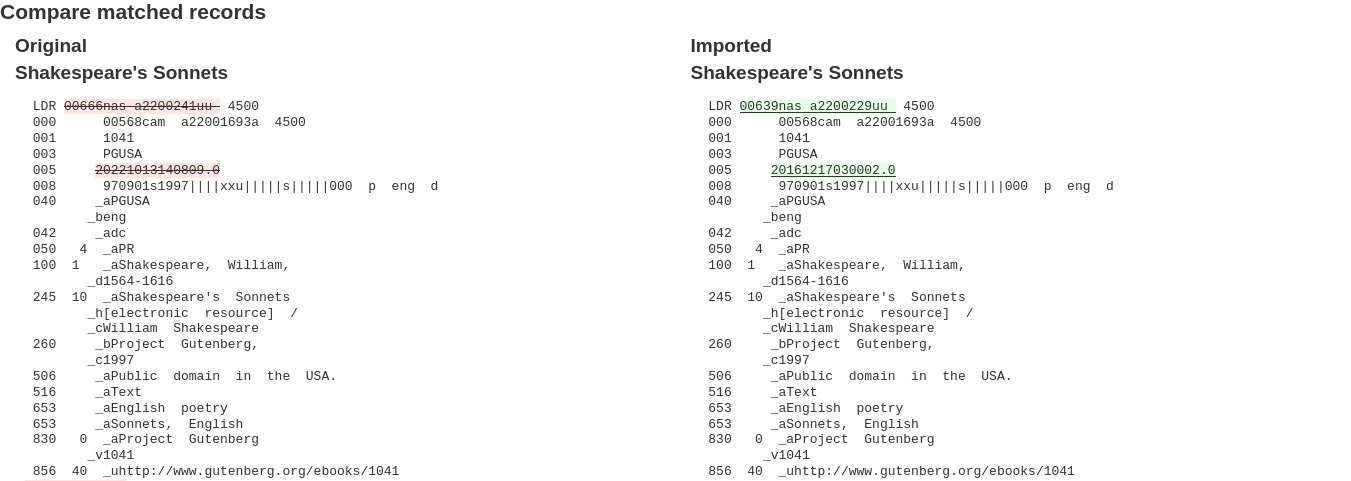
For each match, you can choose to ignore the match by selecting the 『Ignore matches』 radio button. If more than one matching record was found, they will all be listed and you can choose with which to match your incoming record.

If 『Ignore matches』 is selected, the action chosen in 『Action if no match is found』 from the staging step will be applied.
備註
Here are the different behaviors depending on the 『Action if matching record found』 choice from the staging step and if a match is selected or if 『Ignore matches』 is selected.
Action if matching record found
Match selected
『Ignore matches』 selected
Replace existing record with incoming record
Incoming record replaces selected matching record
『Action if no match is found』 is applied
Add incoming record
Incoming record is added
Incoming record is added
Ignore incoming record
Incoming record is ignored
『Action if no match is found』 is applied
Click 『Import this batch into the catalog』 to complete the import
The record importation will be treated as a background job.

You will be presented with a confirmation of your MARC import

Number of records added: new records added
Number of records updated: existing records replaced with the incoming ones
Number of records ignored: records that were ignored due to the matching rule
Number of items added: new items added
Number of items replaced: existing items updated with the incoming ones
Number of items ignored because of duplicate barcode: items that were ignored because the barcode already exists in the database
Once your import is complete a link to the new records will appear to the right of each title that was imported
You can undo your import by clicking the 『Undo import into catalog』 button
Records imported using this tool remain in the 『reservoir』 until they are cleaned either through the 『Clean』 button in the Staged MARC record management home page (see below) or through the cleanup_database cronjob. Reservoir records will appear when searching the catalog from the cataloging module
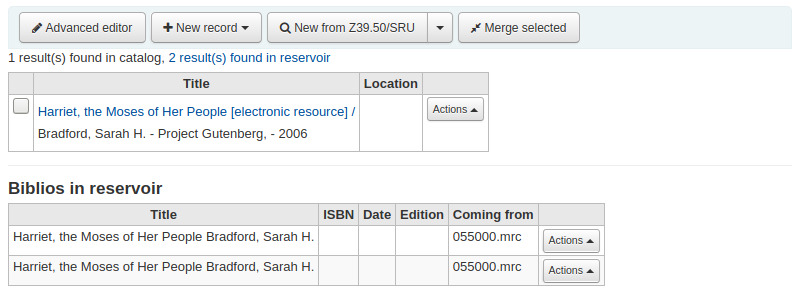
To manually clean items out of the 『reservoir』:
Visit the main screen of the manage staged MARC records tool

To clean a batch, click the 『Clean』 button to the right
You will be presented with a confirmation message

Accept the deletion and the records will be removed from the reservoir and the status will be changed to 『cleaned』
Adding analytic records
有時圖書館需要以分析編目技術,處理期刊裡的論文或專書裡的章節,供讀者使用。分析編目可編目期刊、報紙或期刊等書目記錄的部份內容,包括論文、章節、段落等。分析編目時,每個題名都有獨立的書目紀錄,但並未脫離主館藏的實體。詳情見中國編目規則第十四章分析與 AACR2 第 13 章。
If you would like to catalog analytic records there are two options. One is to use the Easy Analytics function; the other is the Analytics enhanced workflow.
Easy analytics
The easy analytics feature makes linking analytic records together easier. The first thing you need to do is set the EasyAnalyticalRecords preference to 『Show』 and the UseControlNumber preference to 『Don’t use.』
After cataloging your analytic record (see adding records for more on creating records) click 『Edit』 from the normal view and choose to 『Link to host item』
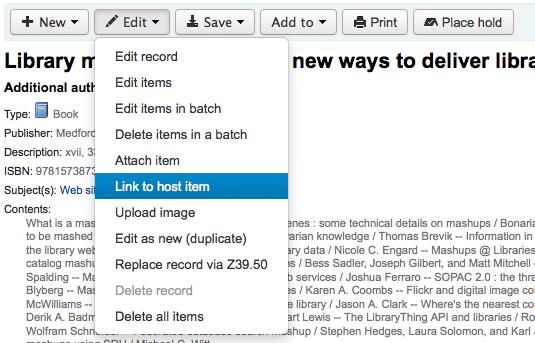
提示鍵入館藏的條碼,以連結至紀錄。

鍵入館藏條碼並按下 『選擇』 鈕後,出現確認訊息。

此紀錄的773欄位鍵入完整的連結。
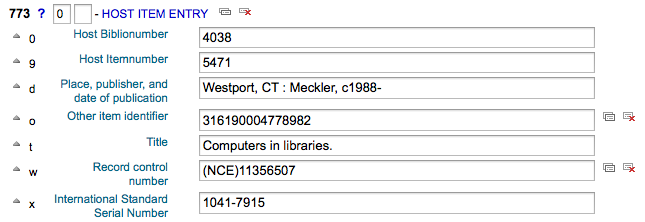
To view all of the items tied to the host record, do a search for the record, click the 『Analytics』 tab on the left and the analytics tied to each barcode will be shown under the 『Used in』 column.

說明
It is also possible to create analytic records from this screen by clicking on 『Create analytics』
You can also see the analytics attached to this record by clicking the 『Show analytic』 link towards the top of the record in the normal view.

檢視分析記錄時,從 『分析』 分頁館藏表的 『主記錄』 欄裡,也可看到連結至主記錄的分析。

Analytics enhanced workflow
To use the enhanced workflow method of adding analytics, the first thing you need to do is set the EasyAnalyticalRecords preference to 『Don’t show』 and the UseControlNumber preference to 『Use.』
After cataloging your original record (see adding records for more on creating records) click 『New』 from the normal view and choose to 『New child record.』
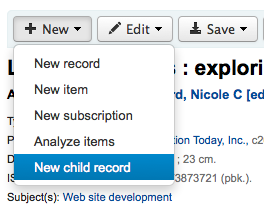
This will open a new blank record for cataloging. The blank record will have the 773 field filled in properly to complete the link once the record is saved.

The 『Show analytics』 link from the host record will now use the hosts record control number (001) to search for all records on the system of the type 『monographic component part』 or 『serial component part』 (Leader position 7) with a 773 subfield w that contains the hosts record control number.
Editing analytics
If you have linked an analytic record incorrectly you can remove that link by editing the analytic record (not the host record).
To do this, go to the analytic record and click the 『Edit』 button. For UseControlNumber simply edit or remove the corresponding 773.
If using EasyAnalytics choose to 『Edit items』; To the left of each item you will see two options.

Clicking 『Edit in host』 will allow you to edit the item on the host record.
勾選 『不連結』,將移除 773 欄位以及分析與主紀錄的連結。
Editing records
To edit a record you can click the 『Actions』 button and choose 『Edit biblio』 from the search results on the cataloging search page

或在書目記錄裡按編輯鈕並選擇 『編輯記錄』
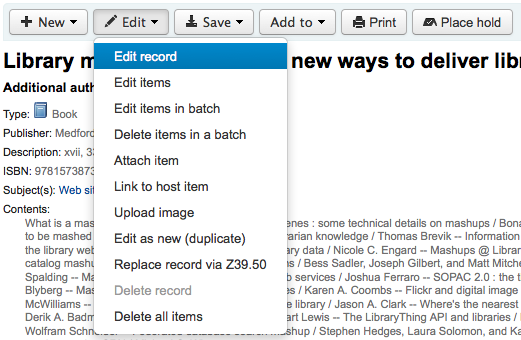
將以 MARC 編輯器打開此紀錄
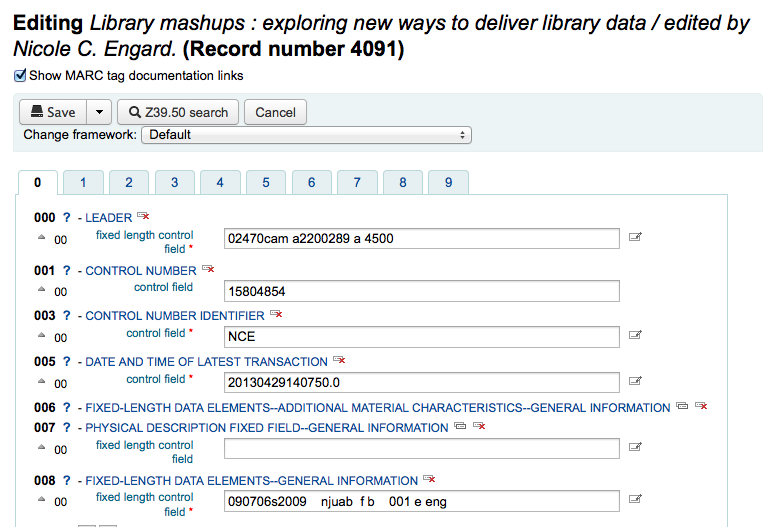
The alternative is to search via Z39.50 to overlay your record with a fuller record found at another library. You can do this by choosing 『Replace record via Z39.50/SRU』 from the 『Edit』 menu.
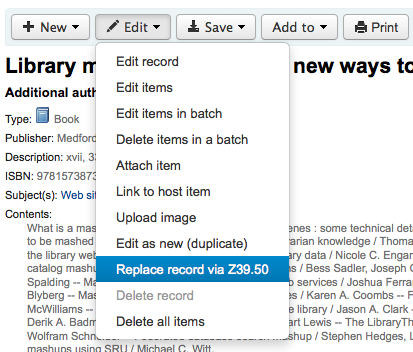
Once you choose that, you will be brought to a Z39.50 search window to search other libraries for the record in question.
編輯之後 (任何方式均可) 可按下編輯器左上方的 『儲存』 鈕。
Batch record modification
Get there: More > Cataloging > Batch editing > Batch record modification
This tool is used to edit batches of bibliographic and authority records using MARC modification templates. Before visiting this tool you will need to set up at least one MARC modification template.
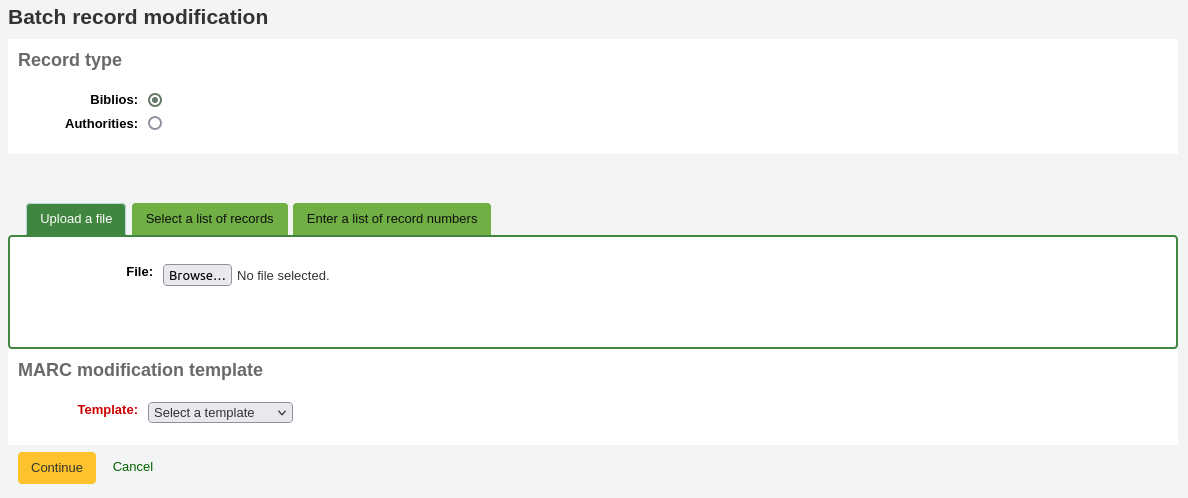
Record type: choose whether you’re editing bibliographic or authority records
Enter the biblionumbers or authids of records to be edited, in one of three ways
Upload a file of biblionumbers or authids
Use a list;
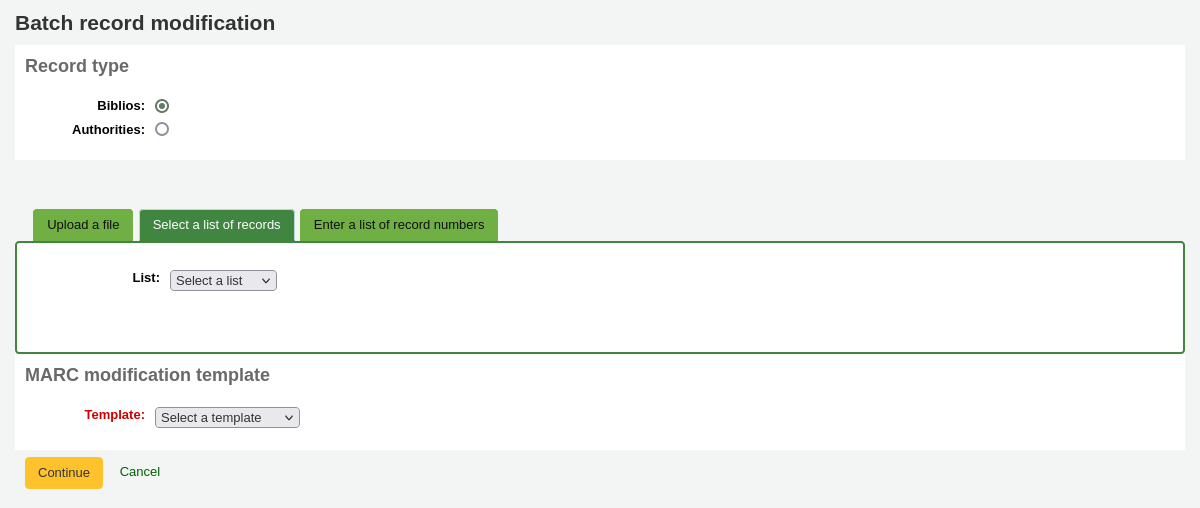
Or enter the numbers (one per line) in the box provided.
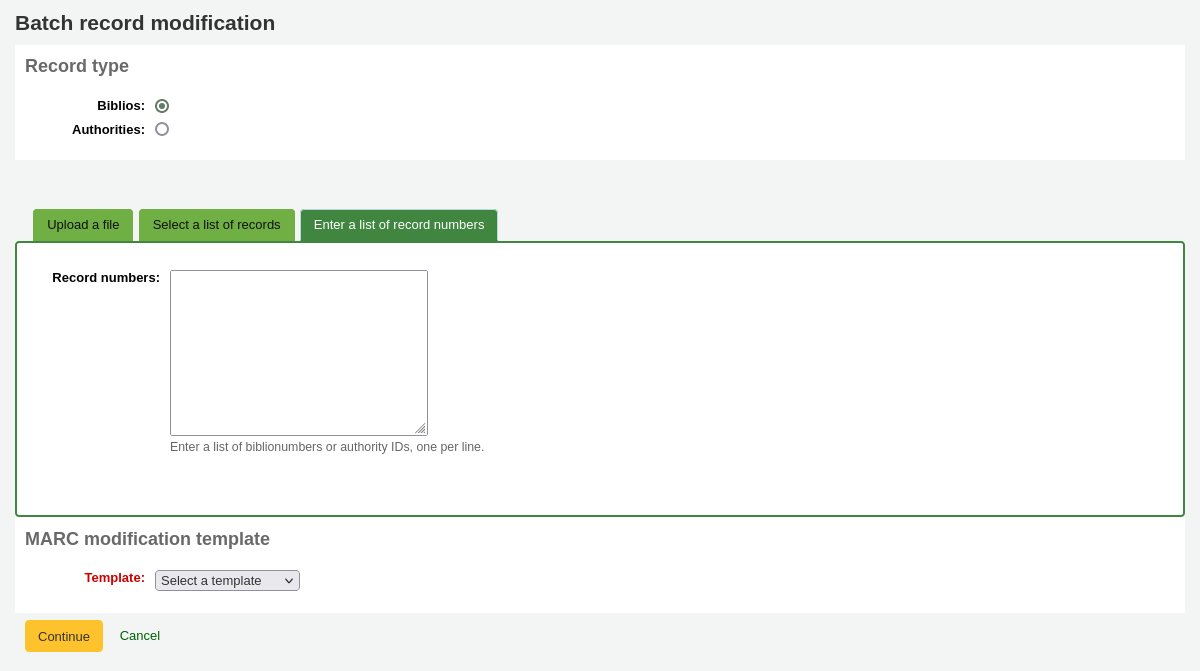
MARC modification template: finally choose the MARC modification template to use to edit these records.
Once you’ve entered your criteria click 『Continue』

You will be presented with the list of records that will be edited. Next to each one is a checkbox so you can uncheck any records you would rather not edit at this time.
Clicking 『Preview MARC』 will allow you to see what edits will be made when you finalize the edit.
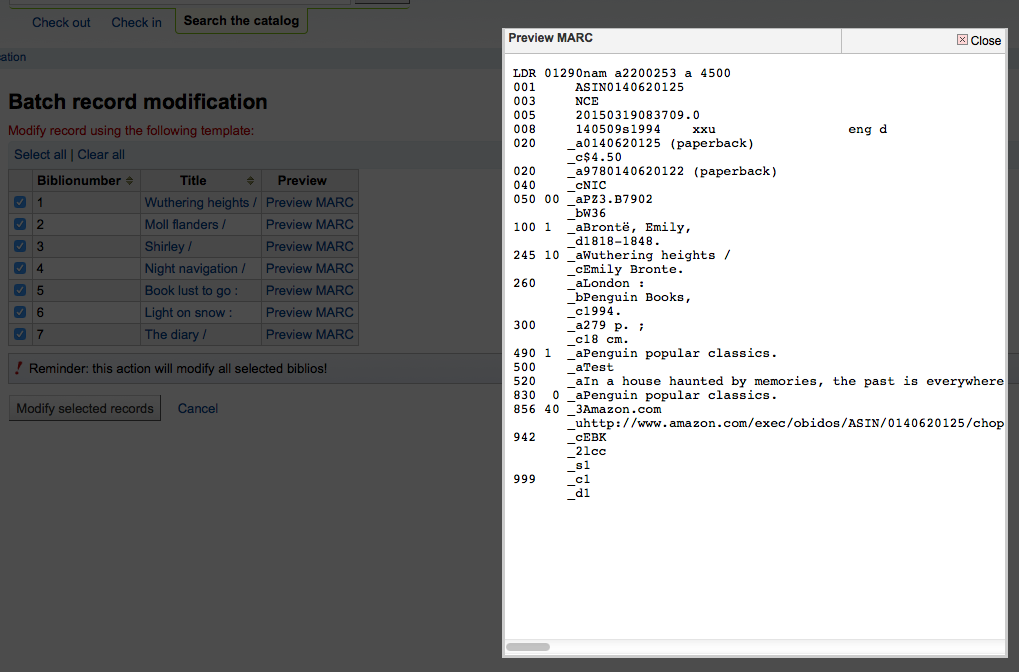
Once you’re sure everything is the way you want you can click the 『Modify selected records』 button and your records will be modified.
MARC modification templates
Get there: More > Cataloging > Batch editing > MARC modification templates
The MARC modification templates system gives Koha users the power to make alterations to MARC records automatically while staging MARC records for import or making batch record modifications.
This tool is useful for altering MARC records from various vendors or sources. The system essentially allows one to create a basic script using actions to copy, move, add, update and delete fields.
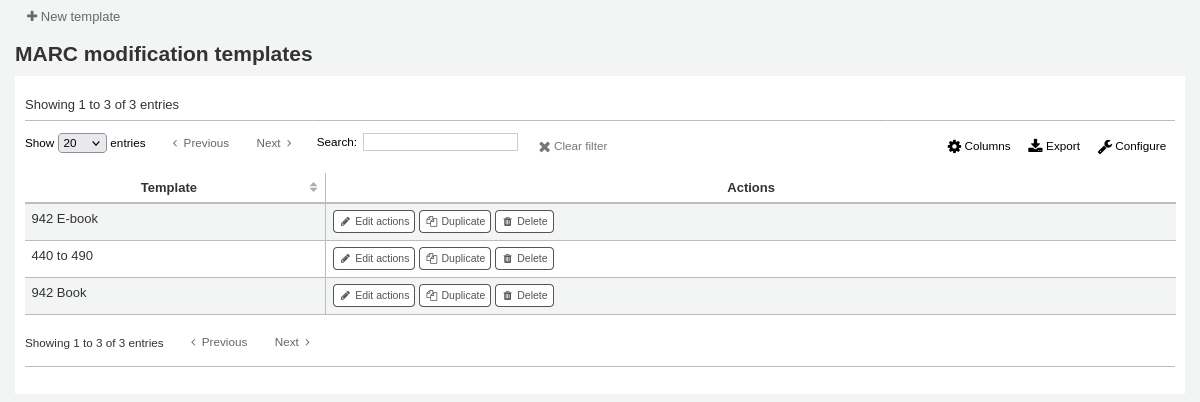
Click on 『New template』 (a template can be made up of one or more actions), enter a name and click 『Submit』.
Optionally, you can copy an existing template by choosing the template to copy in the 『Duplicate a template』 drop-down menu.

Next, you can add actions to the template. Click on 『New action』.
A 『Add a new action』 box will appear that you can use to specify what exactly you want to do.
For example if you’re loading in a batch of files from your EBook vendor you might want to add the biblio item type of EBOOK to 942$c.

Choose 『Add new』
Enter the field 942 and subfield c
Enter the value of 『EBOOK』 (or whatever your ebook item type code is)
Provide a description so you can identify this action later
Click 『Add action』
備註
If you wish to update the values in an existing field choose the option 『Update existing or add new』. This will update existing values where found and add a new field if one doesn’t exist.
Each action can also have an optional condition to check the value or existence of another field. For example you might want to add the call number to the item record if it’s not already there.
備註
Editing item fields only works when using the template when staging records. Once records are in Koha, the item is 『separated』 from the record and can only be edited using the batch item modification tool

Choose 『Copy』
Decide if you want to copy the first occurrence or all occurrence of the field
Enter the field 090 (or other bibliographic call number field) and subfield a to copy
Enter the 952 field and o subfield to copy to
Choose 『if』
Enter the 952 field and o subfield
Choose 「doesn’t exist」
Provide a description so you can identify this action later
Click 『Add action』
The move, copy, and copy and replace actions support regular expressions, which can be used to automatically modify field values during the copy or move. An example would be to strip out the 『$』 character in field 020$c.

Choose 『Copy and replace』
Decide if you want to copy the first occurrence or all occurrences of the field
Enter the field 020 and subfield c to copy
Enter the 020 field and c subfield to copy to
Check the 『RegEx』 box and enter your regular expression (in this case s/\$// )
Choose 『if』
Enter the 020 field and c subfield
Choose 「matches」
Check the 『RegEx』 box and enter your regular expression (in this case m/^\$/ )
Provide a description so you can identify this action later
Click 『Add action』
備註
The value for an update can include variables that change each time the template is used. Currently, the system supports two variables, __BRANCHCODE__ which is replaced with the branchcode of the library currently using the template, and __CURRENTDATE__ which is replaced with the current date in ISO format ( YYYY-MM-DD ).
You could also use regular expressions to add your library’s proxy URL in front of links in your MARC record.

Choose 『Copy and replace』
Decide if you want to copy the first occurrence or all occurrences of the field
Enter the field 856 and subfield u to copy
Enter the 856 field and u subfield to copy to
Check the 『RegEx』 box and enter your regular expression (in this case s/^/PROXY_URL/ )
Provide a description so you can identify this action later
Click 『Add action』
When choosing between 『Copy』 and 『Copy and replace』 keep the following example in mind:
245 _aThe art of computer programming _cDonald E. Knuth.
300 _aA_exists _bB_exists
If we apply action (a) Copy the whole field 245 to 300, we get:
245 _aThe art of computer programming _cDonald E. Knuth.
300 _aA_exists _bB_exists
300 _aThe art of computer programming _cDonald E. Knuth.
If we apply action (b) Copy the subfield 245$a to 300$a, we get:
245 _aThe art of computer programming _cDonald E. Knuth.
300 _aThe art of computer programming _bB_exists
Once your actions are saved you can view them at the top of the screen. Actions can be moved around using the arrows to the left of them.

Actions will be done in the order they appear. Depending on your actions the order may be very important. For example you don’t want to delete a field before you copy it to another field. You can use the arrows to move actions up or down the list
The up arrow will move the action up one position
The up arrow with a line at the top will move the action to the first position
The down arrow with a line at the bottom will move the action to the last position
The down arrow will move the action down one position
Once your template is saved you will be able to pick it when using the Stage MARC records for import tool or when using the batch record modification tool.

Duplicating records
Sometimes a copy of the record you need to catalog can’t be found via Z39.50. In these cases you can create a duplicate of similar record and edit the necessary pieces to create a new record. To duplicate an existing record click 『Edit as new (duplicate)』 from the 『Edit』 menu on the bibliographic record.

This will open a new MARC record with the fields filled in with the values from the original bibliographic record.
Edit as needed and save.
備註
This will not change the original record.
Attaching files to records
藉由幾個設定可以上傳檔案給 Koha。
需要系統管理員設定 『upload_path』 變數指定檔案的儲存地
You can see if your upload path is set correctly by visiting About Koha > System information. If there is an error you will see it there.

You will want to be sure that your OPACBaseURL system preference is set appropriately
You will want to add the upload.pl plugin to the 856$u subfield in one (or multiple) of your frameworks
設定後就可以正常編目。在 856$u 旁可看到外掛圖示點選後可開啟上傳或搜尋視窗
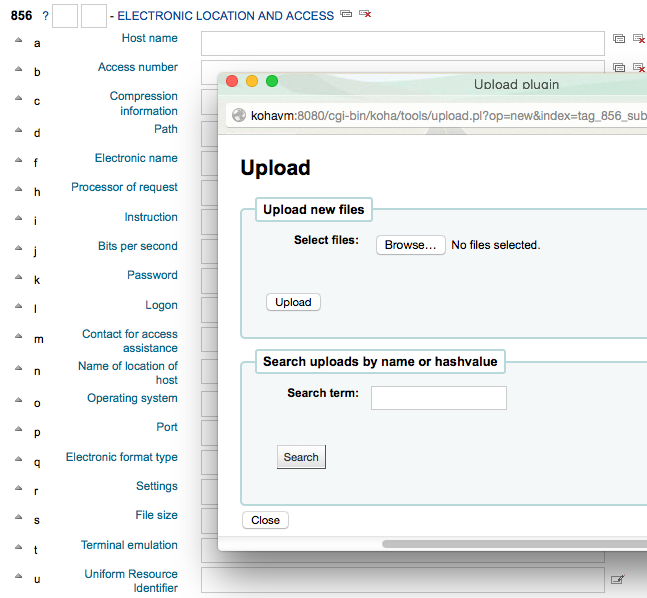
從這個選單點選瀏覽找到檔案並上傳,或可搜尋以搜尋盒上傳的檔案。從搜尋結果選擇上傳的檔案。

選定的檔案將出現在 MARC 記錄內及詳細顯示的連結。

說明
If the file is a PDF, it will be opened directly in the user’s browser whereas if the file is an image or another type of file, the user will be prompted to download it.
Adding cover images
Several free and paying services are integrated with Koha to provide cover images for your catalog, such as Amazon, Baker and Taylor, Google books, NovelList Select, Open Library, and Syndetics. Check the corresponding system preferences to enable the service of your choice.
There are other options such as a Coce image cache server, or having remote cover images with custom URLs.
警告
If you enable more than one service, you will have multiple cover images in your records.
Most of these services use the ISBN of the record to fetch the cover image from the provider.
Finally, you can upload your own images to your records with what is called Local cover images in Koha.
警告
Make sure you are respecting copyright when using images.
Adding a single local cover image
Before adding local cover images, make sure either the OPACLocalCoverImages system preference and/or the LocalCoverImages system preference is set to 『Show』.
To upload local cover images staff need the upload_local_cover_images permission.
In a bibliographic record, choose 『Upload image』 from the edit menu to add your cover image.

Drag and drop the image to the area, or click on 『Drop files here or click to select a file』 a select the image file on your computer.

警告
Koha does not have a maximum file size limit for this tool, but the web-server (such as Apache) may limit the maximum size of uploads (ask your system administrator).
If the AllowMultipleCovers system preference is set to 『Allow』, you will have the choice to replace existing covers or not. If the system preference is set to 「Don’t allow」, the image will replace existing cover images for this record.
備註
Where there are multiple images for a record they will display left to right (then top to bottom, depending on screen size) in the order they were uploaded. The image on the left (the first one uploaded) is used as a thumbnail cover in search results and on the details page. There is no way to reorder cover images uploaded in this way, so be sure to upload them in the order you’d like them to appear.
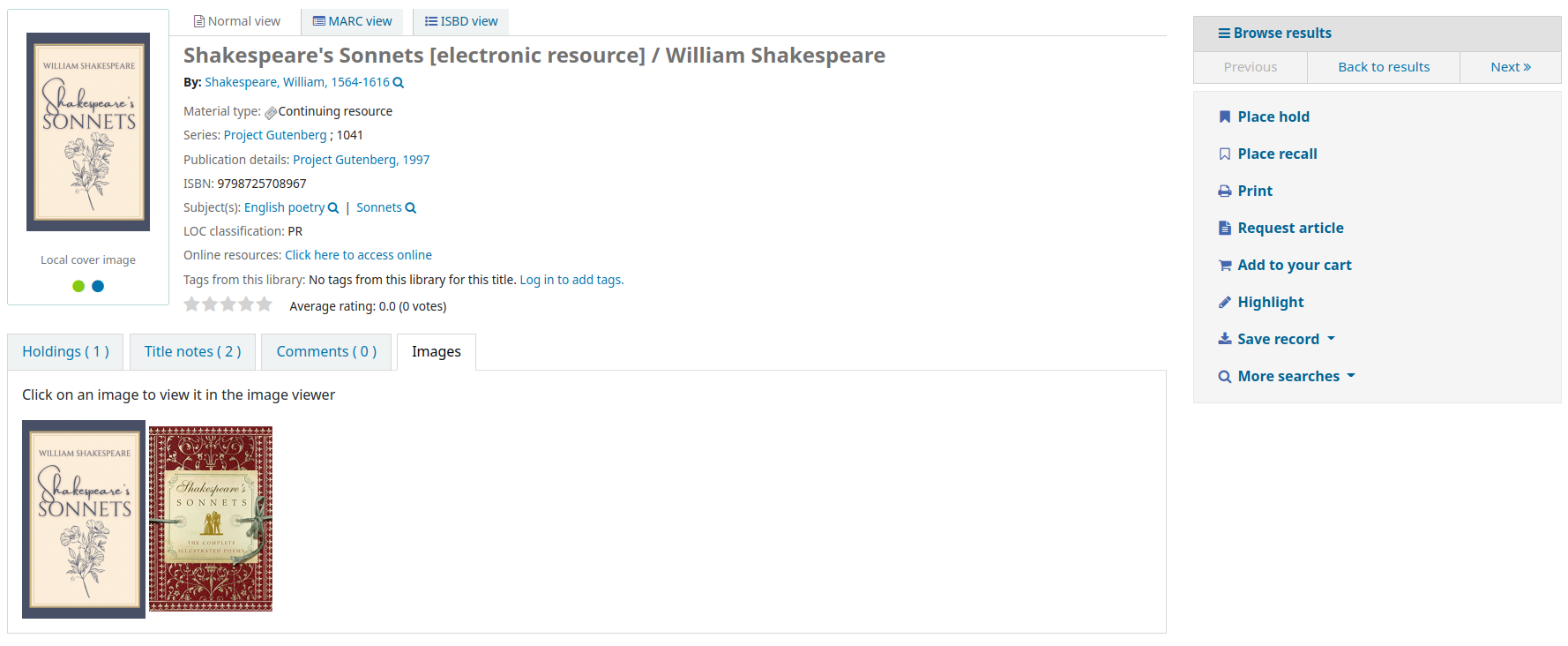
Click 『Process images』
Alternatively, you can access the cover image upload tool itself in Cataloging > Tools > Upload local cover image. You will then need to specify the biblionumber of the record for which you are uploading the image.

備註
The biblionumber or bibliographic record number is not the same as the barcode, it is the system-generated number assigned by Koha to each bibliographic record. You can find the biblionumber in various place, namely:
At the end of the URL in the address bar of your browser when on the record details page. The URL will look something like
In the MARC tab of the record details page in the staff interface
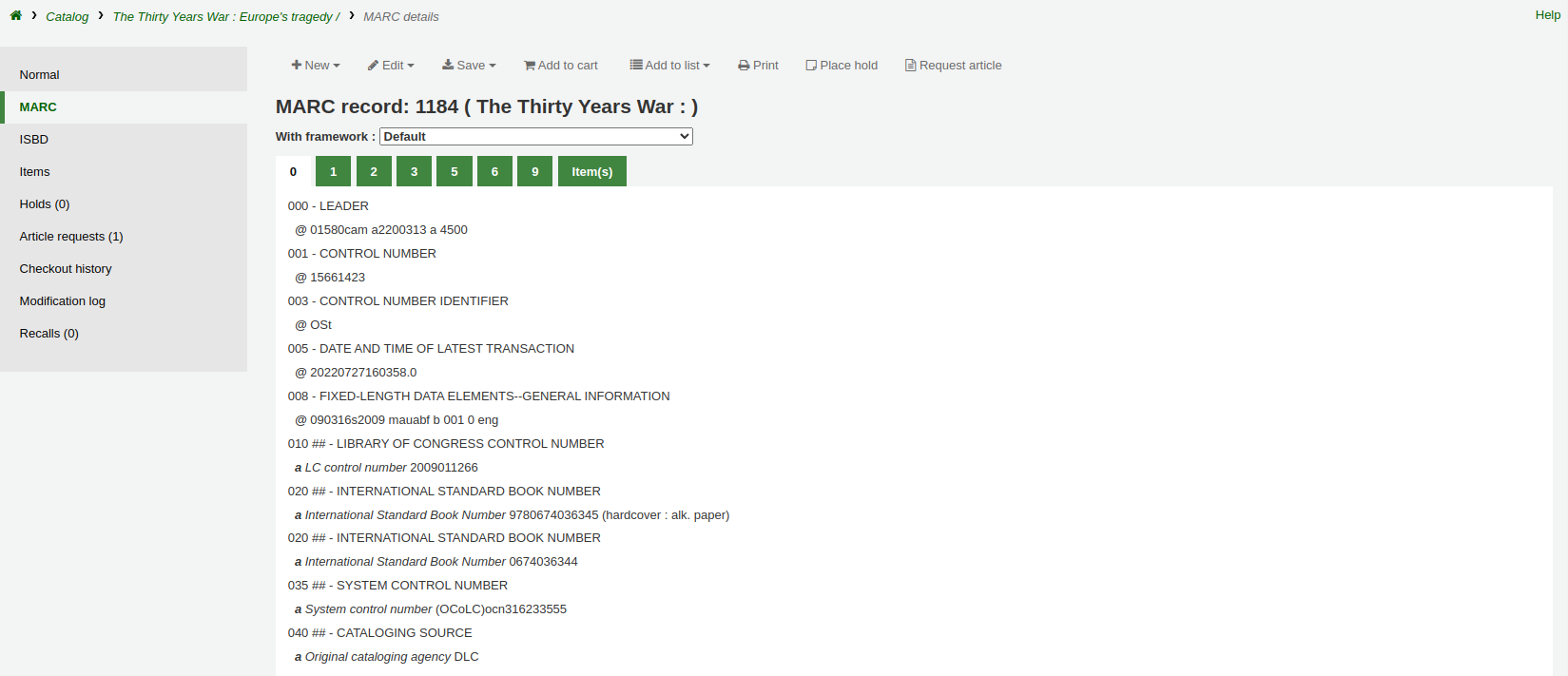
Adding a batch of cover images
The tool to upload cover images also allows batches of images to be uploaded in a ZIP file.
To upload a batch of images:
Create a folder with the images to upload in it
Create a text file (*.txt) named either datalink.txt or idlink.txt listing the biblionumber followed by the image name for each image, one per line. For example:
- ::
506,2gentlemen.jpeg 779,asyoulikeit.jpg 138,selected-poems-oscar-wilde.jpg 41,sonnets.jpg 499,3rdhenry6.jpg 787,macbeth.jpg 102,sonnets2.jpg
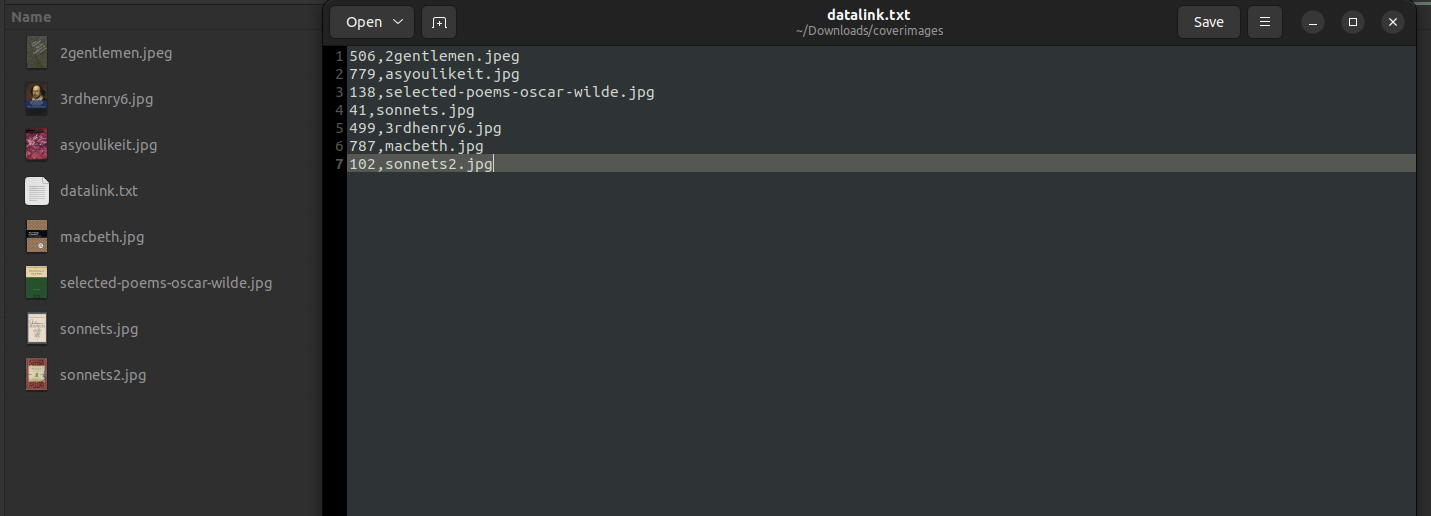
警告
Make sure there are no extra lines or characters in the text file.
Create a ZIP file that includes all the images to upload and the text file
In Koha’s staff interface, go to the upload cover image tool in Cataloging > Tools > Upload local cover image, and drag and drop or select the ZIP file from your computer
The file type 『ZIP file』 should be selected
If the AllowMultipleCovers system preference is set to 『Allow』, you will have the choice to replace existing covers or not. If the system preference is set to 「Don’t allow」, the image will replace existing cover images for this record.
Click 『Process images』
You are presented with a summary of the upload

備註
The source image is used to generate a 140 x 200 px thumbnail image and a 600 x 800 px full-size image. The original sized image uploaded is not kept by Koha.
In the staff interface, the cover images appear in the search results, in the record details page on the right of the title, and in the 『Images』 tab in the holdings table at the bottom.
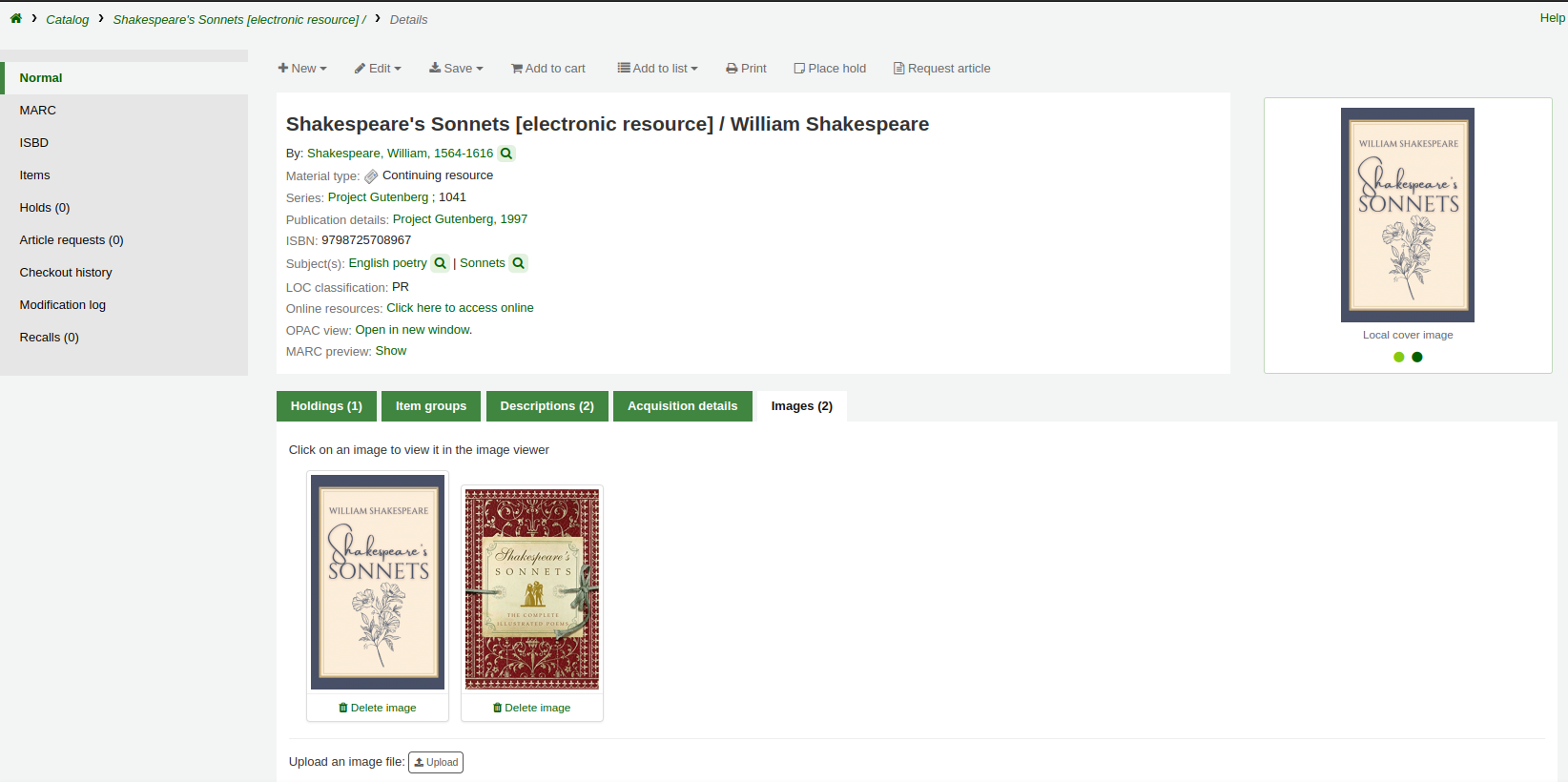
In the OPAC, the cover images appear in the search results, in the record details page on the left of the title, and in the 『Images』 tab in the holdings table at the bottom.

Deleting a local cover image
To remove a cover image, you need the upload_local_cover_images permission.
Click 『Delete image』 below the image in the 『Images』 tab in the staff interface.

Merging records
To merge bibliographic records together,
Perform a search in the catalog to find the records that need to be merged.
Check the boxes next to the duplicates to select them.
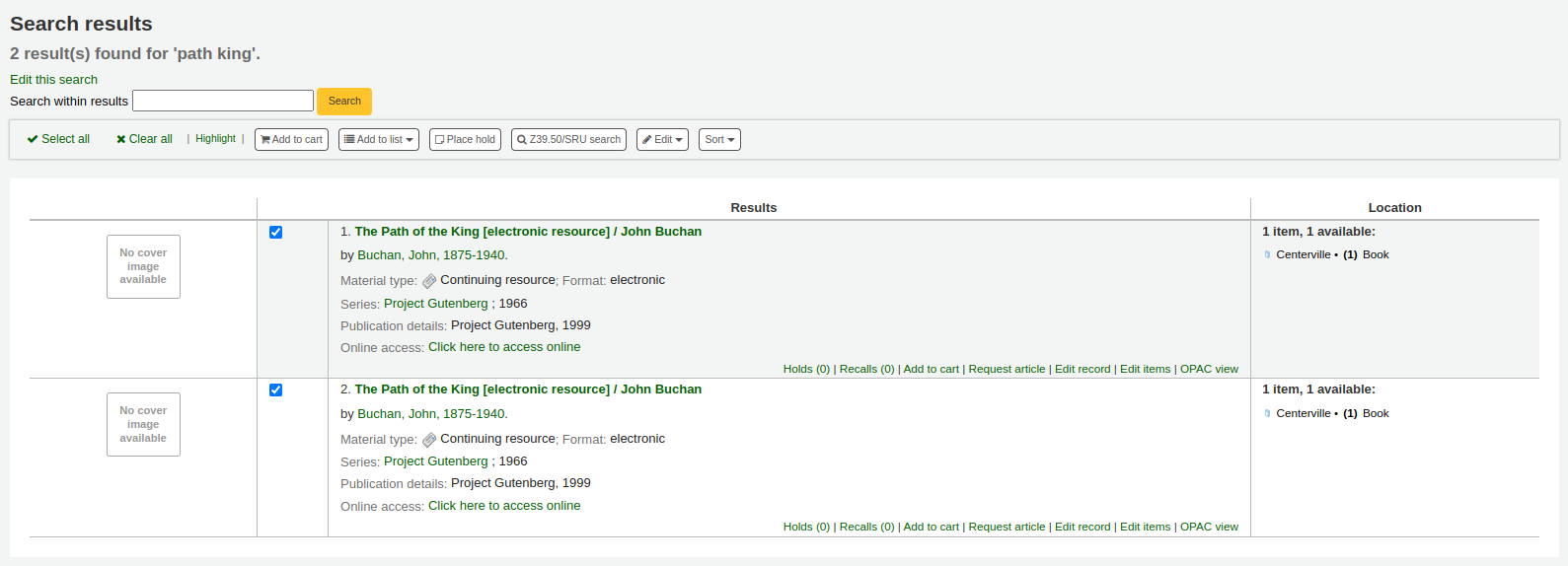
Click 「Edit」 and choose the 「Merge records」 option
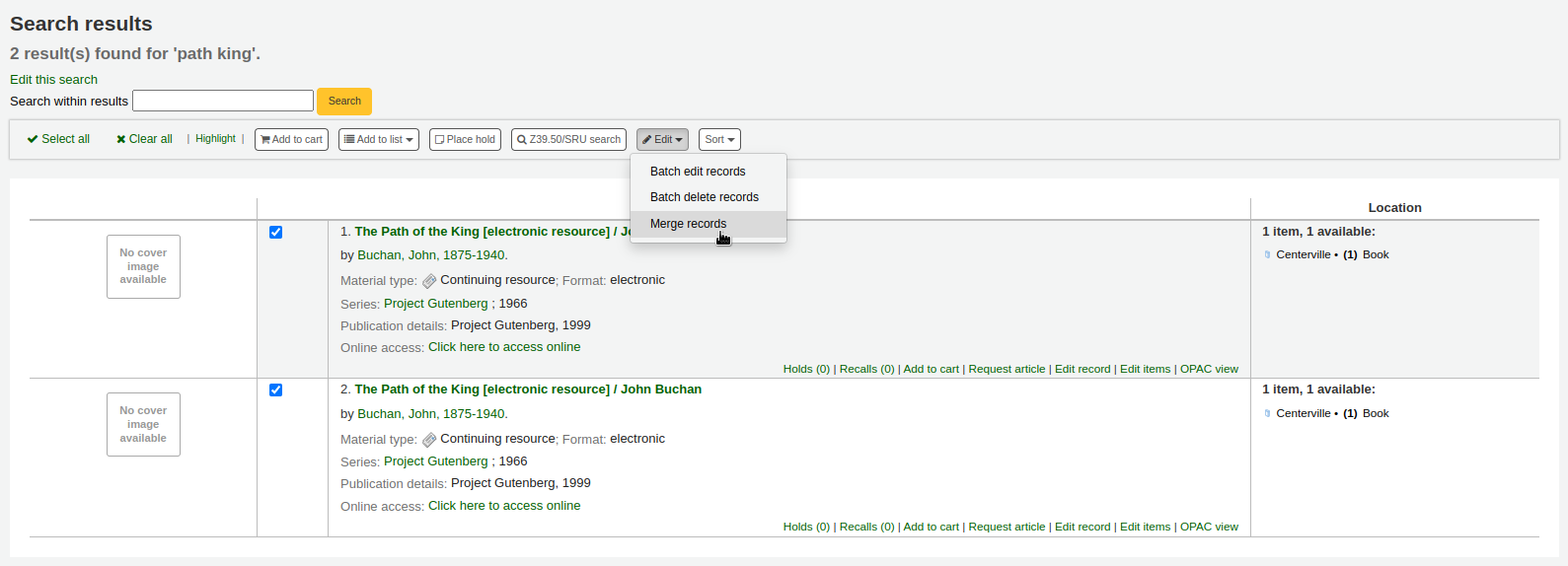
備註
Alternatively, you can go through the cataloging module to merge bibliographic records.
After searching for the records in the cataloging search and selecting the records to be merged, click the 『Merge selected』 button at the top of the list.

Choose which record to keep as the primary record, the other records will be deleted after the merge

Choose which framework to use for the newly merged record
You will be presented with the MARC for all of the records, each accessible by a tab labeled with the biblionumber for this record. By default the entire first record will be selected.
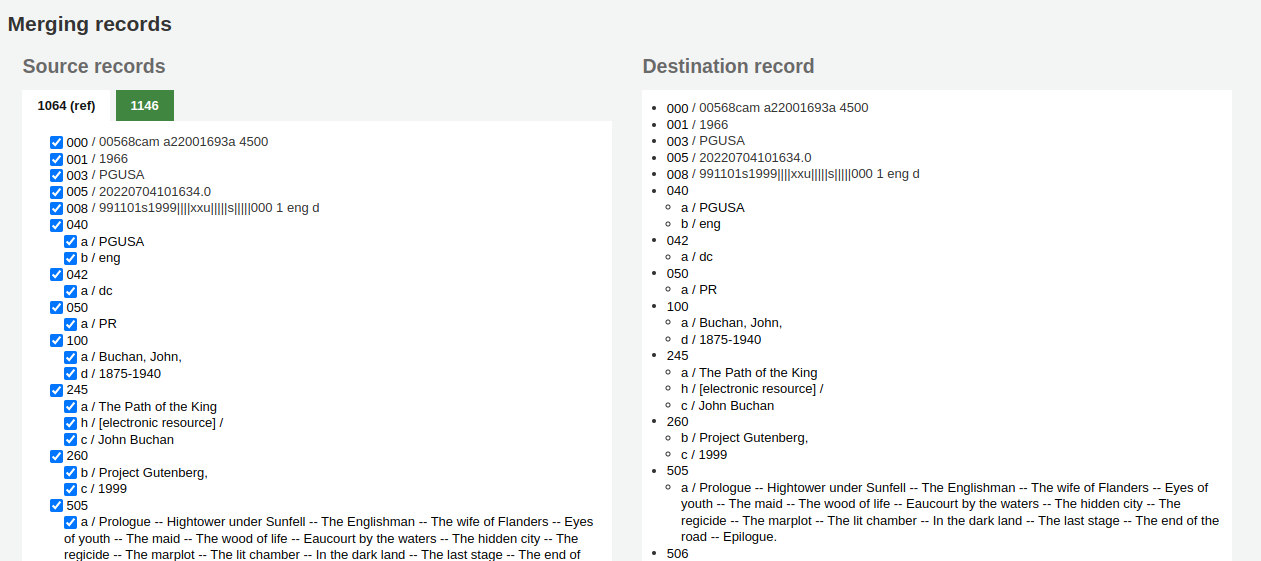
Uncheck the fields you don’t want in the final (destination) record from each source records
Check the fields you want to add in the final (destination) record
備註
Should you try to add a field that is not repeatable two times (like choosing the 245 field from both records) you will be presented with an error

備註
If mandatory fields are missing in the destination record, Koha will not merge the records. You must select a value for mandatory fields.
If important fields are missing in the destination record, Koha will warn you, but will still merge the records.
記錄之下可鍵入待合併的欄位。藉以控制在合併確認頁面出現的欄位:

未鍵入資料則出現確認書目號的訊息

If you enter fields you will see those on the confirmation page.

備註
You can set defaults for this report with the MergeReportFields system preference.
Once you have completed your selections click the 『merge』 button.
The primary record will now contain the data you chose for it, as well as all of the items and acquisition information from both bibliographic records, and the second record will be deleted.
Merging bibliographic records with lists
Another way to merge together duplicate bibliographic records is to add them to a list and use the merge tool from there.
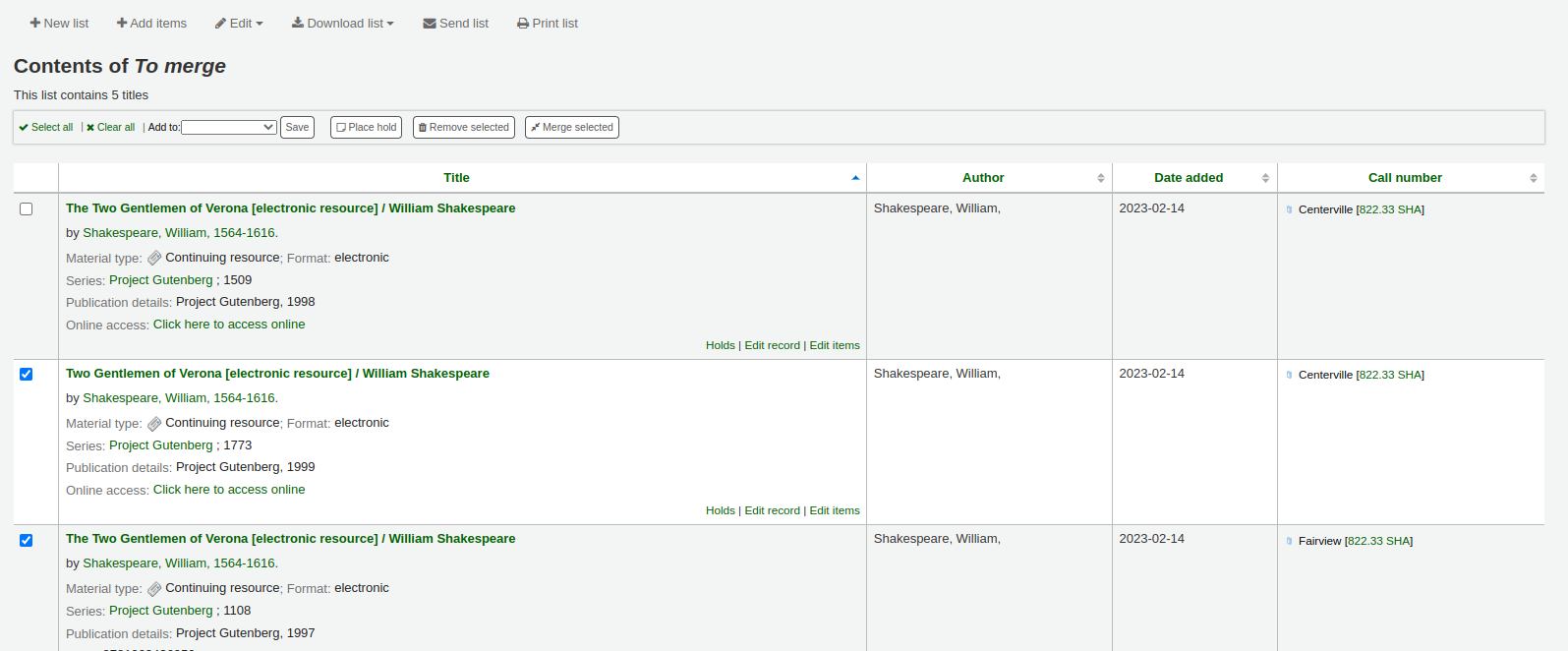
Go to Lists and click on the list title to view the list
Select the records to be merged
Click the 『Merge selected』 button at the top of the list
Once you have selected the records to merge together the process is the same as merging via cataloging.
Deleting records
To delete a bibliographic record, click the 『Edit』 button and choose 『Delete record』.
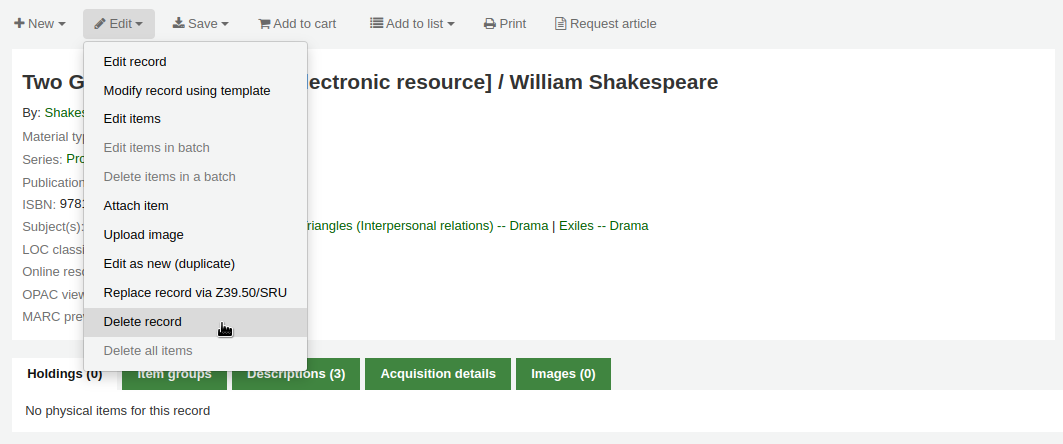
Bibliographic records can only be deleted once all items have been deleted. If you try to delete a bibliographic record with items still attached you will see that the delete option is grayed out. (See the Deleting items section of this manual to learn how to delete items.)
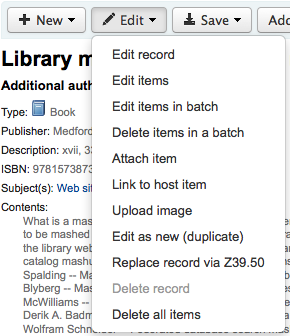
Batch deleting records
Get there: More > Cataloging > Batch editing > Batch record deletion
This tool will take a batch of record numbers for either bibliographic records or authority records and delete all those records and any items attached to them in a batch.
First, you need to tell the tool if you’re deleting bibliographic or authority records.
Next, you can:
load a file with biblionumbers or authids;
use a list;
or enter the list of numbers in the box provided.
Once you submit the form you will be presented with a summary of the records you are trying to delete.
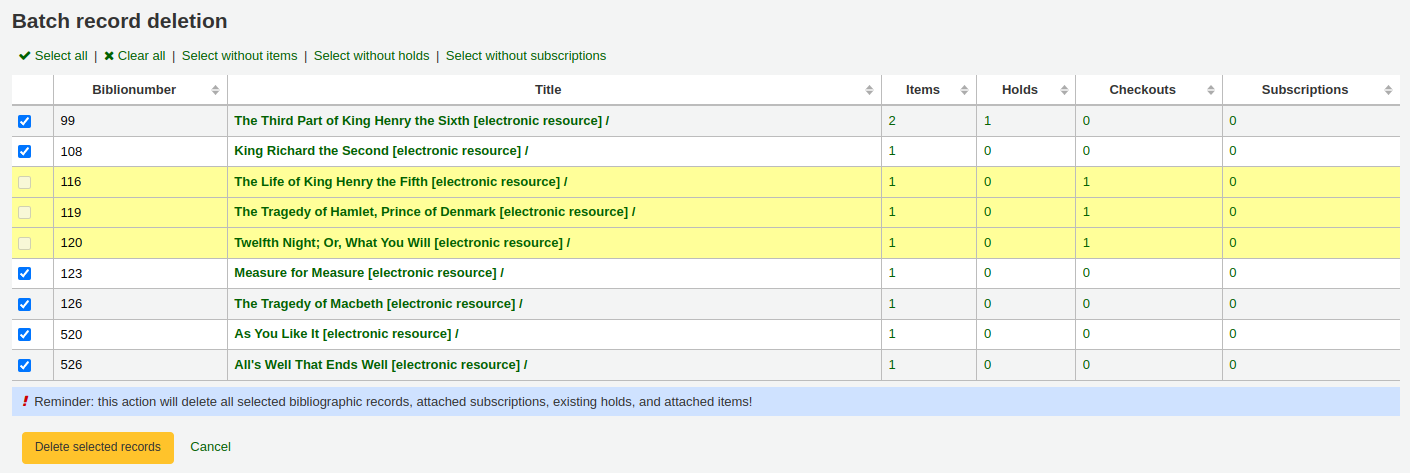
If a record you want to delete can’t be deleted, it will be highlighted.
Check the records you want to delete and click the 『Delete selected records』 button to finish the process.
You can also use the links at the top of the table to select only the records without items, holds, or subscriptions.
Catalog concerns
Reporting concerns about bibliographic records
If the CatalogConcerns system preference is enabled, staff will be able to report concerns regarding specific bibliographic records.
To report a new concern,
In the bibliographic record’s detail page, click the 『New』 button and choose 『New catalog concern』.
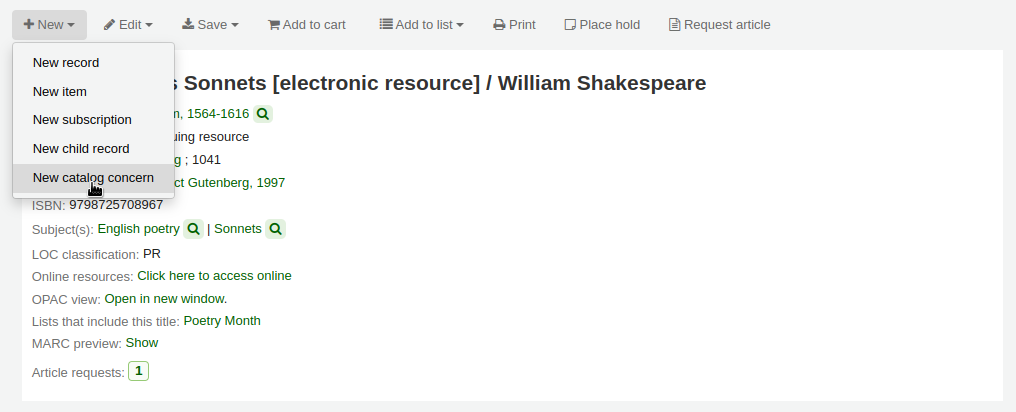
Fill in the concern form.
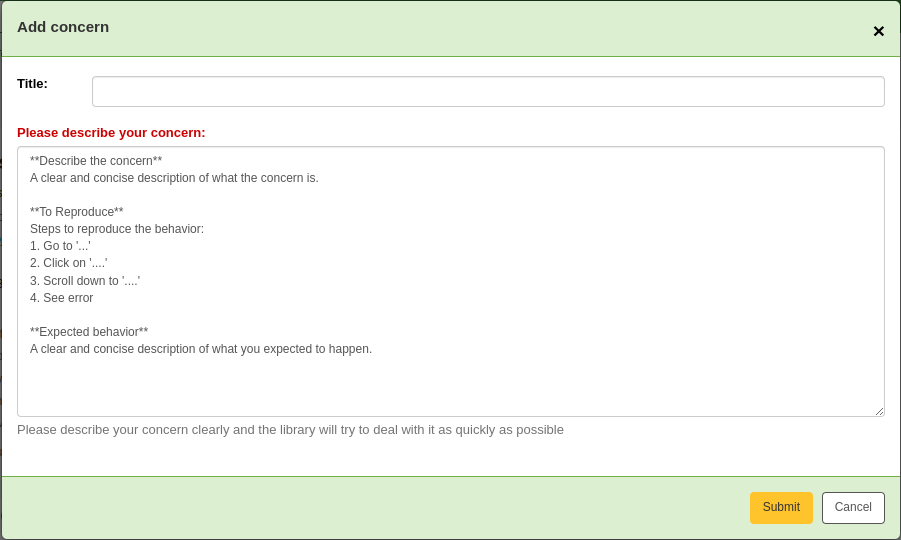
Title: enter a title describing succinctly the problem.
Please describe your concern: enter details about the problem, being the more descriptive possible so that the staff member who receives this is able to replicate and see the problem.
An example of what is expected in the description is provided in the field:
**Describe the concern** A clear and concise description of what the concern is. **To Reproduce** Steps to reproduce the behavior: 1. Go to '...' 2. Click on '....' 3. Scroll down to '....' 4. See error **Expected behavior** A clear and concise description of what you expected to happen.
備註
This text is customizable in the HTML customizations tool, by changing the 『CatalogConcernTemplate』 entry.
The text at the bottom of the form (「Please describe your concern clearly…」) is also customizable in the HTML customizations tool, by changing the 『CatalogConcernHelp』 entry.
Click 『Submit』.
This will send an email to the cataloging team to notify them that a new concern has been created. The email will be sent to the email address in the CatalogerEmails system preference. The email sent is the TICKET_NOTIFY notice, which can be customized in the Notices and slips tool.
An email will also be sent to the reporter to notify them that the concern has been received. The email sent is the TICKET_ACKNOWLEDGE notice, which can be customized in the Notices and slips tool.
Concerns reported about this record are visible in the 『Concerns』 tab.

All concern tickets will be visible in the catalog concerns report.
Newly opened concern reports will also appear in the notification section at the bottom of the staff interface main page.

Managing catalog concerns
When staff or patrons report concerns about bibliographic records, all concerns will be accessible through the catalog concerns report.
Get there: More > Cataloging > Reports > Catalog concerns
備註
This report will only be visible if either the CatalogConcerns system preference or the OpacCatalogConcerns system preference are enabled.
備註
To access this page, staff members need the edit_catalogue permission.
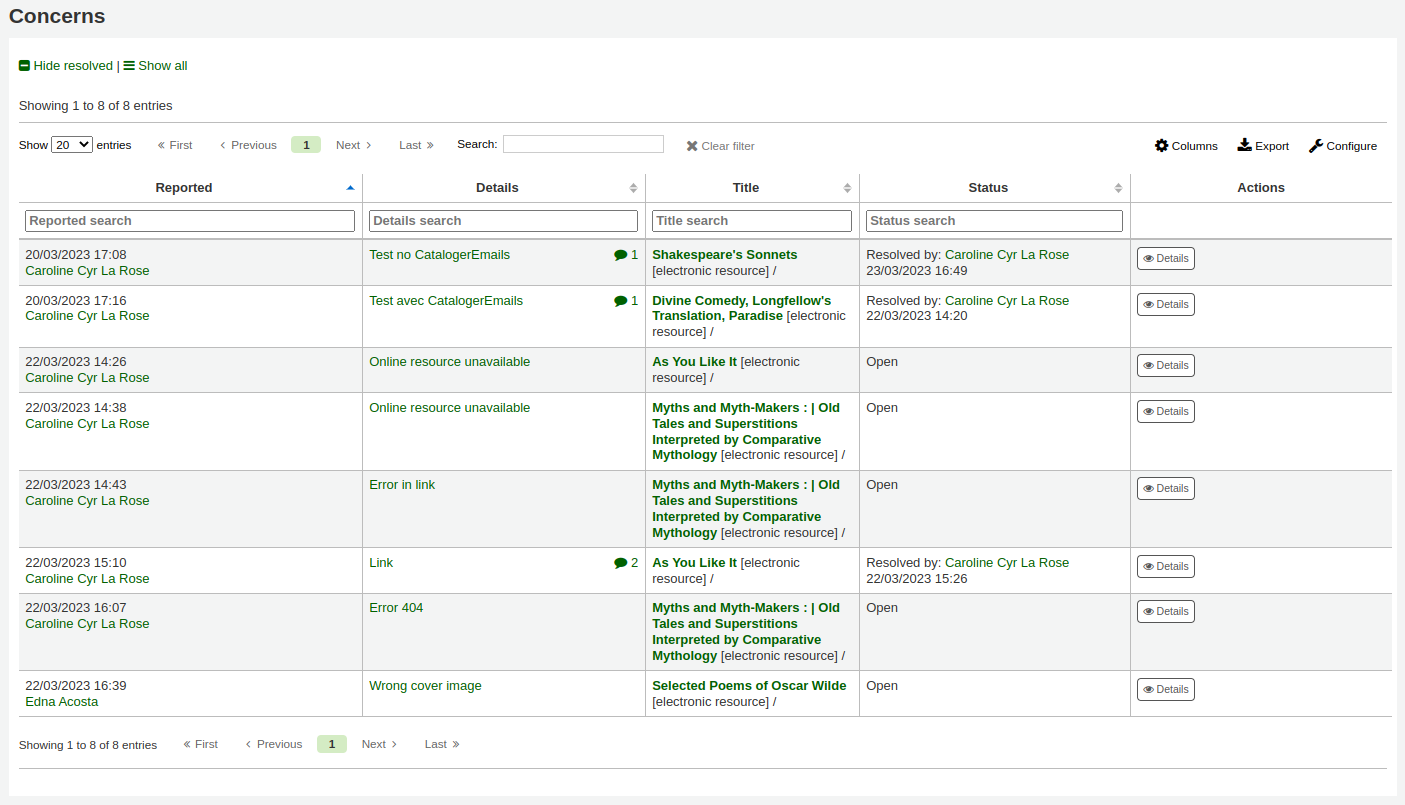
From this report, you can see all concerns, ordered by date, with the name of the reporter, the details of the concern, the title of the bibliographic record, the status (open or resolved), and if resolved, the date and name of the staff member who managed it.
備註
By default, all concerns are shown. If needed, you can click on 『Hide resolved』 at the top of the page to hide concerns that have already been resolved.
Click 『Show all』 to return to the full table.
To see the details of a concern, either click the text in the 『Details』 column, or click the 『Details』 button in the 『Actions』 column.
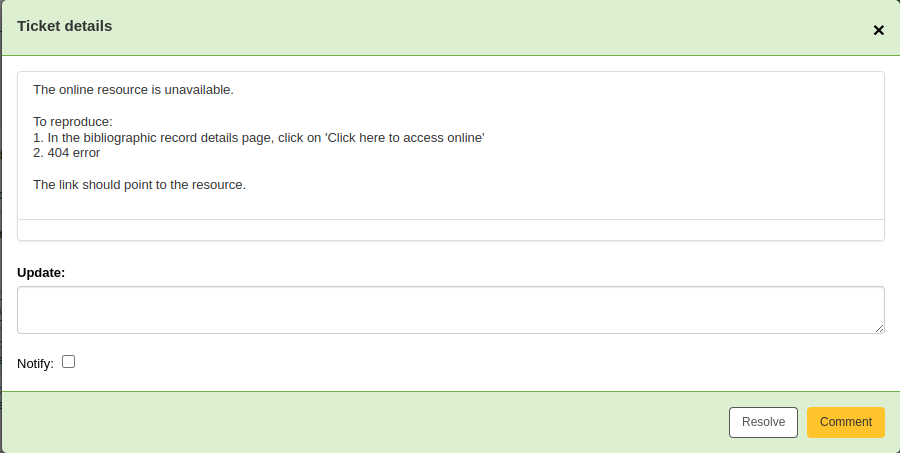
From this view, you can enter a comment in the 『Update』 field.
To simply add the comment as an update, click the 『Comment』 button.
If this concern is resolved, click the 『Resolve』 button.
If 『Notify』 is checked, the reporter will receive an email indicating that the concern was updated. The email sent for an update is the TICKET_UPDATE notice, and the email sent when the concern is resolved is the TICKET_RESOLVE notice, both of which can be customized in the Notices and slips tool.
Item records
在 Koha 裡,每筆書目記錄可以有多筆館藏記錄。這些館藏記錄也被稱為館藏。每個館藏包括圖書館擁有該館藏的物理資訊。
Adding items
After saving a new bibliographic record, you will be redirected to a blank item record so that you can attach an item to the bibliographic record. You can also click 『Add/Edit items』 from the cataloging search results

or you can add new item at any time by clicking 『New』 on the bibliographic record and choosing 『New item』
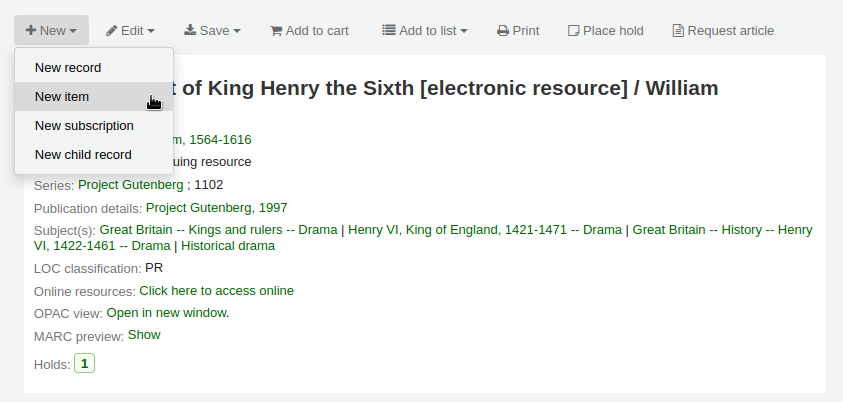
將顯示館藏編輯表單:
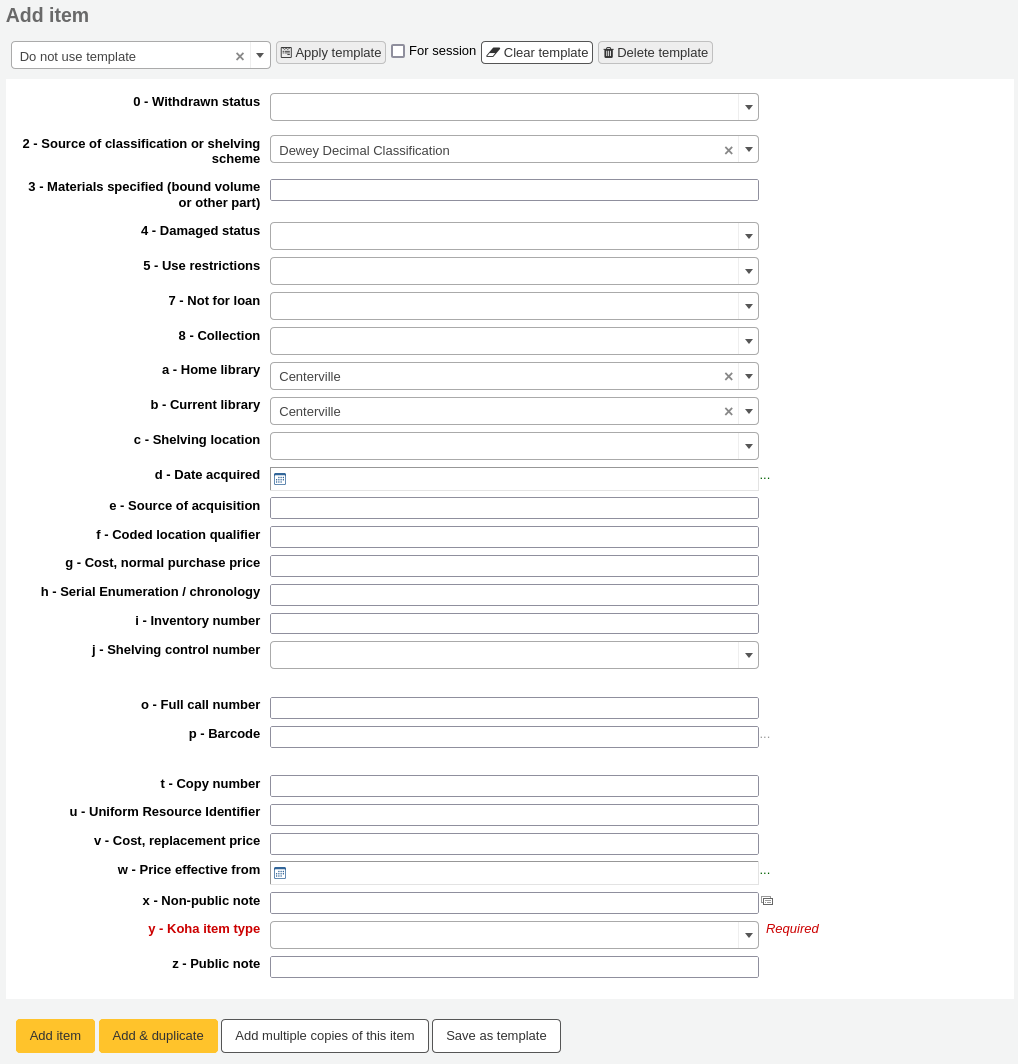
If you already have item templates, you can choose the template to apply and click 『Apply template』. This will pre-fill the item form with the template values.
若打算借出館藏,以下欄位應鍵入新的館藏:
-
If you’d like you can use the cataloguing plugin 『call number browser』 (cn_browser.pl) for this field. If it’s enabled you’ll see a … to the right of the field. When clicked that will open a call number browser window if the row is highlighted in Red then the call number is in use, if there is a thin Green line instead then the call number can be used.

-
借出的館藏被申報為 『遺失』 時,向讀者收取的費用
可以在 框架 裡,把這些欄位設為必備,就會以紅色標示為 『必備』 標籤。必須鍵入資料才能儲存它。

備註
To make item subfields required in a framework, edit the 952 field in the framework editor.
You can add a new authorized value directly from the add and edit item screen for any fields that are linked to authorized value categories such as Shelving location (subfield$c) or Collection code (subfield$8).
Start to type the authorized value description, if a match is not found you will see the option 『(Select to create)』.
Click on this option to display a pop-up window where you can create you new authorized value.
The authorized value category will be pre-populated from the field you are using, for example LOC for Shelving location, CCODE for Collection code. Take care when choosing your authorized value code. Refer to the notes on adding new authorized values for the correct format of these codes. Use the Description field for the actual value that will be displayed
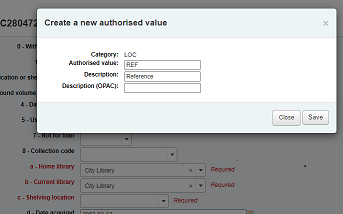
You can add authorized values in the same way from bibliographic and authority records.
備註
You must have the manage_auth_values administration permission to add authorized values from cataloguing.
Below the add form there are 3 buttons for adding the item.

『Add item』 will add just the one item
『Add & duplicate』 will add the item and fill in a new form with the same values for you to alter
『Add multiple copies of this item』 will ask how many copies and will then add that number of items adding +1 to the barcode so each barcode is unique

『Save as template』 will save this item as an item template to reuse later.
警告
Saving as template will not save the item. It will only create the template.
送出後水,新增的館藏將顯示在新增表單上

備註
You can customize the columns of this table in the 『Table settings』 section of the Administration module (table id: Items Editor).
Your items will also appear below the bibliographic details on the record details page, in the 『Holdings』 tab.

If the SpineLabelShowPrintOnBibDetails system preference is set to 『Show』, there will be a button to print a quick spine label next to each item.

按下 『啟用篩選器』 就可篩選館藏表單的內容。將在頁面上方出現一列可以鍵入篩選的內容。

Adding and using item templates
You can create item templates to share and reuse in order to easily fill out the new item form.
備註
Anyone who has the edit_items permission can create and share item templates, and delete their own templates.
However, the manage_item_editor_templates (or superlibrarian) permission is needed to manage item templates created by others.
Creating a new item template
To create an item template,
Go to add a new item
Fill out the item form with the values you want to add to the template
Instead of saving the item, click the 『Save as template』 button

Choose 『Save as new template』
Enter a template name
Choose if you want this template to be shared with all other catalogers
Click 『Save』
Updating an existing template
To edit an existing template,
Go to add a new item
Choose the template to update at the top of the form

Click 『Apply template』
Change the values as needed
Click the 『Save as template』 button.

Choose the template to update
Choose if you want this template to be shared with all other catalogers
Click 『Save』
Using a template
To use a template,
Go to add a new item
Choose the template to update at the top of the form

Click 『Apply template』
If checking 『For session』, all new items will be based on this template, unless otherwise specified
Change the values as needed
Save the item
Deleting a template
To delete a template,
Go to add a new item
Choose the template to delete at the top of the form

Click 『Delete template』
Editing items
館藏曾被多方編輯。
Clicking 『Edit』 and 『Edit items』 from the bibliographic record
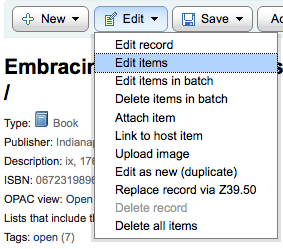
打開館藏清單後,可按下館藏左方的 『作業』 鈕,選擇 『編輯』 並開始編輯該館藏。
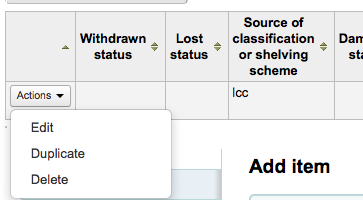
Clicking 『Edit items』 beside the item on the 『Items』 tab
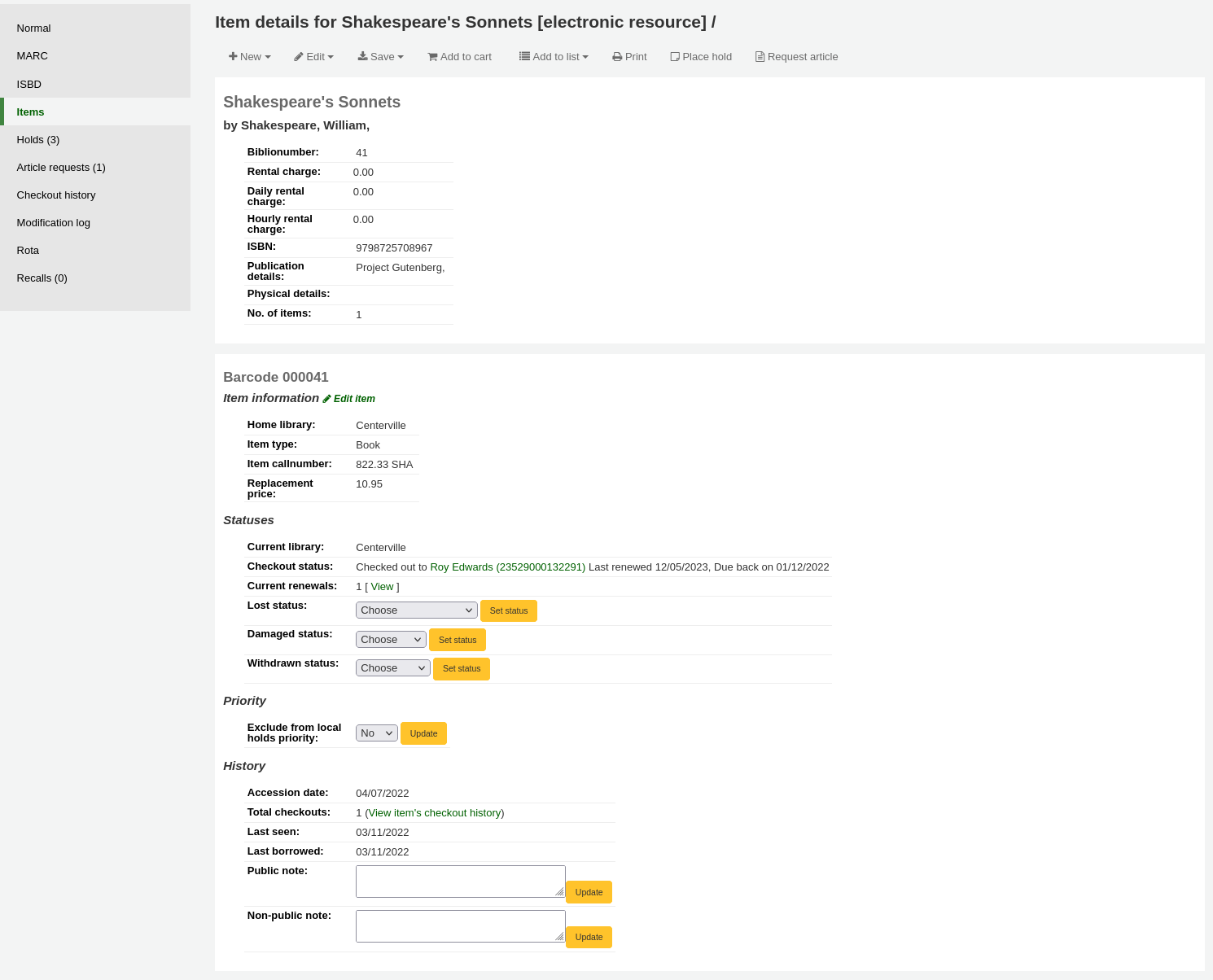
將打開館藏編輯器供編輯之用
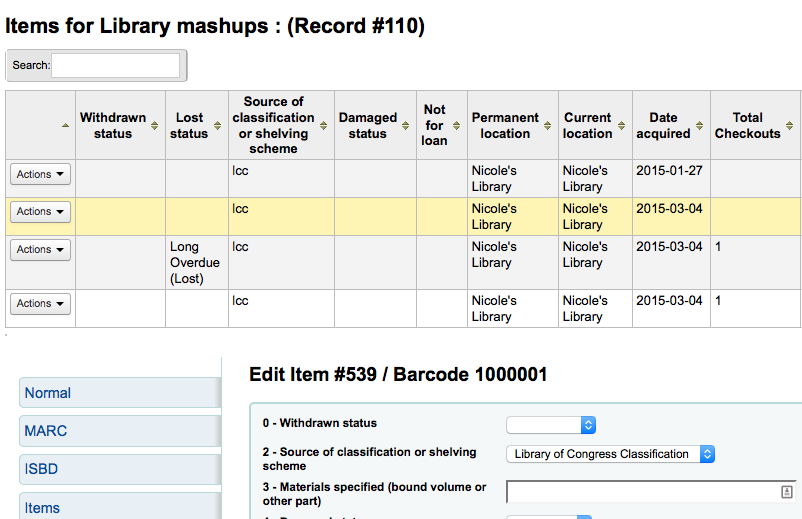
按 『編輯』 再按 『批次編輯館藏』
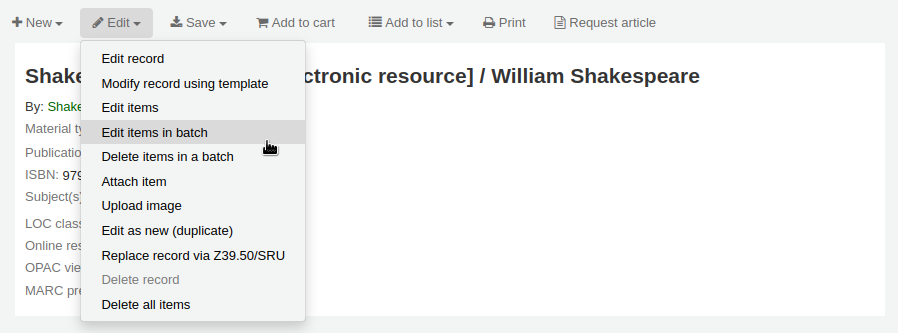
將彈出 批次修改館藏工具 編輯此筆書目記錄的所有館藏。
You can also enable StaffDetailItemSelection to have checkboxes appear to the left of each item on the detail display. You can then check off the items you would like to edit and click 『Modify selected items』 at the top of the list.
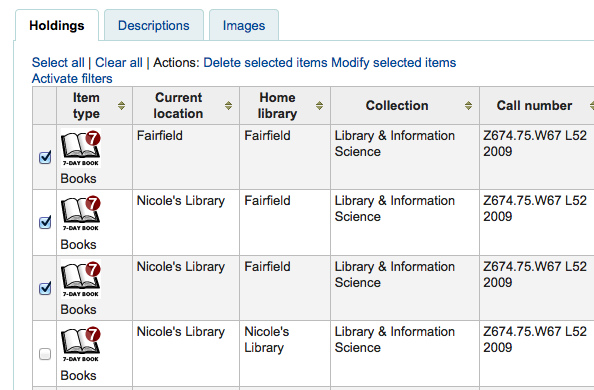
按館藏分頁內每個館藏右方的 『編輯』 鈕

館員介面的搜尋結果,也有編輯館藏的連結

Finally you can use the batch item modification tool
Quick item status updates
Circulation staff often need to change the status of an item to Lost or Damaged. This doesn’t require you to edit the entire item record. Instead, clicking on the item barcode on the checkout summary or checkin history will bring you to an item summary. You can also get to the item summary by clicking on the Items tab to the left of the bibliographic record’s detail page.

From this view, you can mark an item lost by choosing a lost status from the pull down and clicking the 『Set status』 button. Same applies to the damaged and withdrawn statuses.

Duplicating items
You can easily duplicate each item by clicking the 『Actions』 button the left of each item on the edit items screen

從這裡可選擇 『複製』 館藏把選定的館藏複製。
Batch editing items
Get there: More > Cataloging > Batch editing > Batch item modification
This tool will allow you to modify a batch of item records in Koha.
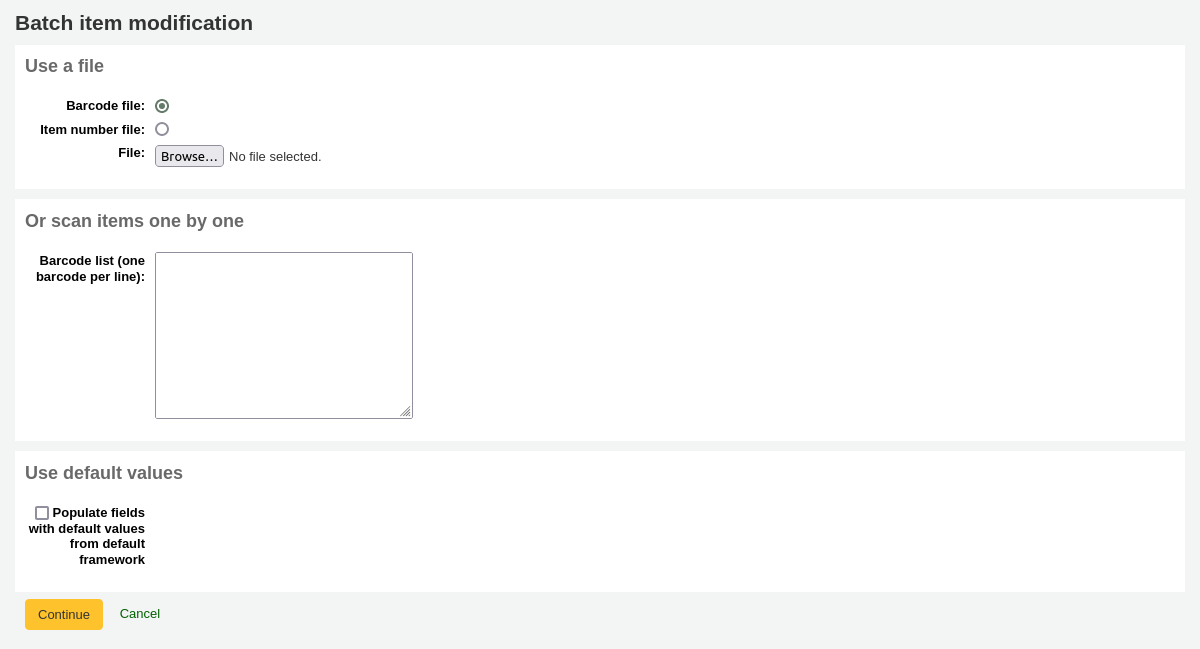
From the tool, choose to either upload a file of barcodes or itemnumbers, or scan item barcodes one by one into the box below the upload tool. You can also decide the items edited should be populated with the default values defined in the default framework.
Once the file is uploaded or the barcodes listed, click 『Continue.』

You will be presented with a summary of the items you want to modify. From here, you can uncheck the items you don’t want to modify before making changes in the form below. You can also hide columns you don’t need to see to prevent having to scroll from left to right to see the entire item table. The holds column displays a count of the current holds for the item.
備註
To uncheck all items that are currently checked out you can click the 『Clear on loan』 link at the top of the form.
Using the edit form, choose which fields to make edits to. By checking the checkbox to the right of each field you can clear the values in that field for the items you are modifying.
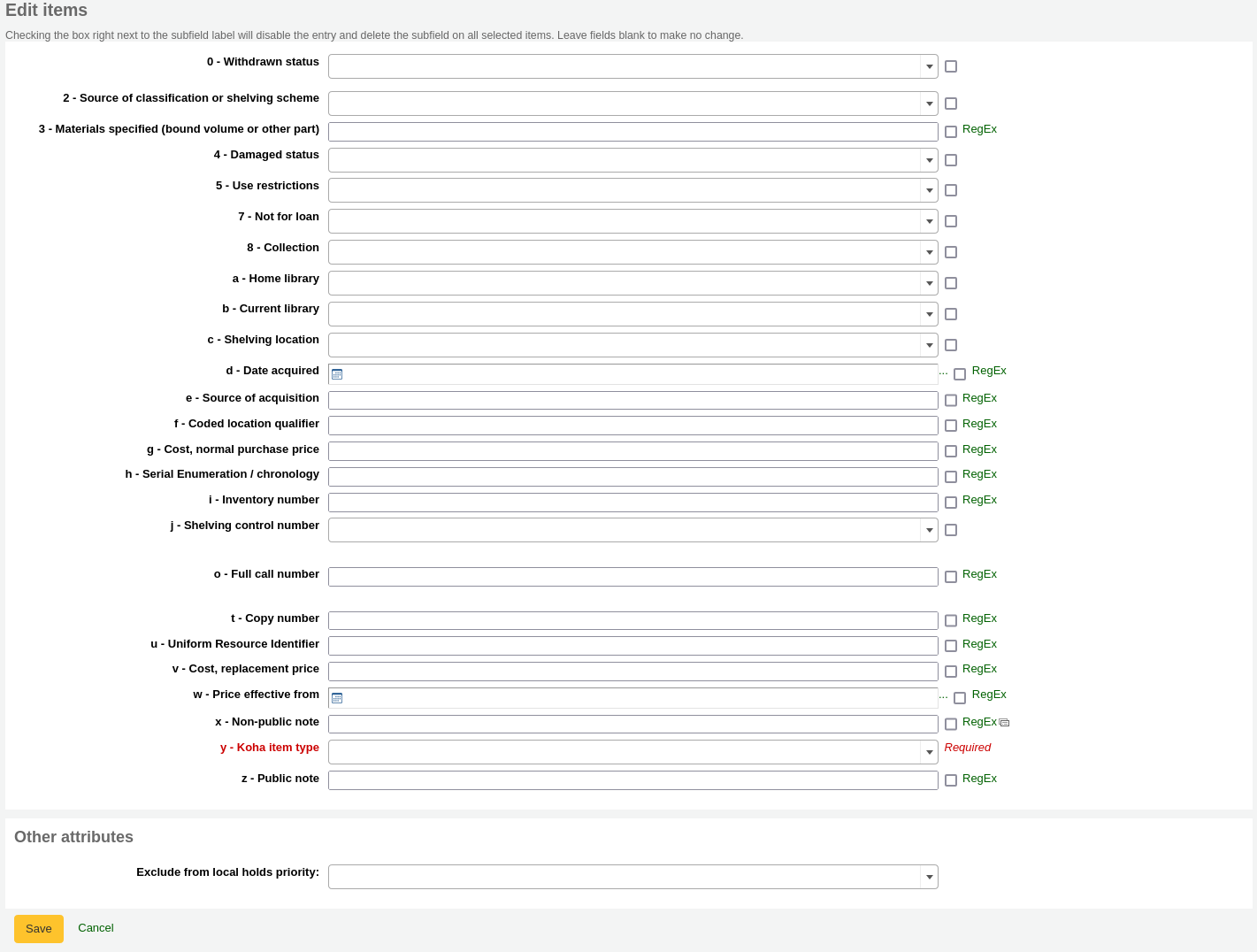
You can also click the 『RegEx』 link to change the text field to a regular expression substitution. This is used to change only a part of a text string.

Once the changes are made, the job will be enqueued in the background jobs.

To see the edited items, click on 『View detail of the enqueued job』.
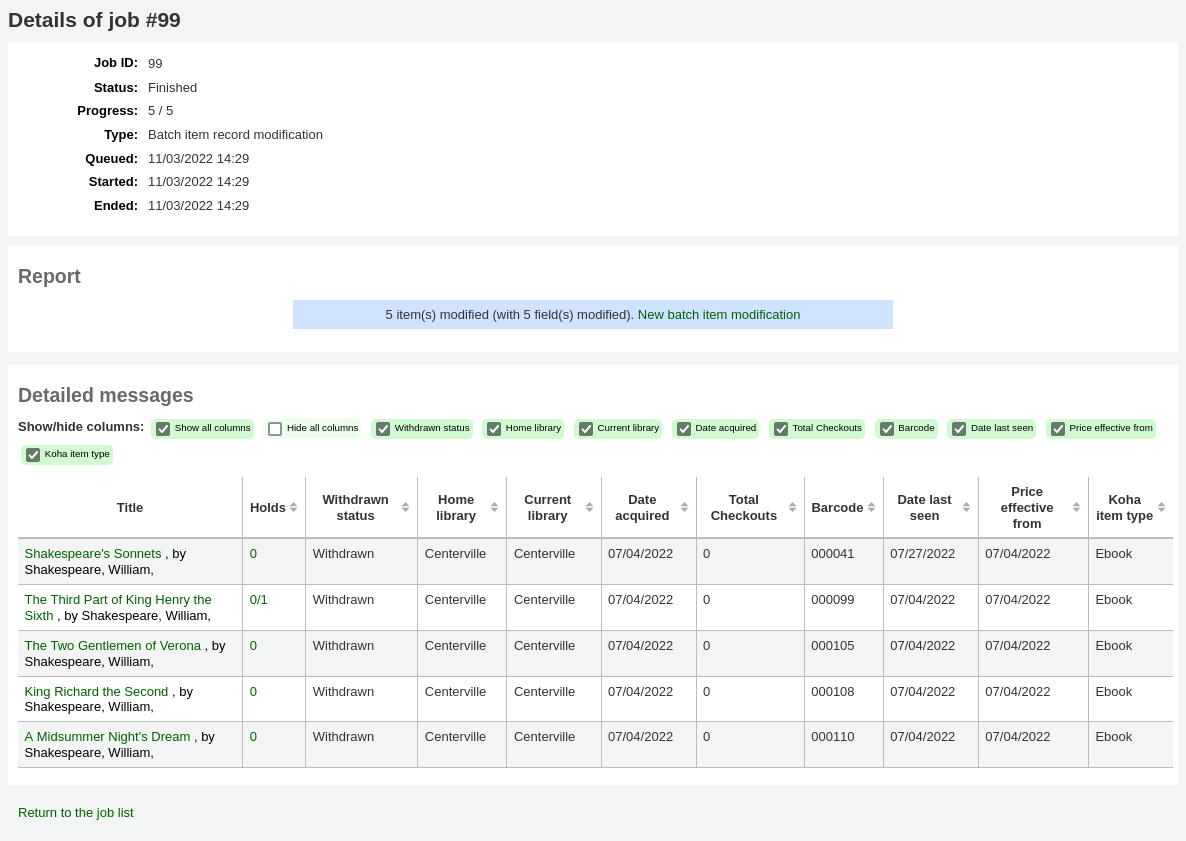
Batch editing items from the bibliographic record
You can also edit items on one bibliographic record in a batch by going to the bibliographic record and clicking Edit > Edit items in batch

This will bring you to the same batch item modification tool as above.
Batch editing items from a report
The batch item modification tool is also available from reports results when the results contain itemnumbers.
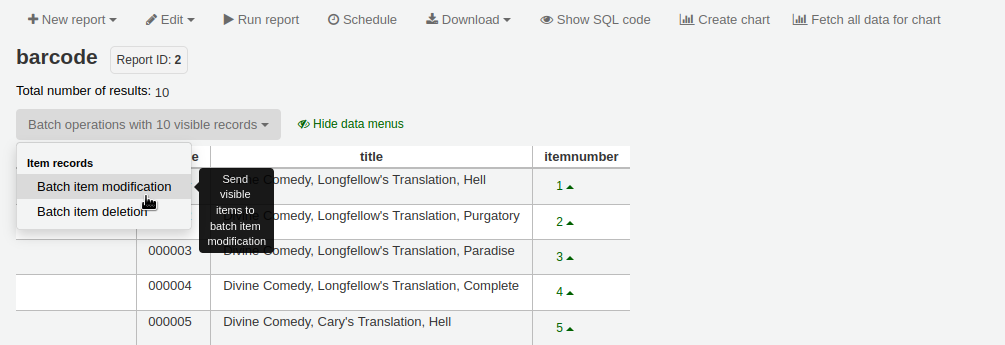
When the report contains the itemnumber, the option 『Batch operations with X visible records』 will automatically appear. This option contains batch item modification ans batch item deletion.
By default, only 20 results are shown when running reports, therefore, the batch modification will only be done on 20 results. If you have more results that you want to edit in a batch, make sure to change the number of results per page before choosing the batch operation.
Automatic item editing by age
Get there: More > Cataloging > Automation > Automatic item modifications by age
This tool allows you to update item specific fields when an item reaches a certain age.
備註
Staff need the items_batchmod permission to access this tool.
備註
The settings in this tool will be acted upon by the corresponding cron job.
If you haven’t created any rules, you will see the option to 『Add rules』 on the page. Click this button to create rules.

If you have rules already there will be a button that reads 『Edit rules』. To create a new rule click the 『Edit rules』 button at the top of the page.

You will be brought to a page where you can edit existing rules or create a new rule.

Click 『Add rule』.

Fill out the form that appears to set the new rule:
Age in days: the age in days at which the item will update
Age field: the field on which the age is based
items.dateaccessioned (default): date of acquisition of the item; in MARC21, it is normally mapped to 952$d
items.replacementpricedate: date the replacement price is effective from; in MARC21, it is normally mapped to 952$w
items.datelastborrowed: date the item was last checked out; in MARC21, it is normally mapped to 952$s (not editable manually)
items.datelastseen: date of the last transaction made on the item; in MARC21, it is normally mapped to 952$r (not editable manually)
items.damaged_on: date on which the damaged status was set (not editable manually)
items.lost_on: date on which the lost status was set (not editable manually)
items.withdrawn_on: date on which the withdrawn status was set (not editable manually)
Conditions: what criteria is needed to trigger the update
Choose the field to check from the dropdown menu
Enter the value the field should have to trigger the update
If you need more than one condition, click 『Add a condition』
Substitutions: what changes are made when the script runs
Choose the field to change from the dropdown menu
Enter the value the field should have after the update
If you need to do more than one change, click 『Add a substitution』
Once you’re done, click the 『Save』 button to save the rule and go back to the main page, or click 『Add rule』 again to add another rule.

Rotating items through libraries automatically
Get there: More > Cataloging > Automation > Stock rotation
備註
This tool will only be available if the StockRotation system preference is enabled.
備註
To access this automation tool, staff needs the following permissions:
manage_rotas: this grants the ability to create, update and delete rotas
manage_rota_items: this grants the ability to add, remove and progress items on a rota.
Stock rotation helps to spread resources more fairly among library branches and allows patrons to see a wider range of titles.
Items are popular whilst they are new at a particular branch. However, their use often tails off over time. This tool empowers librarians to automate the movement of items on to another branch before usage declines and thereby extends the items useful life.
Library staff create rotation plans (rotas) and then assign them to items. A cronjob is then used to cycle these items round the specified libraries on the rotation plan, moving them to the next stage after the prescribed period of time has passed at the current stage.
備註
This tool requires the stockrotation.pl cron job that must be configured to run on a daily basis.
Email notices may be used to provide the library branches with a list of items to be put in transit to the next branch and if an item is found to be on loan at the time that it should be transferred, an alert will be displayed when it is next returned.
備註
The notice used is SR_SLIP. It can be customized with the Notices and slips tool.
From the stock rotation tool page you can add new rotation plans (rotas) and see a summary of your currently configured rotation plans. You can then edit plan details, activate and deactivate plans and manage stages and items on a given rotation plan.

備註
You can customize the columns of this table in the 『Table settings』 section of the Administration module (table id: stock_rotation).
Creating a new rota
To create a new rota (rotation plan), click the 『New rota』 button on the main stock rotation page.

Name: enter a name or code to identify the rota
Cyclical:
No: items will remain at the last library on the rotation plan upon reaching the end of the rota
Yes: items will continue to rotate, returning back to the first library on the rotation plan once they have completed their allotted time at the last library, indefinitely until manually removed from the rota
Description: optionally add an expanded description of the rota for display in summary views
Once the rota is complete with stages and items, you can activate the rota to begin cycling the items through the rotation.
From the stock rotation tool main page, click on 『Activate』 next to the rota.

Adding stages to a rota
Once the rota is created, you can add stages to it. Stages are a length of time that an item will stay at a particular library before moving on.
From the stock rotation summary page, click the 『Manage』 button and choose the 『Stages』 option.

Click the 『Add stage』 button.
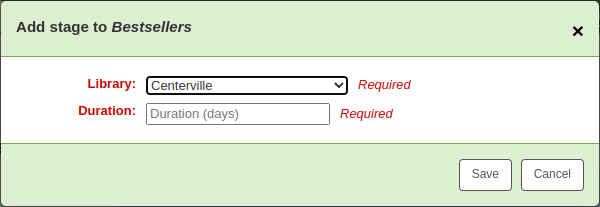
Library: choose the library this stage is for
Duration: enter the number of days the item should stay at this library before moving on
Click 『Save』.
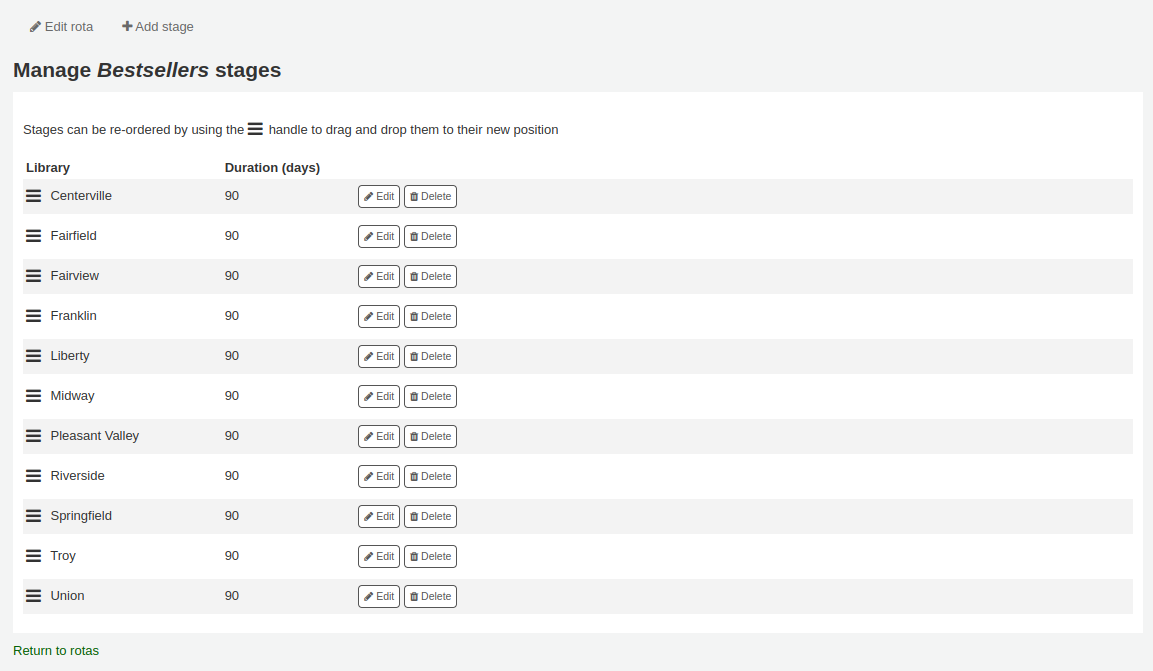
Once all the stages have been added, you can move them around using the handles on the left to change the order.
Adding items to a rota
Once a rota has stages, items can be added to it.
From the stock rotation summary page, click the 『Manage』 button and choose the 『Items』 option.

Click the 『Add items』 button.
Items can be added to a rota individually (by barcode) or in bulk (via the upload of a line delimited barcode file).
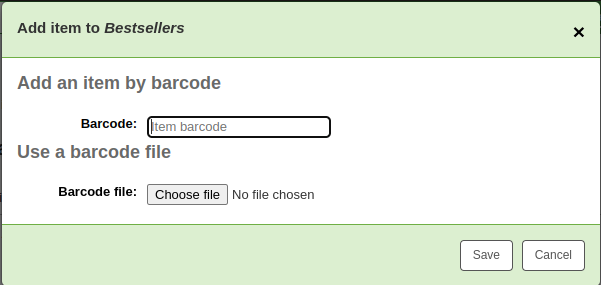
Items can also be added to a rota through the staff interface catalog, in the 『Rota』 tab on the left when viewing a detailed record.

Choose the rota to add the item to and click 『Add to rota』.
Items can also be automatically added to rotas at acquisition time by using the LRP (Library Rotation Plan) field in EDI.
On the Manage > Items page, there will be a summary of all items on the rota with their current location. You have the options to immediately progress items, mark items as 『in demand』 and remove an item from rotation.
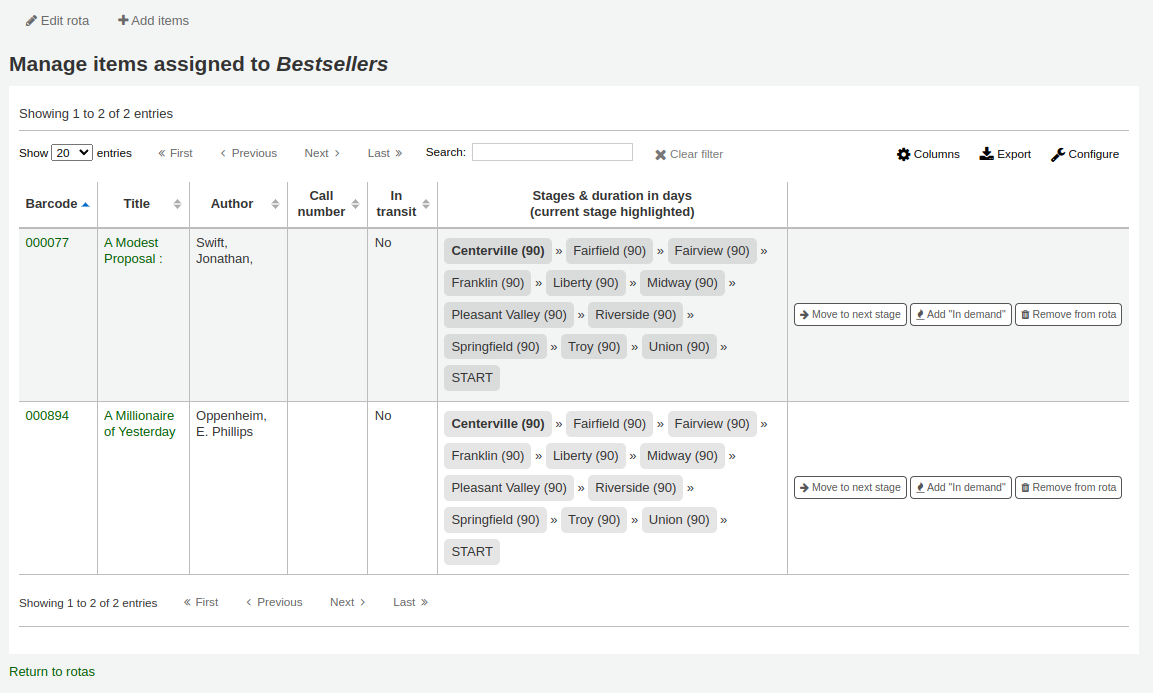
備註
You can customize the columns of this table in the 『Table settings』 section of the Administration module (table id: stock_rotation_manage_items).
Move to next stage: progress the item directly to the next stage even if the duration at the current stage is not complete.
Add 「In demand」: double the duration the item will stay at it’s current stage compared to what is set in the rota. This is often used for items that are found to be unexpectedly popular at a particular library.
Remove from rota: remove the item from the rota.
Individual items can also be managed from the staff interface catalog, in the 『Rota』 tab.

Grouping items
You can group items in order to place holds on a subset of items on a bibliographic record, rather than a specific item or the next available item. For example, if you have a bibliographic record for a series, and several items of each volume, you can group items by volumes and then place holds on the next available item of 「Vol. 4」.
備註
Staff users need the manage_item_groups permission
You need to first enable the item groups feature with the EnableItemGroups system preference.
Once the system preference is enabled, a new 『Item groups』 tab will appear in the detailed record in the staff interface.
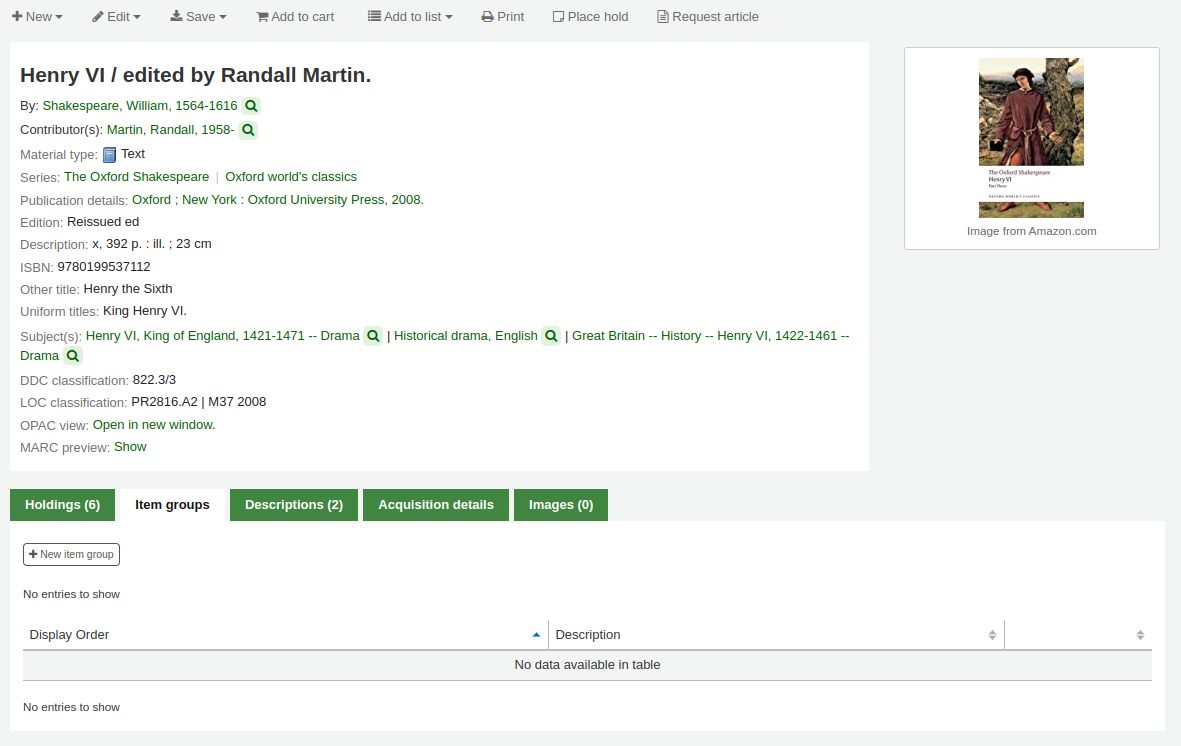
Click on the 『New item group』 button
In the form that appears,
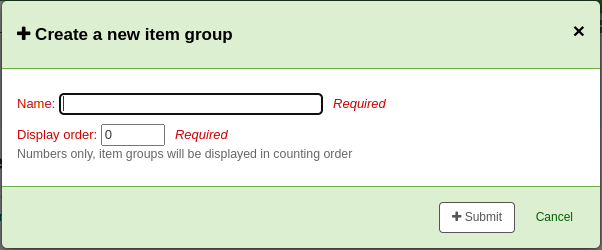
Name: enter a name for the group, this name will visible in the staff interface and the OPAC
Display order: enter a number for the position this group should be displayed compared to the other groups of the same record (for example, if you have groups with 0, 1 and 2 as display order, the 0 group will be displayed first, the 1 group will be displayed second and the 2 group will be displayed third. You can put any number in there, your groups can be 3, 11 and 27, in that case, 3 will be displayed first, then 11 and finally 27)
Click 『Submit』 to create the group
Once it is created, you can add items to the group.
In the 『Holdings』 tab, check the items that should be added to the group
At the top of the table, there will be batch actions, click on 『Add/move to item group』
Choose which group the selected items should be added to

Click 『Set item group』
The item group in which each item is will be shown in the 『Holding』 table.
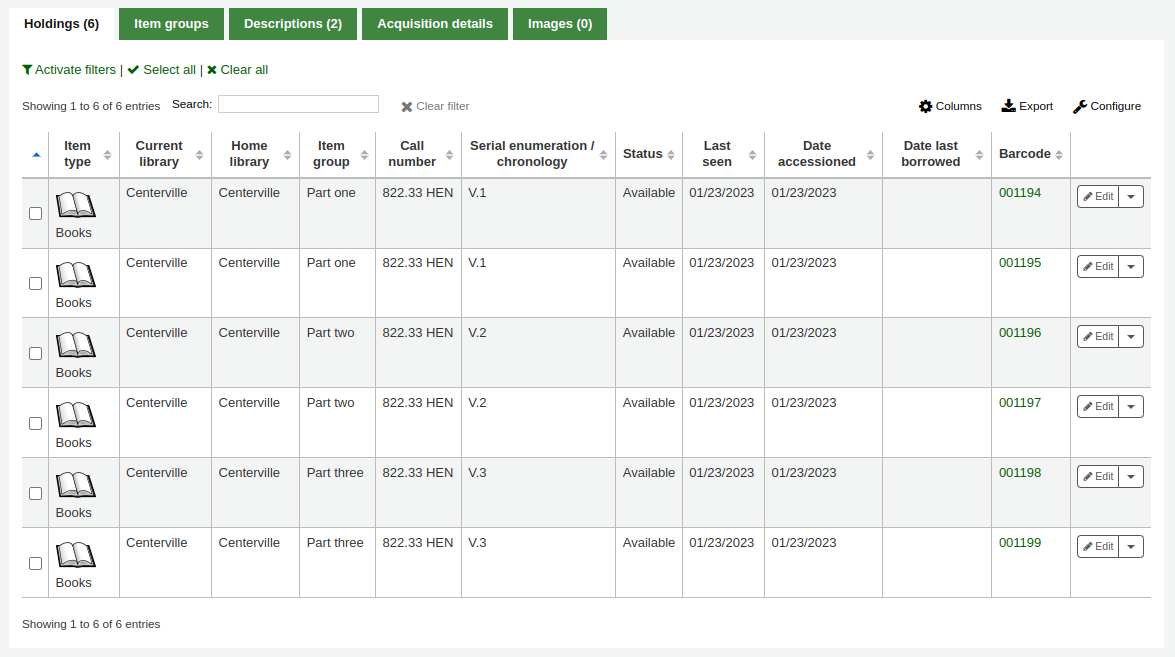
To delete an item group, go to the 『Item groups』 tab, and click the 『Delete』 button. This will only delete the group, the items will remain, but ungrouped.
Item information
每個書目紀錄左方有個分頁可檢視館藏。

Clicking that tab will give you basic information about the items.
The 『Item information』 section shows basic information about the item such as the home library, item type, collection code, call number, copy number, replacement price, and accompanying materials.

The 『Statuses』 section shows the current status of the item. If the item is on loan, the loan details are displayed. If the item was renewed, you can click 『View』 to see the details of any renewals, which include the date, the staff member who renewed the checkout, as well as if it was done manually or automatically (through the automatic_renewals.pl cronjob).

You can also view and edit the status information in this section. If an item is marked lost, damaged or withdrawn, you will see the date that status was applied.

The 『Priority』 section shows if the item is excluded from local holds priority.

The 『History』 section shows information about the acquisition and check out history of the item. If you ordered the item through the acquisitions module, this section will include the order date, vendor, accession (receiving) date and invoice number. Clicking the order or accession date will bring you to the acquisitions information for that item. This section also shows the number of total checkouts (with a link to see the checkout history), the date and time the item was last seen, the date it was last borrowed and the last patron to borrow this item (if the StoreLastBorrower system preference is enabled), if the item was paid for by the patron, the volume or serial number information, and public and non-public notes.

Adding cover images for items
If you have either OPACLocalCoverImages or LocalCoverImages set to 『Show』, you can upload cover images for individual item records from the 『Upload image』 option from the Edit button on the right of the Holdings table.

Click Choose file to find the image file on your computer and then Upload file.
On the next screen you are given the option to replace existing images. You can then click on Process images.
The image will display in a Cover image column in the holdings display.
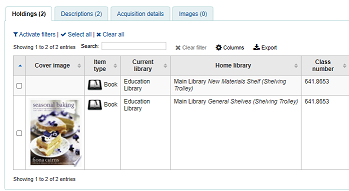
To delete an image, click on the image in the holdings display. You will see a greyed out copy of the image with the option to delete.

Moving items
Items can be moved from one bibliographic record to another using the 『Attach item』 option.

Visit the bibliographic record you want to attach the item to and choose 『Attach item』 from the 『Edit』 menu.

Simply enter the barcode for the item you want to move and click 『Submit』.
If this is the last remaining item attached to a bibliographic record you will be presented with a button to delete the original host record.

If you want to move all items to a new record creating only one bibliographic record you can use the merge records tool instead.
Deleting items
很多方法可以刪除館藏紀錄。打開書目紀錄詳情按上方的 『編輯』 鈕就能刪除單筆館藏紀錄。從這裡再勾選 『編輯館藏』。
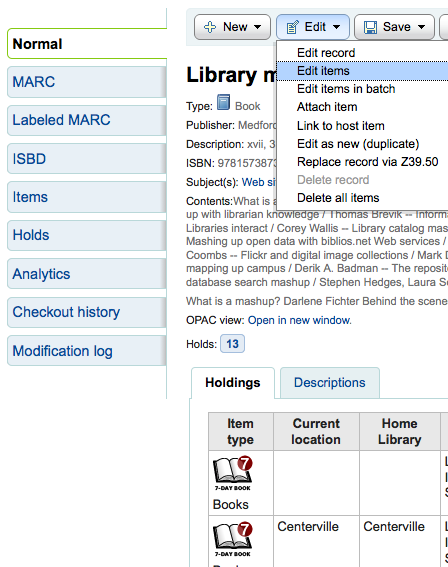
館藏清單的每個館藏旁有 『刪除』 連結。按下此連結可刪除未借出的館藏。

若能確認附屬於書目紀錄的館藏都未借出,可以使用 『編輯選單』 下的 『刪除全部館藏』 選項,移除該紀錄的館藏。
You can also enable StaffDetailItemSelection to have checkboxes appear to the left of each item on the detail display. You can then check off the items you would like to delete and click 『Delete selected items』 at the top of the list.

最後,使用 批次刪除工具 批次刪除館藏。
Batch deleting items
Get there: More > Cataloging > Batch editing > Batch item deletion
This tool will allow you to delete a batch of item records from Koha.
From the tool, choose to either upload a file of barcodes or itemnumbers, or scan item barcodes one by one into the box below the upload tool.
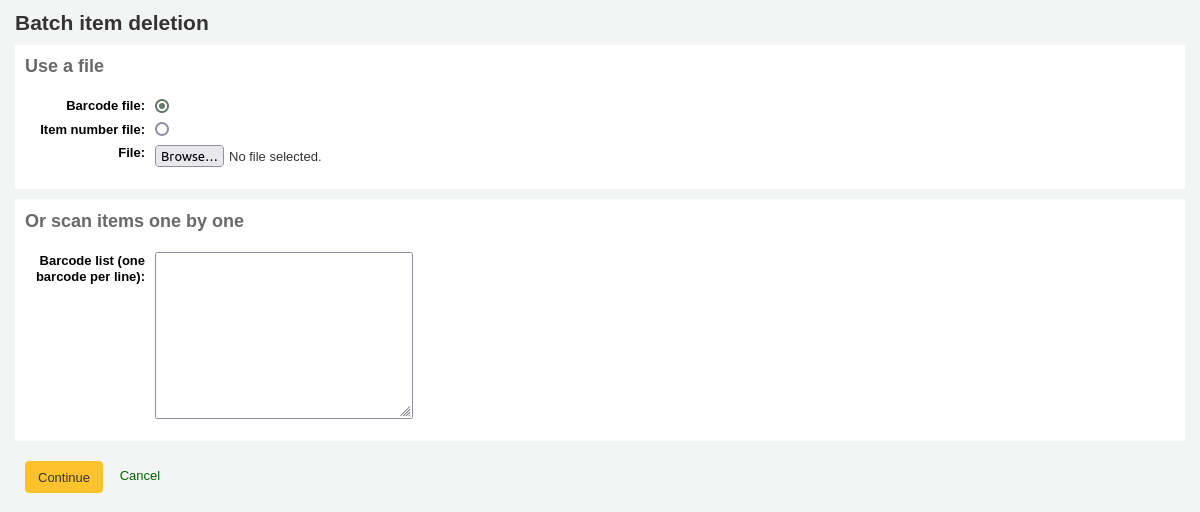
Once the file is uploaded or the barcodes listed, click 『Continue.』
You will be presented with a confirmation screen. From here you can uncheck the items you don’t want to delete. You can check the 『Delete records if no items remain』 box to delete the bibliographic record if the last item is being deleted.

備註
Items that are the last item attached to a bibliographic record with one or more record-level holds will be automatically unchecked. You will need to delete the hold before deleting the item.
Items that are checked out will also be automatically unchecked. They will need to be checked in before they can be deleted.
If your file (or list of scanned barcodes) has more than 1000 barcodes, Koha will be unable to present you with a list of the items. You will still be able to delete them, but not able to choose which items specifically to delete or delete the bibliographic records.

Click 『Delete selected items.』
備註
If the items are checked out the items will not be deleted.
The deletion job will be enqueued in the background jobs.

To see the deletion details, click 『View detail of the enqueued job』.
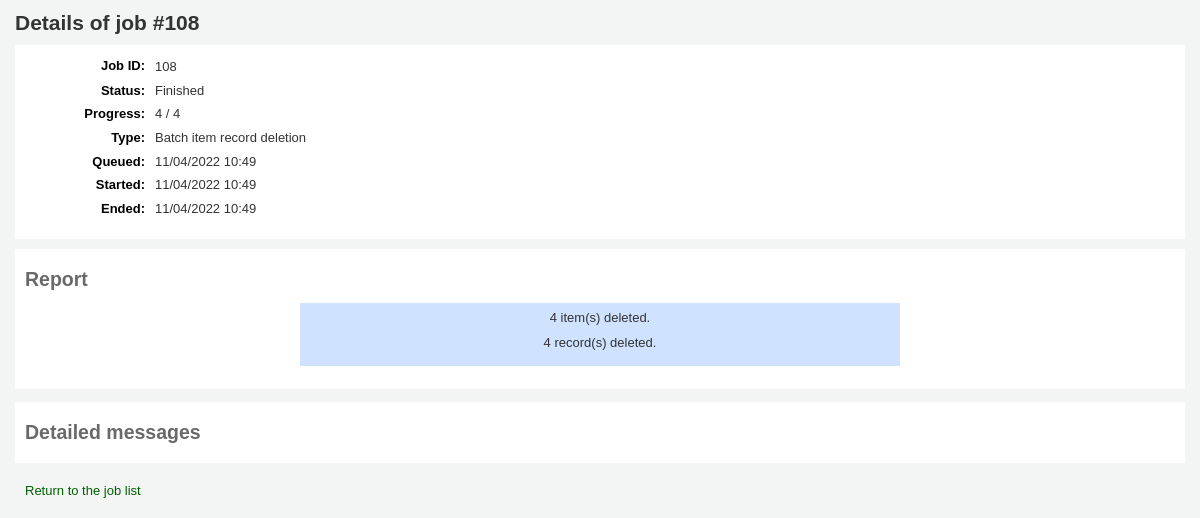
To delete a new batch of items, click 『New batch item deletion』.
Batch deleting items from the bibliographic record
The batch item deletion tool is also available from the bibliographic record details page.
From the bibliographic record details page, click the 『Edit』 button and choose the 『Delete items in a batch』 option.
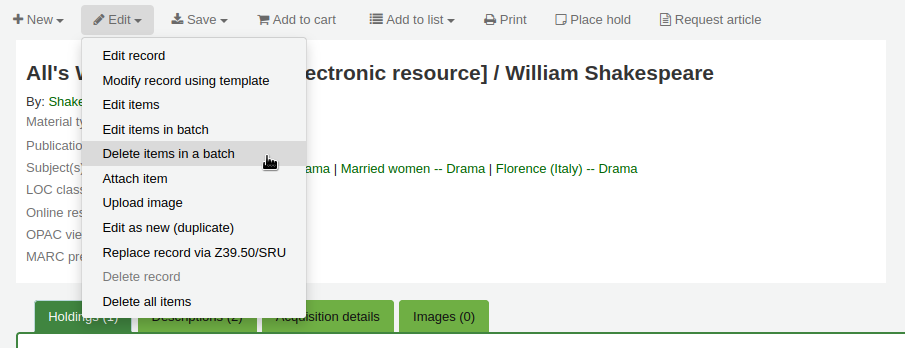
This will open the batch item deletion tool for the items of the specific record.
Batch deleting items from a report
The batch item deletion tool is also available from reports results when the results contain itemnumbers.

When the report contains the itemnumber, the option 『Batch operations with X visible records』 will automatically appear. This option contains batch item modification ans batch item deletion.
By default, only 20 results are shown when running reports, therefore, the batch deletion will only be done on 20 results. If you have more results that you want to delete in a batch, make sure to change the number of results per page before choosing the batch operation.
Item specific circulation history
每筆書目紀錄有其流通紀錄(含或不含讀者資訊,視您的設定),但每筆館藏也有其自身的流通紀錄。勾選紀錄左方的 『館藏』 分頁,即可看到。

在 『紀錄』 標題下有個連結至 『檢視館藏借出紀錄』,點選之後,開啟館藏的紀錄,看起來與書目紀錄的頁面略有不同。
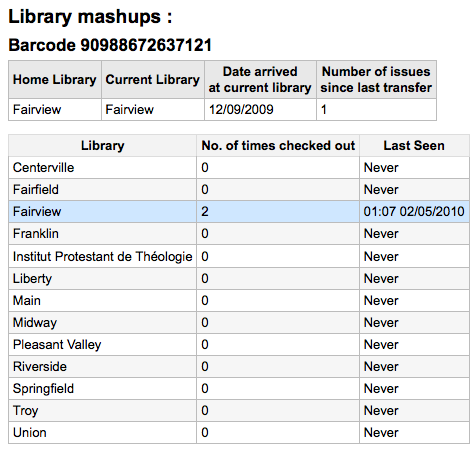
Creating labels
Get there: More > Cataloging > Tools > Label creator
The label creator tool allows you to use layouts and templates which you design to print a nearly unlimited variety of labels including barcodes. Here are some of the features of the label creator tool:
Customize label layouts
Design custom label templates for printed labels
Build and manage batches of labels
Export single or multiple batches
Export single or multiple labels from within a batch
Export label data in one of three formats:
PDF - Readable by any standard PDF reader, making labels printable directly on a printer
CSV - Export label data after your chosen layout is applied allowing labels to be imported in to a variety of applications
XML - Included as an alternate export format
Label layouts
Get there: More > Cataloging > Tools > Label creator > Manage > Layouts
A layout is used to define the fields you want to appear on your labels.
Adding a layout
To add a new layout, click on the 『New』 button at the top of the label creator tool and choose 『Layout』.
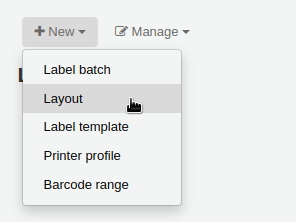
Using the form that appears, decide what appears on your labels.
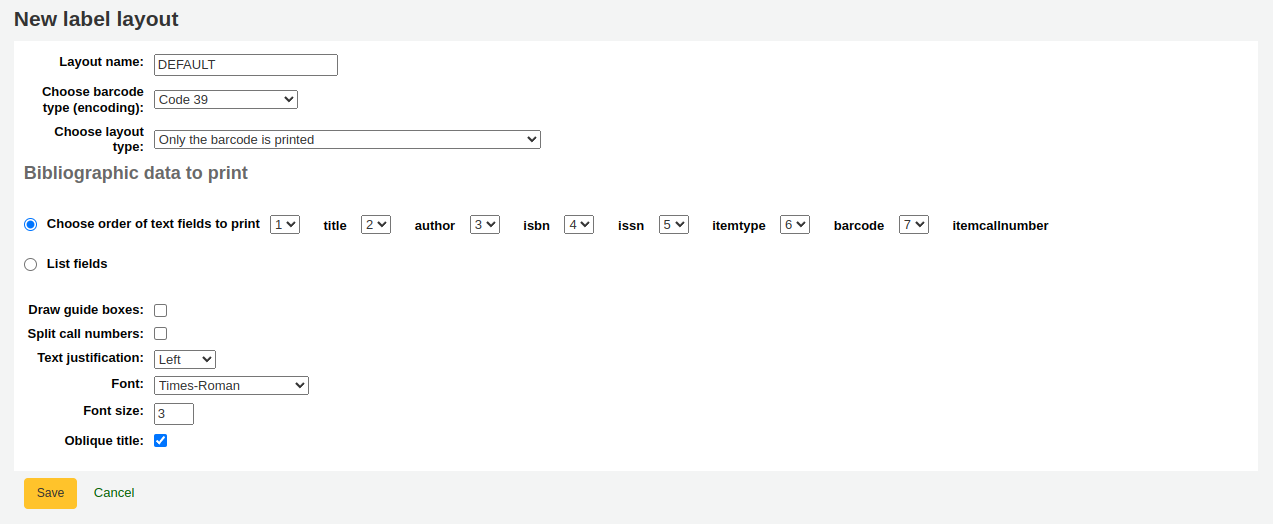
『Layout name』: enter a name for the layout to help you identify it later.
『Choose barcode type (encoding)』: if this is a barcode label, choose the encoding (Code 39 is the most common)
『Choose layout type』: choose what type of information is printed on the label.
Only the bibliographic data is printed: only bibliographic information will appear on the label (this can be used for spine labels for example)
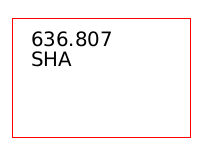
備註
Bibliographic data includes any of the data fields that may be mapped to your MARC frameworks.
Barcode precedes bibliographic data: the barcode will appear at the top of the label and the bibliographic information underneath

Bibliographic data precedes barcode: the bibliographic information will appear at the top of the label and the barcode underneath
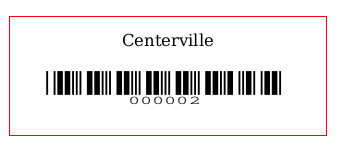
Barcode and bibliographic data are printed on alternating labels: the bibliographic information will appear on one label, and the barcode on the next label, alternating for each item

Only the barcode is printed: only the barcode will appear on the label
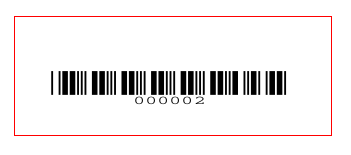
『Bibliographic data to print』: if you chose to print bibliographic data on the label, choose from the preset list of fields which fields should appear on the label and in which order. Alternatively, you can click on 『List fields』 and enter your own data.

備註
In 『List fields』, you can specify any database field from the following tables (use the schema viewer (http://schema.koha-community.org) to find the field names):
items
biblioitems
biblio
branches
You can also specify MARC subfields as a 4-character tag-subfield string, for example 254a for the title field in MARC21.
You can also enclose a whitespace-separated list of fields to concatenate on one line in double quotes, for example 「099a 099b」 or 「itemcallnumber barcode」.
Finally you can add in static text strings in single-quote, for example 『Some static text here.』
『Draw guide boxes』: choose if guidelines are printed around each label (this is useful when first setting up the label creator to check alignment with your label sheets)
『Split call numbers』: choose if call numbers should be split (usually used on spine labels)
備註
Call number splitting rules are managed under Administration > Classification sources.
『Text justification』: choose the text alignment (left, center or right)
『Font』: choose the font type
Font type choices are currently limited to:
Times-Roman (regular, bold, italic, or bold-italic): a serif font type
Courier (regular, bold, oblique (italic), or bold-oblique (bold-italic)): a monospace font type
Helvetica (regular, bold, oblique (italic), or bold-oblique (bold-italic)): a sans-serif font type
『Font size』: enter the font size in points
『Oblique title』: choose if the title should be italicized
Click 『Save』 to save the new layout.
After saving, your layouts will appear under Manage > Layouts.
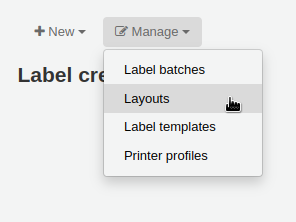
Editing a layout
To edit an existing layout, click on the 『Manage』 button at the top of the label creator tool and choose 『Layout』.

In the table of currently available layouts, click the 『Edit』 button next to the layout you want to edit.

Change the necessary values and click 『Save』.
Deleting a layout
To delete an existing layout, click on the 『Manage』 button at the top of the label creator tool and choose 『Layout』.

In the table of currently available layouts, click the 『Delete』 button next to the layout you want to delete, and confirm the deletion.

Label templates
Get there: More > Cataloging > Tools > Label creator > Manage > Label templates
A template is based on the label/card stock you are using. This might be Avery 5160 for address labels, Gaylord 47-284 for spine labels or Avery 28371 for your patron cards, just to give a couple of examples. These labels will include all of the information you will need for setting up in Koha. This information may be on the packaging, on the vendor’s website or it can be measured manually.
Adding a template
To add a new template, click on the 『New』 button at the top of the label creator page and choose 『Label template』.
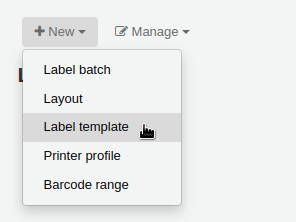
Using the form that appears you can define the template for your sheet of labels or cards.

『Template ID』: this will be automatically generated after saving your template, this is simply a system-generated unique id
『Template code』: enter a code for the template, the code should be something you can use to identify your template on a list of templates
『Template description』: use this field to add additional information about the template
『Units』: choose which measurement scale you’re going to be using for the template. This should probably match the unit of measurement used on the template description provided by the product vendor.

The measurements, number of columns and number of rows can be found on the packaging, on the vendor’s website or they can be measured manually.
Page height: height of the page
Page width: width of the page
Label width: width of the label
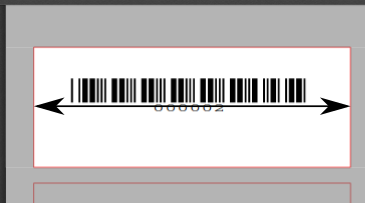
Label height: height of the label
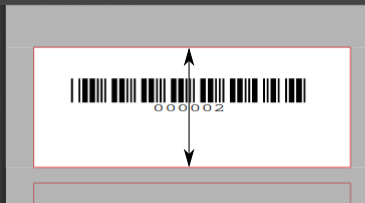
Top page margin: height between the top of the page and the top of the first row of labels
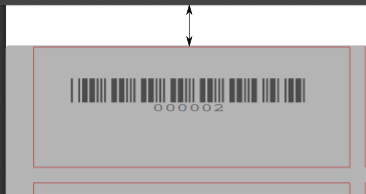
Left page margin: width between the left side of the page and the left side of the first column of labels
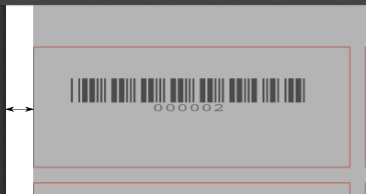
Top text margin: height between the top of the label and the top of the first line of text
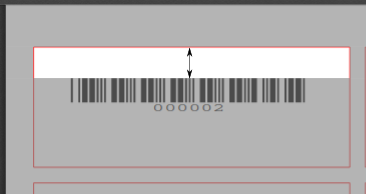
Left text margin: width between the left side of the label and the start of the text
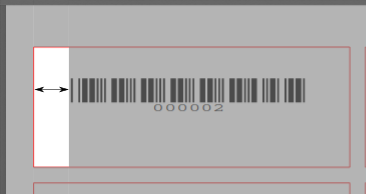
備註
If you do not supply a left text margin in the template, a 3/16」 (13.5 point) left text margin will apply by default.
Number of columns: number of columns of labels in a page, or number of labels per row
Number of rows: number of rows of labels in a page, or number of labels per column
Gap between columns: width between two columns of labels

Gap between rows: height between two rows of labels
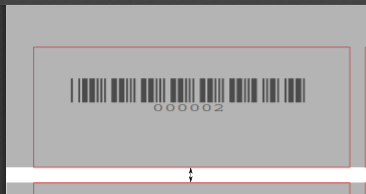
A profile is a set of 「adjustments」 applied to a given template just prior to printing which compensates for anomalies unique and peculiar to a given printer (to which the profile is assigned).
Before picking a profile try printing some sample labels so that you can easily define a profile that is right for your printer/template combination.
After finding any anomalies in the printed document, create a profile and assign it to the template.
Click 『Save』 to save the new template.
After saving, your templates will appear under Manage > Label templates.
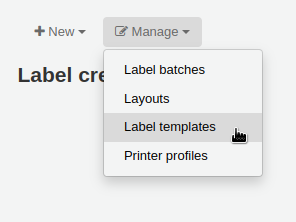
Editing a template
To edit an existing template, click on the 『Manage』 button at the top of the label creator page and choose 『Label template』.

In the table of currently available templates, click the 『Edit』 button next to the template you want to edit.
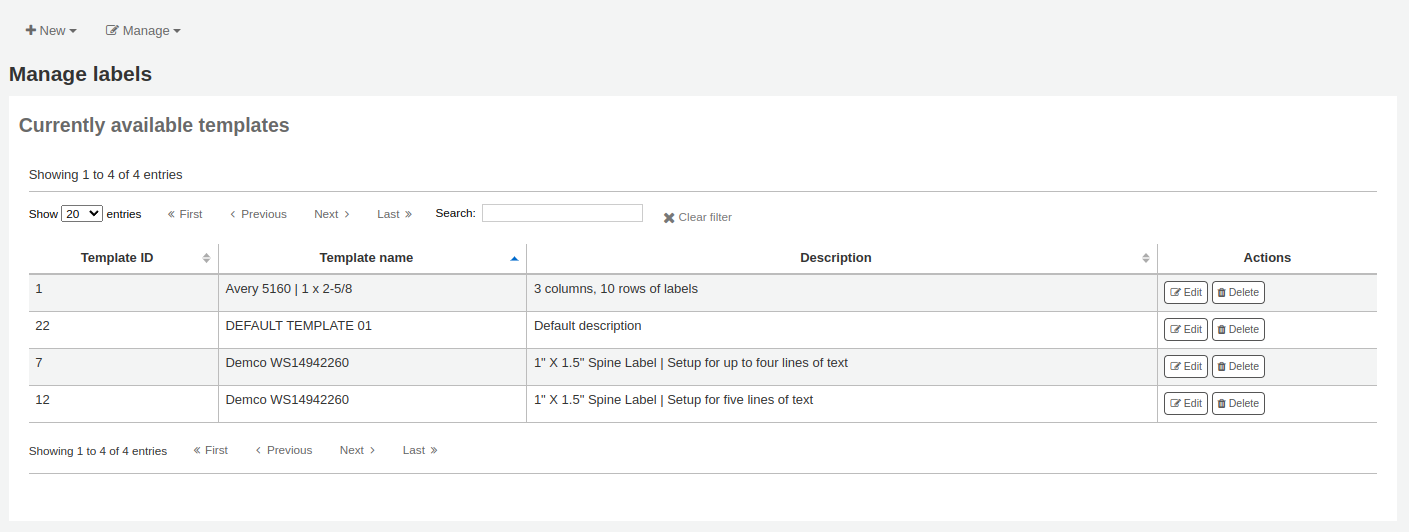
Change the necessary values and click 『Save』.
Deleting a template
To delete an existing template, click on the 『Manage』 button at the top of the label creator page and choose 『Label template』.
In the table of currently available layouts, click the 『Delete』 button next to the layout you want to delete, and confirm the deletion.

Pinter profiles
- Get there: More > Cataloging > Tools > Label creator > Manage >
Printer profiles
A profile is a set of 「adjustments」 applied to a given template just prior to printing which compensates for anomalies unique and peculiar to a given printer (to which the profile is assigned). This means if you set a template up and then print a sample set of data and find that the items are not all aligned the same on each label, you need to set up a profile for each printer to make up for the differences in printing styles, such as the shifting of text to the left, right, top or bottom.
If your labels are printing just the way you want, you will not need a profile.
Adding a printer profile
To add a new profile, click on the 『New』 button at the top of the label creator tool and choose 『Printer profile』.
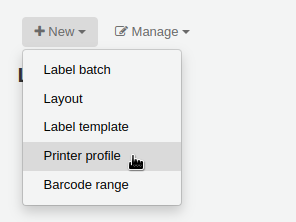
Using the form that appears you can create a profile to fix any problems with your template.
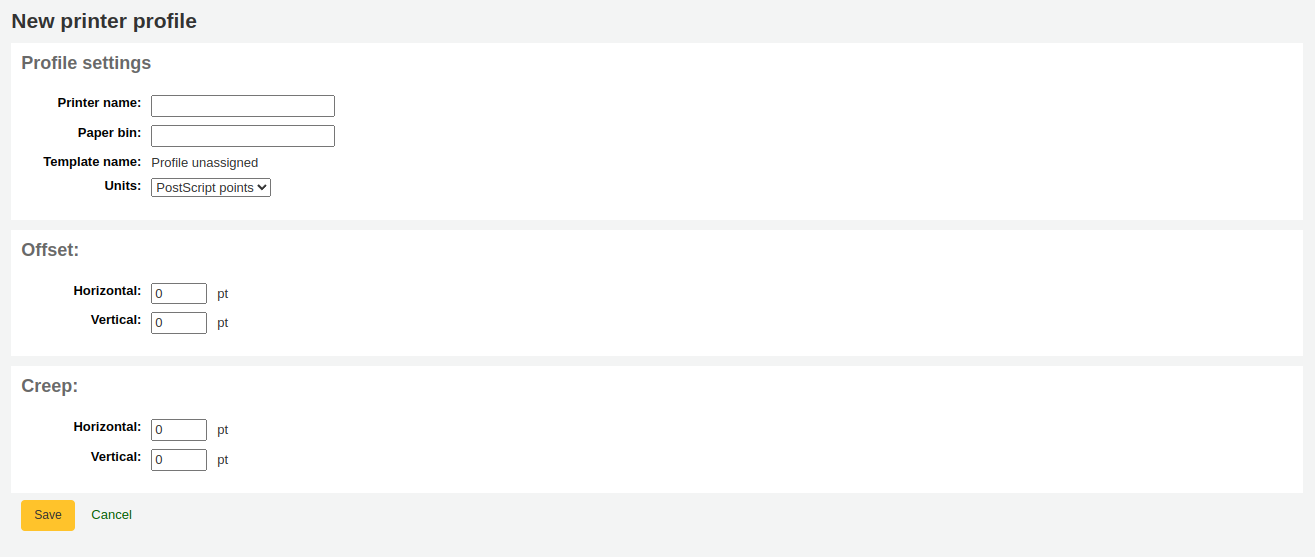
『Printer name』: enter a name for the printer. It does not have to match your printer exactly, it is only used for reference within Koha, so you can use the printer model number or you can call it 『the printer on my desk』.
『Paper bin』: enter a name for the printer’s paper tray. Like the printer name, it is only used as a reference.
『Template name』 will be filled in once you have chosen which template to apply the profile to in the template edit form
『Units』: define what measurement scale you’re using for your profile.

The next sections are used to adjust the label printing.
Offset describes what happens when the entire image is off center either vertically or horizontally
Creep describes a condition where the distance between the labels changes across the page or up and down the page
備註
For these values, negative numbers move the error up and to the left and positive numbers move the error down and to the right
Example: the text is .25」 from the left edge of the first label, .28」 from the left edge of the second label and .31」 from the left edge of the third label. This means the horizontal creep should be set to .03」 to make up for this difference.
Click 『Save』 to save the new profile.
After saving, your profiles will appear under Manage > Printer profiles.
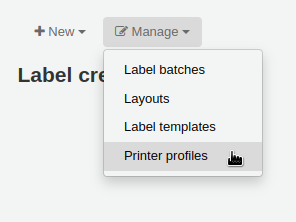
Once you have saved your new profile, you can return to the list of templates and edit the template that this profile is for.
Editing a printer profile
To edit an existing printer profile, click on the 『Manage』 button at the top of the label creator page and choose 『Printer profiles』.

In the table of currently available printer profiles, click the 『Edit』 button next to the profile you want to edit.

Change the necessary values and click 『Save』.
Deleting a printer profile
To delete an existing printer profile, click on the 『Manage』 button at the top of the label creator page and choose 『Printer profiles』.
In the table of currently available profiles, click the 『Delete』 button next to the profile you want to delete, and confirm the deletion.

Label batches
Get there: More > Cataloging > Tools > Label creator > Manage > Label batches
Batches are made up of the items for which you would like to print labels. Once in this tool you can search for the item records you would like to print out labels for.
Adding a label batch
Batches can be created in one of two ways. The first is to click the 『Create label batch』 link on the Staged MARC management page.

The other is to choose to create a new batch from the label creator tool
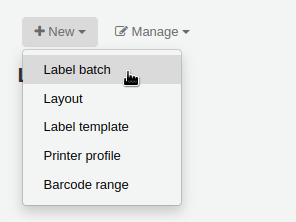
You will be brought to an empty batch with a box to scan barcodes or itemnumbers in to and an 『Add item(s)』 button at the bottom of the page.

You can either scan barcodes in to the box provided and click the 『Add item(s)』 button or you can click the 『Add item(s)』 button with the barcodes box empty. Clicking 『Add item(s)』 with nothing in the barcodes box will open a search window for you to find the items you want to add to the batch.
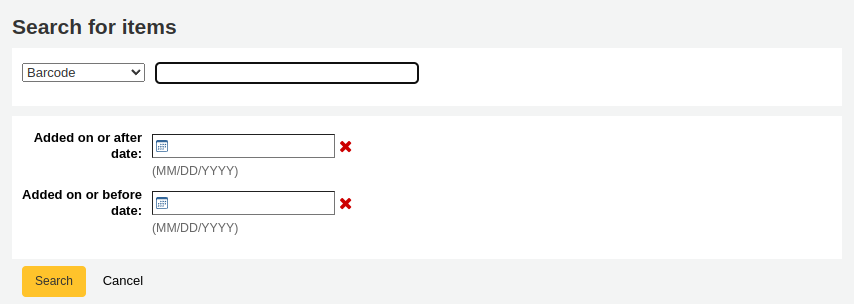
From the search results, click the check box next to the items you want to add to the batch and click the 『Add checked』 button. You can also add items one by one by clicking the 『Add』 link to the left of each item.
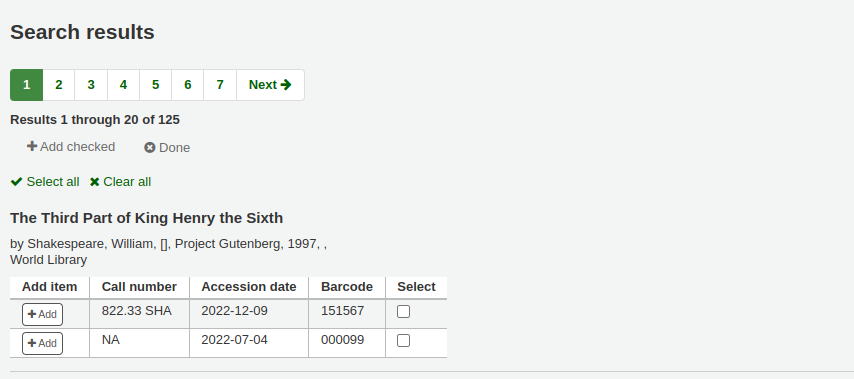
Once you have added all of the items click the 『Done』 button. Click again on the 『Add item(s)』 button to transfer the items from the barcode box to the batch. The resulting page will list the items you have selected.

If some items were added more than once by accident, you can click the 『Remove duplicates』 button. This will check barcodes and remove any duplicates from the batch.
If you need to remove some items from the batch, select them by checking the box on the right and click the 『Remove selected items』 button.
Optionally, you can add a description to this batch, in case you need to find it later. Enter a description in the 『Batch description』 field and click 『Save description』. This description will appear in the 『Currently available batches』 page.
To print your labels, click the 『Export full batch』 button. To print only some of the labels, select the items and click the 『Export selected item(s)』 button. To print only one label from the batch, click the 『Export』 button to the right of that item. Either way you will be presented with a confirmation screen where you can choose your template and layout. If you’re using a sheet of labels that is not complete, you can enter the starting label (labels are counted horizontally).
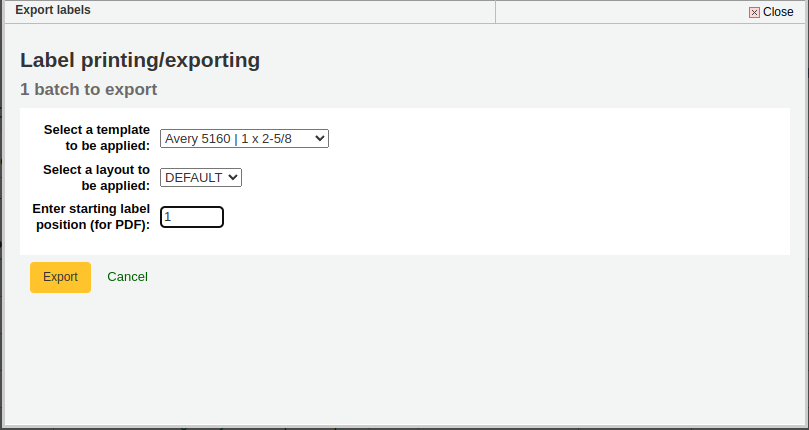
You will then be presented with three download options: PDF, CSV, or XML.
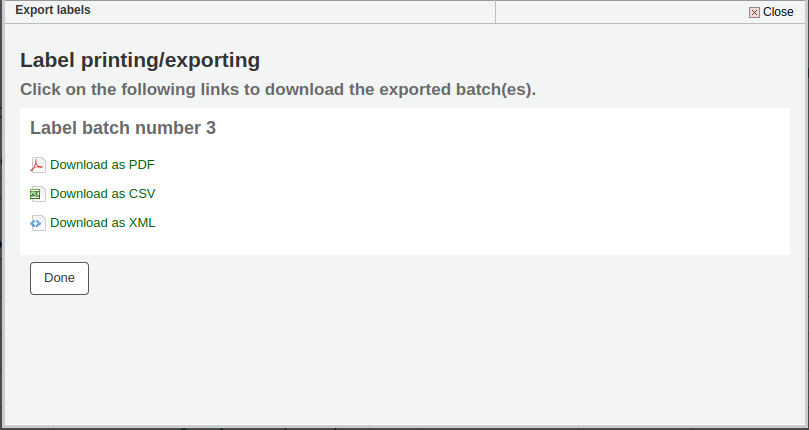
After saving your file, simply print on the blank labels you have in your library.
The batch is saved for later use, if needed, and is accessible under Manage > Label batches.
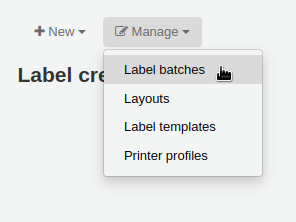
Editing a label batch
To edit an existing label batch, click on the 『Manage』 button at the top of the label creator page and choose 『Label batches』.

You will access currently available batches.
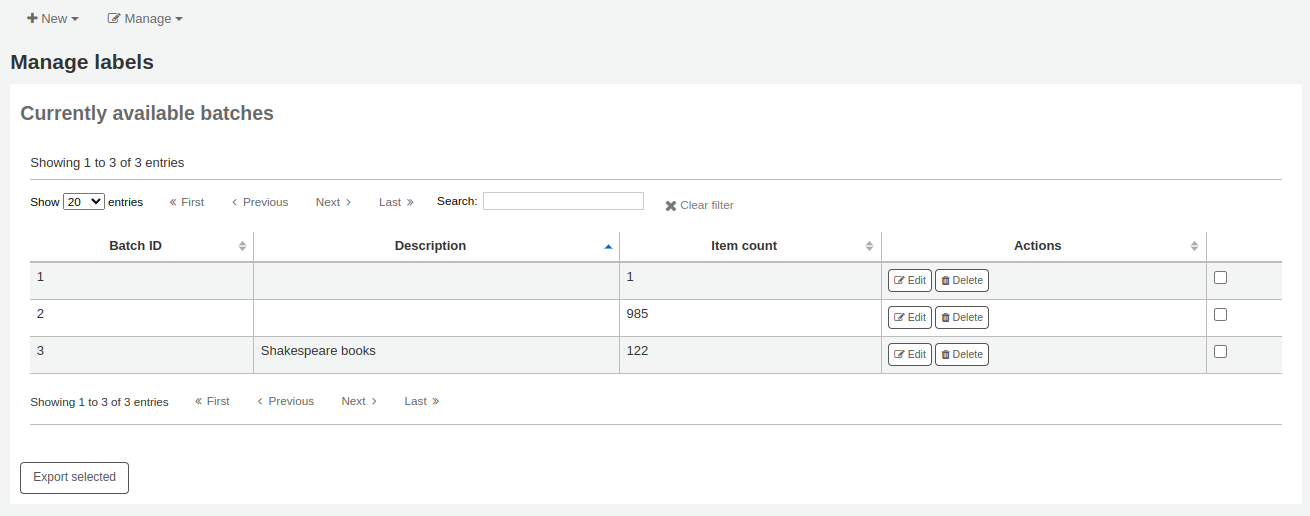
You can print one or more batches directly from this page by checking the box to the right of the batch or batches to print and clicking 『Export selected』.
To edit a batch, click the 『Edit』 button next to the batch you want to edit.
Deleting a label batch
To delete an existing label batch, click on the 『Manage』 button at the top of the label creator page and choose 『Label batches』.

You will access currently available batches.

Click the 『Delete』 button next to the batch you want to delete, and confirm the deletion.
You can also delete a batch from the batch page itself, by clicking the 『Delete batch』 button above the table of items in the batch.
Barcode range
Get there: More > Cataloging > Tools > Label creator > New > Barcode range
If you want to print your barcode labels in advance, before even cataloging the items, you can choose to add a batch of a range of barcodes.
Click 『New』 and choose 『Barcode range』 from the label creator tool.
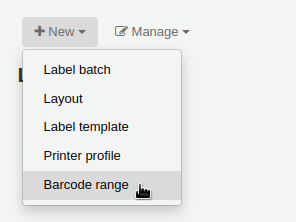
Enter the starting and ending barcodes.

警告
The barcode range tool does not accept leading zeroes. If you enter 0001234 the barcode that will be printed will be 1234.
Click 『Print range』.
You will be presented with the confirmation screen where you can choose your template and layout and enter the starting label if using an incomplete sheet of labels.

備註
The only download option for barcode ranges is PDF.
Save the file and print it on a blank sheet of labels.
Barcode generator
Get there: More > Cataloging > Tools > Barcode generator
Koha offers a barcode generator tool that can be used to create images of barcodes for various uses (in notices for example).
This tool can be used for a number of types of barcodes, as well as QR codes.
It will create an image from the given barcode in the chosen barcode format and also generate a unique HTML tag which can be used anywhere.

To generate a new image, fill out the form.
Barcode type: choose the barcode type to be used
備註
Most barcode types allow only numerical characters.
The following allow alphanumeric characters:
Code39
NW7
QRcode
Some barcode types (EAN13, EAN8, UPCA, and UPCE) expect specific patterns (which can be found here https://barcode.tec-it.com/en/ under EAN/UPC).
Hide text: check this box if you only want the actual barcode on the image. If unchecked, the number will be printed in human readable characters under the barcode.
Barcode height: enter the height in pixels the barcode image should have
Barcode: enter the barcode to be printed
Click 『Show barcode』.

On the right of the screen is the barcode image, which can be downloaded or printed.
Under the image, there is an HTML 『img』 tag. You can copy the tag and paste it anywhere you need the barcode to appear (however, note that it is only available in the staff interface).
For a QR Code, the options are slightly different. Instead of 『Barcode height』, there is a 『QR Code module size』 field that can be adjusted by slider. The number refers to the size in pixels of each black or white square in the code (modules). The larger the modules, the larger the image will be.
A QR Code can take not only alphanumeric characters, but any type of textual information, such as a URL or even a short text.
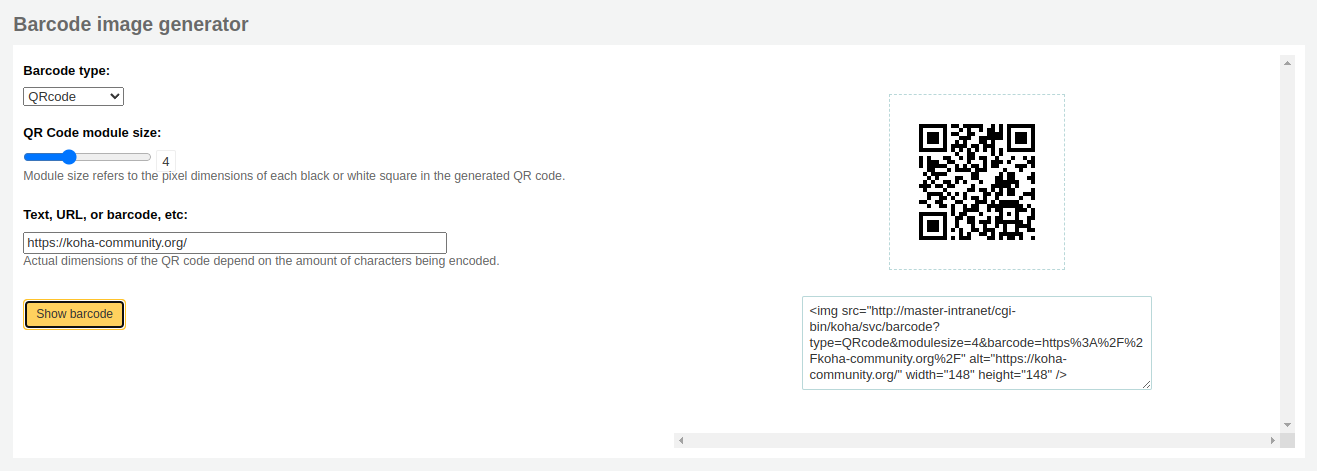
Quick spine label creator
Get there: More > Cataloging > Tools > Quick spine label creator
備註
This tool does not use the label layouts or templates, it simply prints a spine label in the first spot on the label sheet, or on a single label from a label printer.
Define the fields you want to print on the spine label in the SpineLabelFormat system preference.
Format your label printing by either editing the spinelabel.css file found in koha-tmpl/intranet-tmpl/prog/en/css/ or adding the CSS directly in the IntranetUserCSS system preference.
For example, adding the following CSS code in IntranetUserCSS will alter the label’s font.
/* Modify the Quick Spine Label Creator Font etc */ .tools.labels #spinelabel { font-size:11.5pt; font-family:courier new; font-weight:bold; }

To use this tool you simply need the barcode for the book you’d like to print the spine label for, and click 『View spine label』.
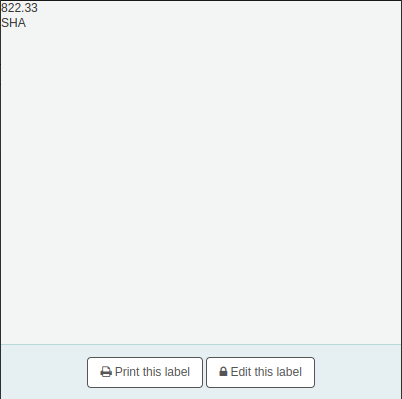
From the page that appears, click 『Print this label』.
If for some reason you need to change the callnumber, click 『Edit this label』. The lock icon on the button will become unlocked, and you will be able to click on the callnumber to edit it.
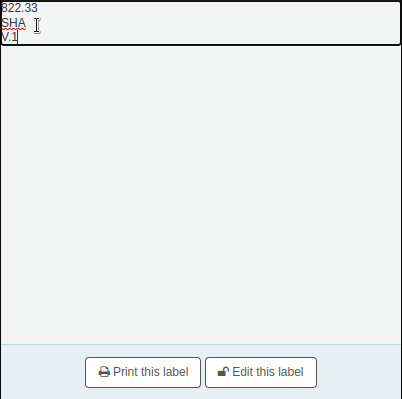
Exporting data
Get there: More > Cataloging > Export > Export catalog data
Koha comes with a tool that will allow you to export your bibliographic, items and authority records in bulk. This can be used to send your records to fellow libraries, organizations or services; or simply for backup purposes.
Exporting bibliographic records
At the top of the screen you need to pick what data you’re exporting. If you’re exporting bibliographic records with or without the item information, click the 『Export bibliographic records』 tab.
Fill in the form in order to limit which records are exported (all fields are optional)
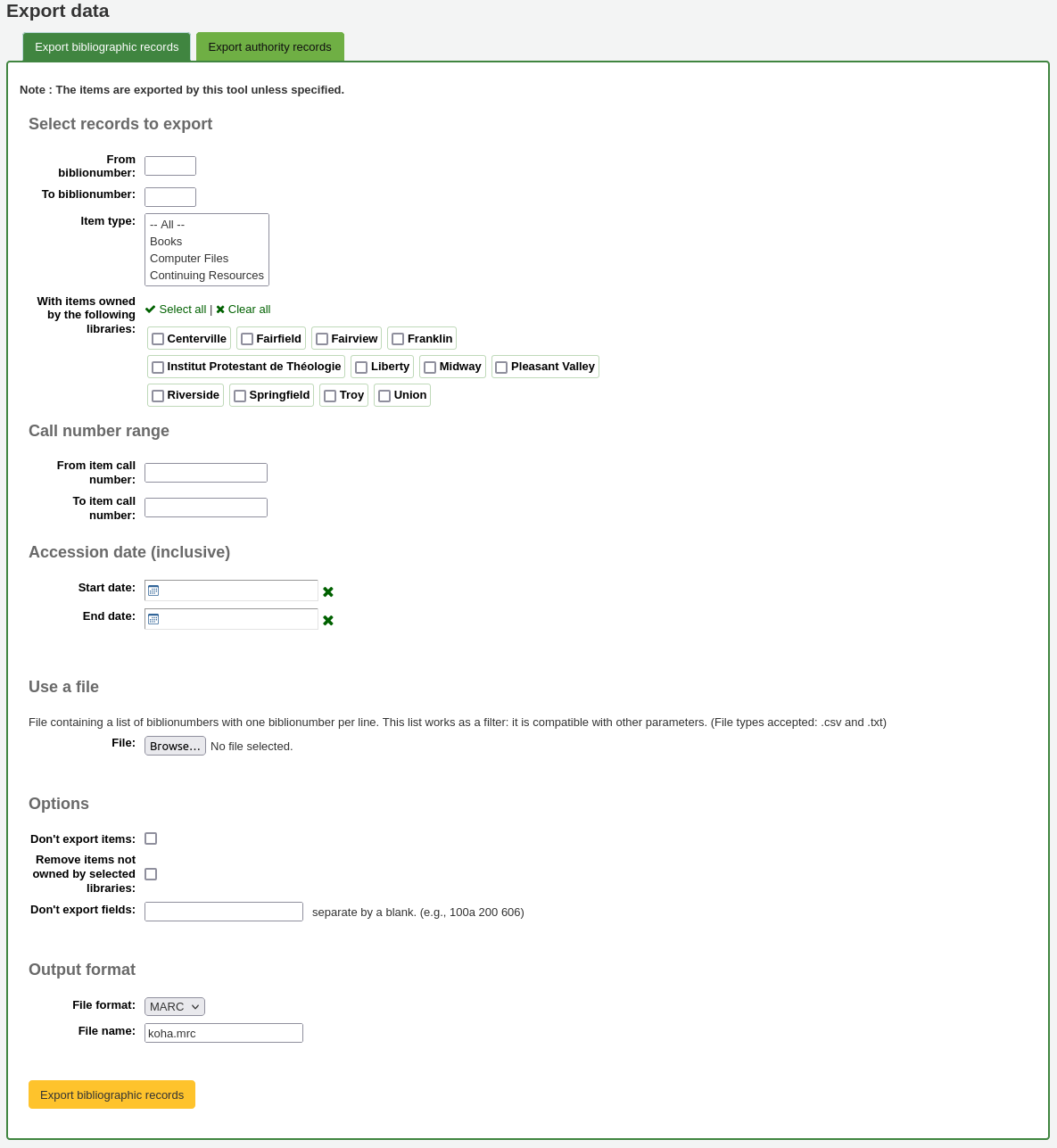
From biblionumber / To biblionumber: limit the exportation to a range of biblionumbers
Item type: limit to a specific item type, or several item types
警告
This limit will use the item type defined in the item-level_itypes system preference.
If the item-level_itypes system preference is set to 『specific item』 and there are no items attached to a bibliographic record, that record will not be exported.
To export all bibliographic records of a specific type, the item-level_itypes system preference needs to be set to 『bibliographic record』.
With items owned by the following libraries: limit to a specific library or group of libraries
警告
This is a filter; if this is set to the default value (all libraries selected), or select one or more libraries, bibliographic records with no items attached will not be exported.
To get bibliographic records with no items, 『clear all』 selected libraries (i.e. de-select all libraries).
Call number range: limit to a call number range
Accession date (inclusive): limit to an acquisition date range
Use a file: you can load a file of biblionumbers of the records to be exported. The file type needs to be .csv or .txt
Don’t export items: by default, items will be exported. Check this box to only export bibliographic records
Remove items not owned by selected libraries: check this box to limit the exported items to items from the library you’re logged in as (if the 『With items owned by the following libraries』 field above is set to 『All』) or to the library or libraries selected above
Don’t export fields: enter which fields that should not be exported, separated by spaces. This can be handy if you’re sharing your data, you can remove all local fields before sending your data to another library
File format: choose the file type, MARC or MARCXML
File name: if needed, enter a new file name for the export file
Click 『Export bibliographic records』
Inventory
Get there: More > Cataloging > Reports > Inventory
Koha’s inventory tool can be used in one of three ways:
By creating a shelf list that you can then mark items off on;
By uploading barcodes gathered by a portable scanner;
By comparing barcodes gathered by a portable scanner or scanned directly to a generated shelf list.
Creating a shelf list
If you do not have the ability to use your barcode scanner on the floor of the library, the option available to you is to generate a shelf list based on criteria you enter. You can then print it to use while walking around the library checking your collection or use it directly in Koha on a portable device.
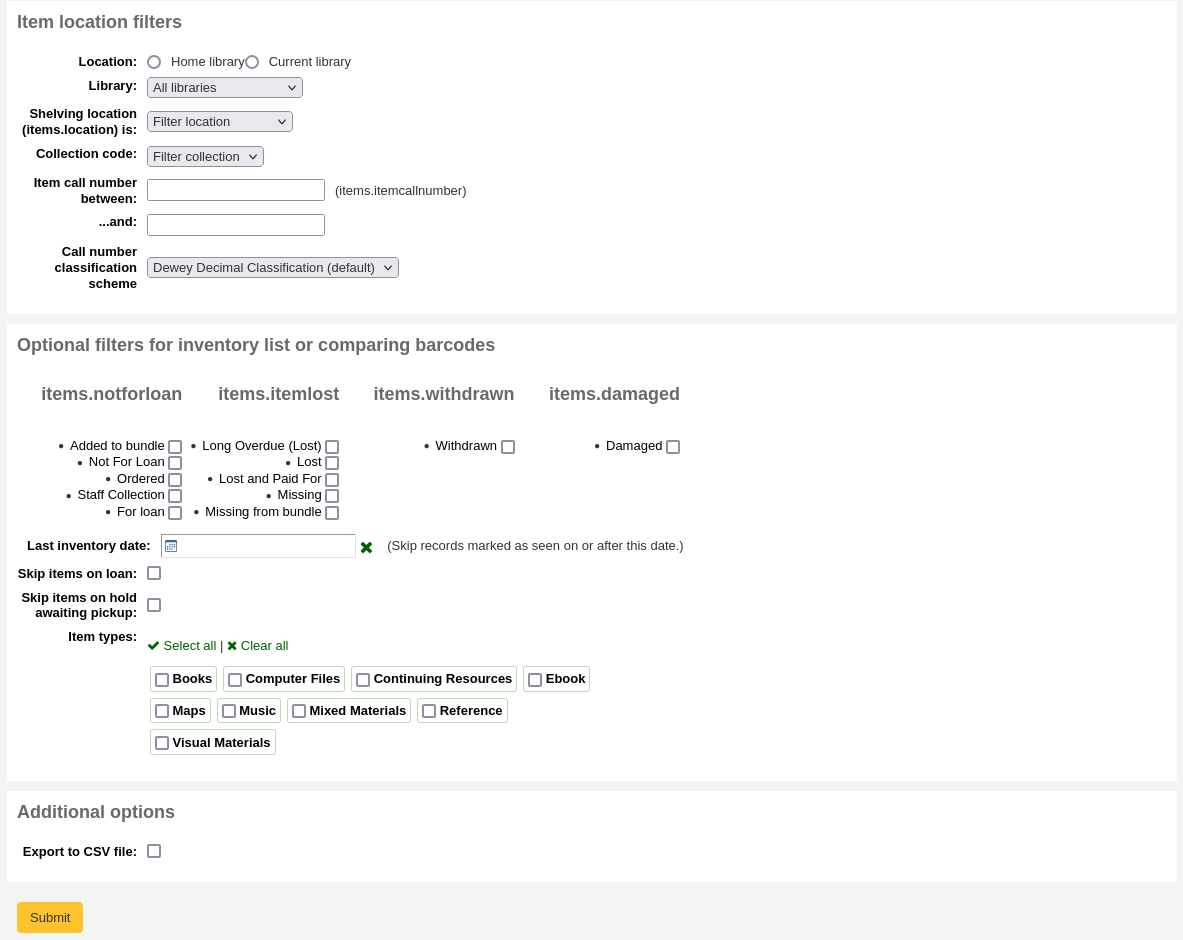
First, choose the criteria for the items you want to print out on a list. All parameters are optional, but if none are selected, the resulting list might be quite large.
Library: choose the branch you want to check, as well as if that branch is the home library or the current holding library of the items.
Shelving location (items.location) is: you can filter by location.
Item callnumber between … and …: you can also limit the list to a specific range of callnumbers.
Call number classification scheme: if filtering by call number, make sure to choose the correct classification scheme
You can filter even more with item statuses (not for loan status, lost status, withdrawn status or damaged status). Check the boxes next to the statuses you want to include. For example, if you are using the list to shelf read, check only the 『for loan』 status as the other items probably won’t be on the shelves.
Last inventory date: enter a date here to skip items that have been marked as seen recently.
Skip items on loan: check this box to filter out loaned items from the list.
Skip items on hold awaiting pickup: check this box to filter out items that are awaiting pickup by patrons
Item types: check the boxes next to the item types you want to include in your shelf list
Export to CSV file: check this box to generate a CSV file for altering in an application on your desktop. If this box is unchecked, the list will be presented on the screen.
Click on 『Submit』 to generate your shelf list.
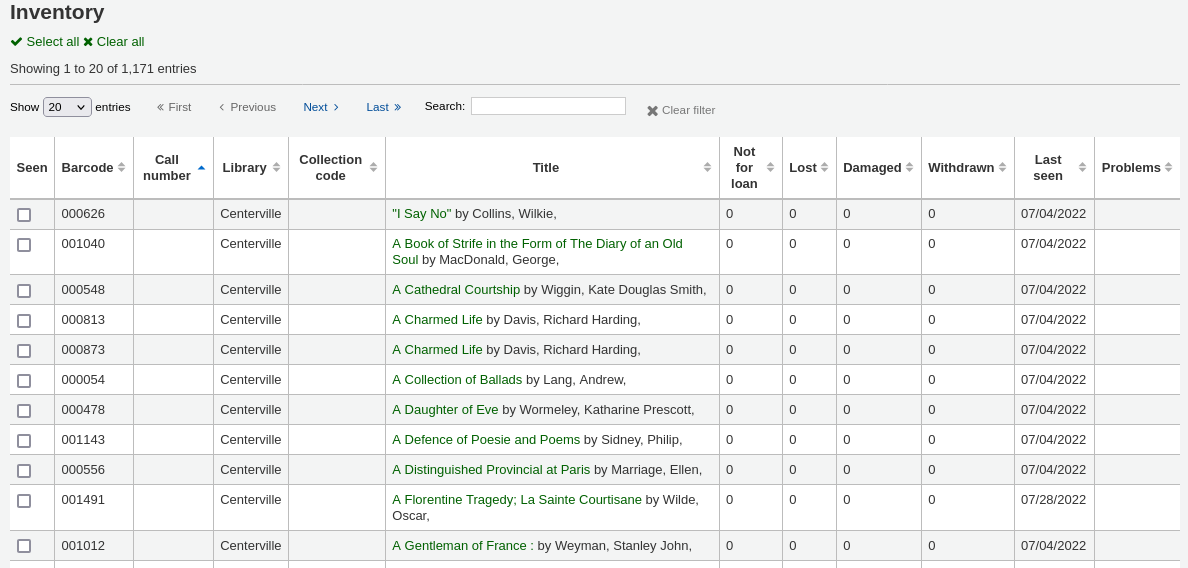
Once you have found the items on your shelves, return to this list and check the boxes next to the items you found. Next, click on one of the three buttons to continue:

Mark seen and quit: updates the 『last seen』 date and time of the selected items to now and returns to the previous screen.
Mark seen and continue: updates the 『last seen』 date and time of the selected items to now and shows the next page of the list.
Continue without marking: doesn’t update any of the items on this page and shows the next page of the list.
Uploading barcodes with a scanner
If you have a portable scanner (or a laptop and USB scanner) you can walk through the library with the scanner in hand and scan barcodes as you come across them (on a laptop, scan the barcodes into a text file or directly into the on screen text box). Once finished you can then upload the text file generated by the scanner to Koha.
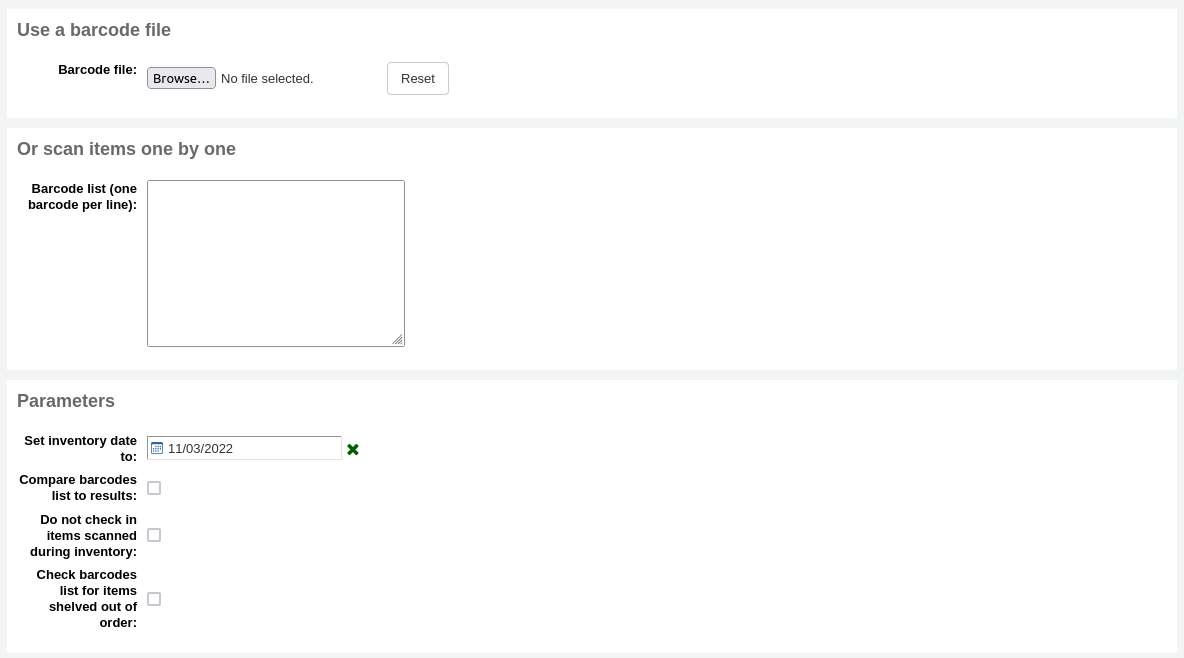
Set inventory date to: choose the date you want to mark all items as last seen.
Compare barcodes list to results: uncheck for this method.
Do not check in item scanned during inventory: unless this is checked, Koha will check in items scanned, as it is assumed that they are on the shelf and so not loaned out. If you do not want to check in scanned items, check this option.
Check barcodes list for items shelved out of order: if this option is checked, Koha will compare the call numbers and make sure they are in the correct order.
Click 『Submit』. This will update all the items』 『last seen』 date to the chosen date (time last seen will be 00:00).
Once you have the updated the last seen date for all items scanned during the inventory it is possible to use reports to identify items that were not scanned and can therefore be assumed missing (you can use the batch item modification tool to change the LOST status of these items). There are sample reports you can use on the Koha SQL Reports Library.
Comparing scanned barcodes to a shelf list
Alternatively, you can combine the two methods to automatically compare a list of scanned barcodes with a generated list.
First, upload you barcode file or scan the barcodes in the box.
Set inventory date to: choose the date you want to appear in the items』 『last seen』 field (the time last seen will be set to 00:00).
Compare barcodes list to results: should automatically be checked.
Do not check in items scanned during inventory: make sure to check this option if you do not want the scanned items to be automatically checked-in if they are checked-out.
Choose the filters (library, shelving location, callnumbers, statuses or item types) to generate a list with which to compare your barcodes. Click on 『Submit』.
備註
Depending on the number of barcodes you are comparing, this may take a few minutes. It is not recommended to compare lists of more than 1000 barcodes as this may cause a session timeout.
Once Koha has finished comparing the barcodes file to the generated list, it will return the number of items updated and a list of problematic items.
備註
Unlike when creating a shelf list, the list that will be presented here will only contain the items that Koha has determined are problematic.
Missing (not scanned): the item is in the generated list but not in the barcodes file.
Found in wrong place: the item is in the barcodes list, but not in the generated list.
Still checked out: the item is checked out, but is in the generated list. It was not automatically checked in.
No barcode: the barcode doesn’t exist.
Unknown not-for-loan status: the item has 『not for loan』 status that is not in the NOT_LOAN authorized values list
Item may be shelved out of order: the callnumber is out of order
Cataloging guides
Bibliographic record cataloging cheat sheet
This section is for MARC21.
欄號 |
書標 |
說明 |
指示 |
|---|---|---|---|
000 |
記錄標示 |
Describes the record (i.e. surrogate) – is it a record for a monograph? A serial? |
Click in this field to fill it in. Then set 「Bibliographic level」 to 『a』 for articles or 『s』 for serials. Otherwise, leave everything as is. The value in position 6 influences the type of material in 008. |
001 |
控制碼 |
近用碼。 |
Enter the accession number written inside the item here. For articles and items which do not have accession numbers, leave blank. You can use the autoControlNumber system preference to automatically fill this field with the biblionumber of the record. |
003 |
控制碼辨識單位 |
Your MARC organizational code |
Click in this field to fill it in (will auto fill if you have your MARCOrgCode preference set). |
005 |
D & T LATEST TRANSACTION |
今天日期與現在時間。 |
按此欄位填入資料。 |
008 |
定長資料細目 |
包括電腦可讀的若干事項。 |
The type of material is automatically set according to the leader, position 06. Generally you will only use 『s』 (single) or 『m』 (multiple) options for position 06- use the former when the item was published in a single year, the latter when it was published over the course of several. If there is a single date, only enter a date in the first date field (positions 07-10). Enter the three-digit country code in positions 15-17, being sure to add spaces if the country code is fewer than three characters long. If there is an index, note that fact in position 31. Enter the three-letter language code in positions 35-37. |
010 |
美國國會圖書館控制號碼 |
美國國會圖書館管制其編目紀錄流程用的號碼。 |
從館藏的版權頁 (若在美國出版) 或 LC的目錄取得該號碼。若找不到,別理它。 |
020 |
ISBN |
出版社使用的號碼用於辨識圖書之用。 |
若出版品本身無此號碼,可能就沒有。 |
022 |
ISSN |
出版社使用的號碼用於辨識期刊之用。 |
若出版品本身無此號碼,可能就沒有。 |
033 |
事件的日期/時間與地點 |
適用於拍賣日期。拍賣目錄的必備欄位。 |
祗進行一天的拍賣,以 YYYYMMDD 格式在分欄 『a』 鍵入日期並在第一個指標鍵入 『0』。連續或不連續進行兩天的拍賣,新增重複的分欄 『a』 以 YYYYMMDD 格式著錄每個拍賣日期,並且在第一個指標鍵入 『1』。連續進行兩天以上的拍賣,以分欄 『a』 (以 YYYYMMDD 格式) 著錄拍賣的第一天,並且新增重複的分欄 『a』 (也是 YYYYMMDD 格式) 著錄拍賣的第最後一天,在第一個指標鍵入 『2』。 |
040 |
編目來源 |
著錄新增與修改紀錄的機構。 |
匯入的紀錄,應新增分欄 『d』 與 OCLC 代碼為其值。新增的紀錄,其分欄 『c』 含有 OCLC 代碼為其值。 |
041 |
語文代碼 |
若館藏有多個語文,用以辨識所有的語文。 |
文字的主要部份祗有一種語文時,在分欄 『a』 著錄其語文代碼。若摘要以特定語文呈現,則新增分欄 『b』 著錄其語文代碼。 |
100 |
主要款目–個人名稱 |
主要著者名稱的權威型式 |
見權威標題速查表與 AACR2。第一個指標的值通常為 『1』,表示該款目先著錄的是姓。若姓名裡祗有名,則第一個指標應為 『0』。 |
110 |
主要款目–團體名稱 |
主要團體著者名稱的權威型式。拍賣目錄的必備欄位。 |
拍賣目錄應使用欄位 110 而不是 100。見權威標題速查表與 AACR2。設定第一個指標為 『2』。 |
111 |
主要款目–會議名稱 |
做為會議主要提供者 (如會議刊物) 的權威型式 |
見權威標題速查表與 AACR2。設定第一個指標為 『2』。 |
245 |
題名敘述 |
著錄題名頁 (或主要著錄來源) 的題名敘述 |
將題名著錄於分欄 『a』、副題名於分欄 『b』、著者敘述於分欄 『c』。若新增紀錄給多冊館藏的其中一冊或部份,則應將該部份的編號著錄於分欄 『n』 並將該部份的題名著錄於分欄 『p』。拍賣目錄的日期 (格式為 『MM/DD/YYYY』),應以方括弧圈住置於分欄 『f』。見 ISBD 標點符號速查表。若沒有著者則把第一個指標設為 『0』,否則設為 『1』。第二個指標用於不排序的字元數 (即,起首的冠詞加其空格 … 對 「The 」 而言第二個指標為 『4』)。 |
246 |
其他題名 |
搜尋與排序用題名的其他型式 |
把讀者可能搜尋的其他題名,著錄於此。不要納入起首的冠詞。第一個指標應為 『3』,若題名祗是不同的拚法,則第一個指標應為 『1』。 |
250 |
版本敘述 |
著錄來自題名頁 (或主要著錄來源) 的版本資訊 |
原樣照錄來自題名頁的版本資訊。可以縮寫太冗長的版本資訊。 |
260 |
出版 (印刷) |
出版資訊。 |
出版地置於分欄 『a』、出版者在分欄 『b』、出版年 (或可能的年代) 在分欄 『c』。見 ISBD 速查表。 |
264 |
PRODUCTION, PUBLICATION ETC. |
Production, Publication, Distribution, Manufacture, and Copyright Notice. |
Put the location of publication in subfield 『a』, the publisher in subfield 『b』, and the year (or probable year) in subfield 『c』. See ISBD punctuation sheet. The label is set dynamically from the second indicator so generally this would be set to 『1』 for Publisher: . |
300 |
稽核項 |
稽核項 |
數量單位置於分欄 『a』、簡述插圖或地圖等 「特殊」 稽核細節於分欄 『b』 (見 AACR2)、高廣與尺寸置於分欄 『c』。見 ISBD 速查表。 |
490 |
集叢項 |
照錄館藏記載的集叢項內容。 |
把集叢題名著錄於分欄 『a』 集叢號著錄於分欄 『v』。參見 ISBD 標點符號速查表。若使用欄位 830 則把第一個指標設為 『1』。做為一般規則,必須照做。 |
500 |
一般附註 |
不適用於其他地方的附註。 |
以完整的句子記載附註,每個主題各有獨立的 500 欄位。 |
501 |
合刊註 |
與其他紀錄裝訂在一起的作品。 |
將其關係記載於分欄 『a』。 |
504 |
書目註 |
說明作品包括書目。 |
若作品包括書目與索引,文字記載為 「含參考書目 (面:XXX-XXX) 及索引。」 於分欄 『a』。若作品沒有索引,移除該部份的文字。若參考資料分散作品各處沒有聚在一起,則移除括號及其敘述。 |
505 |
內容註 |
標準格式的內容清單。未格式化的內容可列在欄位 500 (一般附註)。 |
見 ISBD 速查表。設定第一個指標為 『0』。若含獨立的著者與題名代碼,則設定第二個指標為 『0』。否則,讓第二個指標為空白。 |
518 |
事件之日期/時間與地點註 |
適用於拍賣日期。 |
在拍賣目錄裡,以 『January 2, 1984』 格式把拍賣日期鍵入分欄 『a』 |
520 |
摘要、提要註。 |
圖書或論文的摘要。 |
大部份情況下,編目員不需自行撰寫摘要。摘要可能來自讀者無法自行評論的館藏,印刷於酸紙的圖書或 CD-ROM。 |
546 |
語文註 |
作品使用的語文註 |
祗適用於多語文的作品。見 ISBD 標點符號速查表。 |
561 |
館藏所有權與館藏歷史註 |
著錄館藏前手所有權。 |
祗適用於善本書。 |
563 |
裝訂資訊註 |
著錄館藏的裝訂。 |
祗適用於善本書。 |
590 |
在地使用註 |
在地使用註。拍賣目錄的必備欄位。 |
用於拍賣目錄指出拍賣售出的硬幣類型- 羅馬、希臘等。 |
600 |
主題附加款目–個人名稱 |
個人姓名的權威型式使用於作品討論的人 |
見權威標題速查表與 AACR2。第一個指標應為 『1』,表示該款目以姓在前。若名稱祗有名,則第一個指標設為 『0』。若在美國國會圖書館權威檔案找到該名稱,則第二個指標設為 『0』。否則第二個指標設為 『4』。 |
610 |
標題附加款目–團體名稱 |
團體名稱的權威型式用於作品討論的機構 |
見權威標題速見表與 AACR2。第一個指標設為 『2』。若在美國國會圖書館權威檔案找到該名稱,則設定第二個指標為 『0』。否則第二個指標設為 『4』。 |
611 |
標題附加款目–會議名稱 |
會議名稱的權威型式用於作品討論的會議 |
見權威標題速見表與 AACR2。第一個指標設為 『2』。若在美國國會圖書館權威檔案找到該名稱,則設定第二個指標為 『0』。否則第二個指標設為 『4』。 |
630 |
標題附加款目–劃一題名 |
其他作品題名的權威型式用於原作品 |
見權威標題速見表與 AACR2。第一個指標設為不排序字元數 (首字為冠詞及其空格 … 「The 」 的第一個指標設為 『4』)。若在 LC 權威檔案找到該名稱,則設定第二個指標為 『0』。否則第二個指標設為 『4』。 |
650 |
標題附加款目–主題用語 |
以美國國會圖書館主題標題表描述作品的主題 |
見權威標題速見表與 AACR2。若在美國國會圖書館權威檔案找到該名稱,則設定第二個指標為 『0』。否則第二個指標設為 『4』。 |
651 |
標題附加款目–地理名詞 |
以美國國會圖書館主題標題地理名詞表描述作品的主題 |
見權威標題速見表與 AACR2。若在美國國會圖書館權威檔案找到該名稱,則設定第二個指標為 『0』。否則第二個指標設為 『4』。 |
655 |
索引詞彙–體裁/型式 |
著錄館藏是什麼,而不是該館藏關於什麼。 |
通常適用於拍賣目錄,有個體裁標題 「拍賣目錄」 (確認找到權威標題!) 若在 LC 權威檔案找到該名稱,則設定第二個指標為 『0』。若使用專業辭語典,則設定第二個指標為 『7』 並將該辭語典的代碼著錄於分欄 『2』。否則第二個指標設為 『4』。 |
690 |
在地標題附加款目–主題用語 |
取自任何客製化的主題權威檔案。 |
若沒有適合的 LCSH 術語,可以把其他目錄找到的術語當成主題標目置於 690。 |
691 |
在地標題附加款目–地理名稱 |
取自任何客製化的主題權威檔案。 |
若沒有適合的 LCSH 術語,可以把其他目錄找到的術語當成主題標目置於 691。 |
700 |
附加款目–個人名稱 |
適用於第二著者和作品產製有關的其他人。 |
見權威標題速查表與 AACR2。第一個指標的值通常為 『1』,表示該款目先著錄的是姓。若姓名裡祗有名,則第一個指標應為 『0』。 |
710 |
附加款目–團體名稱 |
適用於和作品產製有關的團體 (如,出版者)。 |
見權威標題速查表與 AACR2。設定第一個指標為 『2』。 |
711 |
附加款目–會議名稱 |
適用於和作品產製有關的會議 (如,貢獻給作品的討論會)。 |
見權威標題速查表與 AACR2。設定第一個指標為 『2』。 |
730 |
附加款目–劃一題名 |
適用於和作品產製有關的劃一題名 (如,啟發現在的作品) |
見權威標題速見表與 AACR2。設定第一個指標為不排序字元數 (即,首字為冠詞及其空格 … 「The 」 的第一個指標設為 『4』)。 |
773 |
主館藏款目 |
著錄包括此作品的較大書目單位 (即,包括篇章與論文的圖書或期刊紀錄) |
主出版品是著者主要款目,則把該著者名稱的權威型式置入分欄 『a』。題名置入分欄 『t』。若主出版品是獨立作品,把出版資訊置入分欄 『d』。若使用 ISSN 與 ISBN,則應分別置於分欄 『x』 與 『z』。關係資訊 (如,卷期編號、頁碼等) 應置入分欄 『g』。分欄 『q』 包括館藏位置的編碼資料:卷、期與號以冒號分隔,在分欄最後鍵入 『<』 及首頁頁碼。設定第一個指標為 『0』。若想產生 「在:」 標籤,則讓第二個指標空白。若希望在欄位 773 顯示文字,則設定第二個指標為 『8』 並新增分欄 『i』 在欄位開始置入標籤 (如 「$i 抽印本來自:」)。 |
830 |
集叢附加款–劃一題名 |
著錄集叢名稱的權威格式於欄位 490。通常等同於 490。 |
見權威標題速見表與 AACR2。設定第二個指標為不排序字元數 (即,首字為冠詞及其空格 … 「The 」 的第二個指標設為 『4』)。 |
852 |
書架位置/索書號 |
圖書、小冊子與論文期刊等館藏的書架位置。 |
祗有一筆紀錄與一個條碼的單冊館藏不要置於此欄位。若館藏沒有條碼,或建立其中一篇文章的紀錄,將書架位置存於分欄 『a』 (見 ANS 編目文件)、索書號置於分欄 『i』。設定第一個指標為 『8』。 |
856 |
電子資源位址及取得方法 |
連結至線上資料。 |
將電子版或摘要等的 URL 置於分欄 『u』 並把連結的題名置於分欄 『y』。設定第一指標為 『4』。 |
942 |
新增款目細目 (Koha) |
供 Koha 使用的專屬資料。 |
設定分欄 『c』 給適當的館藏類型。 |
表:編目指南
Koha-specific fields
Koha uses three fields to store information specific to it.
At the record level, 942 (MARC21) or 942 and 099 (UNIMARC) is used to store information such as record-level item type, record-level call number and classification scheme.
The item (holding) information is stored in 952 (MARC21) or 995 (UNIMARC).
System control numbers for Koha are stored in 999 (MARC21) or 001 and 090 (UNIMARC).
Added entry elements (942 / 099)
942$0 / 099$x - Koha issues (borrowed), all copies
MARC21: 942$0
UNIMARC: 099$x
This field contains the total number of issues/checkouts of all items of this record. It is populated using the update_totalissues.pl cronjob.
Mapped to: biblioitems.totalissues
Indexed in: totalissues
警告
This field should not be editable nor edited manually.
942$2 - Source of classification or shelving scheme
MARC21: 942$2
UNIMARC: 942$2
This field contains the source of classification used by the record’s call number (942$h and 942$i (MARC21)).
There is a choice of classification sources as they are defined in administration. If no classification scheme is entered, the system will use the value entered in the DefaultClassificationSource preference.
The source of classification will be used, along with the call number itself (942$h and 942$i (MARC21)) to create the normalized call number used when sorting by call number.
Mapped to: biblioitems.cn_source
Indexed in: cn-bib-source
942$6 - Koha normalized classification for sorting
MARC21: 942$6
UNIMARC: 942$6
This field contains the normalized call number used for sorting, based on the record-level call number (942$h and 942$i (MARC21)) and the classification source (942$2).
Mapped to: biblioitems.cn_sort
Indexed in: cn-bib-sort
警告
This field should not be editable nor edited manually.
942$c - Koha item type
MARC21: 942$c
UNIMARC: 942$c
This field contains the record-level item type.
The record-level item type is used in various places in Koha.
The value from 942$c is copied to 952$y (MARC21) or 995$r (UNIMARC) as the default value when adding a new item to that record
The record-level item type can be used for the circulation rules if the item-level_itypes system preference allows it (this system preference lets you choose between using the record-level or item-level item type for the circulation rules, among other things)
The record-level item type is indexed and used in the search (see also the AdvancedSearchTypes system preference) as well as the facets (this is useful to find records that don’t have items, like records for online resources, ebooks, pdf files, etc.)
The record-level item type is used for record-level/」next available」 holds
The record-level item type is used for record-level article requests
The record-level item type is displayed in various tables in the staff interface, in the circulation module among other places (it is possible to hide unwanted columns in the 『Table settings』 section of the Administration module)
Mapped to: biblioitems.itemtype
Indexed in: itemtype (mc-itemtype), itype (mc-itype)
942$e - Edition
MARC21: 942$e
UNIMARC: N/A
This field contains the edition information.
942$h - Classification part
MARC21: 942$h
UNIMARC: N/A
This field contains classification part of the call number. It is used, along with 942$2 and 942$i (MARC21) to create the normalized call number (942$6) used when sorting by call number.
Mapped to: biblioitems.cn_class
Indexed in: cn-class
942$i - Item part
MARC21: 942$i
UNIMARC: N/A
This field contains item part of the call number. It is used, along with 942$2 and 942$h (MARC21) to create the normalized call number (942$6) used when sorting by call number.
Mapped to: biblioitems.cn_item
Indexed in: cn-item
942$k - Call number prefix
MARC21: 942$k
UNIMARC: N/A
This field contains prefix to the call number.
Mapped to: biblioitems.cn_prefix
Indexed in: cn-prefix
942$m - Call number suffix
MARC21: 942$m
UNIMARC: N/A
This field contains suffix to the call number.
Mapped to: biblioitems.cn_suffix
Indexed in: cn-suffix
942$n / 955$n - Suppress in OPAC
MARC21: 942$n
UNIMARC: 955$n
If the OpacSuppression system preference is set to 『hide』, this field indicates if the record should be hidden from the OPAC.
In this field, 『1』 means the record will be hidden in the OPAC, and 『0』 (or empty) means the record will be visible in the OPAC.
You can use the YES_NO authorized value list in this field if you don’t want to remember the numerical values.
Indexed in: suppress
942$s / 099$s - Serial record flag
MARC21: 942$s
UNIMARC: 099$s
This field is used by the serials module to indicate whether or not the record is associated with a serial subscription.
Mapped to: biblio.serial
警告
This field should not be editable nor edited manually.
Location and item information (952)
Koha uses field 952 to store item (holding) information in MARC21, and field 995 in UNIMARC.
952$0 / 995$0 - Withdrawn status
MARC21: 952$0
UNIMARC: 995$0
Uses
This field is used to set the withdrawn (weeded) status of the item.
You can use the withdrawn status to weed items without deleting the items.
In the search results, the withdrawn item will be marked as unavailable.
Effects on circulation
A withdrawn item will not be able to be checked out.
A withdrawn item will not be able to be checked in unless the BlockReturnOfWithdrawnItems system preference allows it.
Values
The withdrawn status is numerical, 『0』 (or empty) means 『not withdrawn』 and any other number means 『withdrawn』.
By default, the field is associated with the WITHDRAWN authorized value category so you don’t have to remember the numerical values. The default values in the WITHDRAWN authorized value category are:
1: Withdrawn
Display
Staff interface
Search results (withdrawn items will be marked as unavailable)
Holdings table in the record’s detail page
『Items』 tab of the bibliographic record, 『Withdrawn status』 under 『Statuses』
OPAC
Search results (withdrawn items will be marked as unavailable)
Holdings table in the record’s detail page
To hide withdrawn items from the OPAC, use the OpacHiddenItems system preference.
Mapped to: items.withdrawn
Indexed in: withdrawn
952$1 / 995$2 - Lost status
MARC21: 952$1
UNIMARC: 995$2
Uses
This field is used to set the lost status of the item.
You can use the lost status to mark items as lost or missing
In the search results, the lost item will be marked as unavailable.
Marking an item lost while it is checked out can charge the replacement cost (952$v (MARC21) or 995$g (UNIMARC)) to the patron (see WhenLostChargeReplacementFee), as well as a processing fee (the processing fee is set at the item type level)
The lost status can be changed automatically after a number of days overdue with the longoverdue.pl cronjob
Effects on circulation
The ability to check out a lost item depends on the IssueLostItem system preference.
The ability to check in a lost item depends on the BlockReturnOfLostItems system preference.
Values
The lost status is numerical, 『0』 (or empty) means 『not lost』 and any other number means 『lost』.
By default, the field is associated with the LOST authorized value category so you don’t have to remember the numerical values. The default values in the LOST authorized value category are:
1: Lost
2: Long Overdue (Lost)
3: Lost and Paid For
4: Missing
Display
Staff interface
Search results (lost items will be marked as unavailable)
Holdings table in the record’s detail page
『Items』 tab of the bibliographic record, 『Lost status』 under 『Statuses』
OPAC
Search results (lost items will be marked as unavailable)
Holdings table in the record’s detail page
It’s possible to configure Koha so that lost items don’t display in the OPAC with the hidelostitems system preference.
Mapped to: items.itemlost
Indexed in: lost
952$2 / 995$4 - Source of classification or shelving scheme
MARC21: 952$2
UNIMARC: 995$4
Uses
This field contains the source of classification used by the record’s call number (952$o (MARC21) or 995$k (UNIMARC)).
The source of classification will be used, along with the call number itself (952$o (MARC21) or 995$k (UNIMARC)) to create the normalized call number (952$6 (MARC21) or 995$s (UNIMARC)) used when sorting by call number.
Values
There is a choice of classification sources as they are defined in administration.
If no classification scheme is entered, the system will use the value entered in the DefaultClassificationSource preference.
Display
This is not displayed either in the OPAC or in the staff interface. The information is only available in the item’s editing form.
Mapped to: items.cn_source
Indexed in: classification-source
952$3 / 995$l - Materials specified
MARC21: 952$3
UNIMARC: 995$l (L)
Uses
This field is used to add information about accompanying materials or to specify how many pieces the item has.
Effects on circulation
This information will be displayed when circulation the item so that the circulation staff knows to make sure all the accompanying material is there when checkout out and it’s still there when checking the item back in.

Values
This is a free text field, but it is possible to associate it to an authorized value category in the MARC framework to make it into a drop-down menu.
Display
Staff interface
This information will appear when checking out or checking in an item
Holdings table in the record’s detail page
備註
Use 『Table settings』 if you want to hide that column - Module: Catalogue - Table id: holdings_table and/or otherholdings_table - Column: holdings_materials or otherholdings_materials
『Items』 tab of the bibliographic record, 『Materials specified』 under 『Item information』
OPAC
Holdings table in the record’s detail page (it is hidden by default)
備註
Use 『Table settings』 if you want to show that column - Module: OPAC - Table id: holdingst - Column: item_materials
Mapped to: items.materials
Indexed in: materials-specified
952$4 / 995$1 - Damaged status
MARC21: 952$4
UNIMARC: 995$1
Uses
This field is used to set the damaged status of the item.
In the search results, the damaged item will be marked as unavailable.
Effects on circulation
The damaged status does not affect the ability to check out or check in an item.
The AllowHoldsOnDamagedItems system preference indicates whether or not damaged items can be put on hold.
Values
The damaged status is numerical, 『0』 (or empty) means 『not damaged』 and any other number means 『damaged』.
By default, the field is associated with the DAMAGED authorized value category so you don’t have to remember the numerical values. The default values in the DAMAGED authorized value category are:
1: Damaged
Display
Staff interface
Search results (damaged items will be marked as unavailable)
Holdings table in the record’s detail page
『Items』 tab of the bibliographic record, 『Damaged status』 under 『Statuses』
OPAC
Search results (damaged items will be marked as unavailable)
Holdings table in the record’s detail page
To hide damaged items from the OPAC, use the OpacHiddenItems system preference.
Mapped to: items.damaged
Indexed in: damaged
952$5 / 995$3 - Use restrictions
MARC21: 952$5
UNIMARC: 995$3
Uses
This field is used to set the restricted status of the item.
In the search results, the restricted item will be marked as available.
Effects on circulation
A restricted item will not be able to be checked out.
Values
The restricted status is numerical, 『1』 means restricted and 『0』 (or empty) means unrestricted.
備註
Unlike other statuses, the restricted status can only be 0 (not restricted) or 1 (restricted).
By default, the field is associated with the RESTRICTED authorized value category so you don’t have to remember the numerical values. The default values in the RESTRICTED authorized value category are:
1: Access Restricted
Display
Staff interface
Search results (restricted items will be marked as available)
Holdings table in the record’s detail page
OPAC
Search results (restricted items will be marked as available)
Holdings table in the record’s detail page
Mapped to: items.restricted
Indexed in: restricted
952$6 / 995$s - Koha normalized classification for sorting
MARC21: 952$6
UNIMARC: 995$s
警告
This field should not be editable nor edited manually.
Uses
This field contains the normalized call number used for sorting, based on the item-level call number (952$o (MARC21) or 995$k (UNIMARC)) and the classification source (952$2 (MARC21) or 995$4 (UNIMARC)).
Display
This information is not displayed anywhere in the OPAC or in the staff interface, it is for Koha’s internal use only.
Mapped to: items.cn_sort
Indexed in: cn-sort
952$7 / 995$o - Not for loan status
MARC21: 952$7
UNIMARC: 995$o
Uses
This field is used to set the not for loan status of the item.
In the search results, the not for loan item will be marked as unavailable or for reference use only (see Reference_NFL_Statuses)
Effects on circulation
Items with a not for loan status cannot be checked out (unless AllowNotForLoanOverride allows it)
Depending on the value, items may or may not be put on hold (see below)
Depending on TrapHoldsOnOrder and SkipHoldTrapOnNotForLoanValue not for loan items may be used to fill holds
The UpdateNotForLoanStatusOnCheckin system preference can be used to automatically change not for loan values upon checkin
The UpdateNotForLoanStatusOnCheckout system preference can be used to automatically change not for loan values when checking out the item
Values
The not for loan status is numerical, 『0』 (or empty) means available.
Negative values (< 0) mean that the item cannot be checked out, but can be put on hold.
Positive values (> 0) mean that the item cannot be checked out nor be put on hold.
By default, the field is associated with the NOT_LOAN authorized value category so you don’t have to remember the numerical values. The default values in the NOT_LOAN authorized value category are:
-1: Ordered
1: Not For Loan
2: Staff Collection
Display
Staff interface
Search results (not for loan item will be marked as unavailable or for reference use only (see Reference_NFL_Statuses))
Holdings table in the record’s detail page
『Items』 tab of the bibliographic record, 『Withdrawn status』 under 『Statuses』
OPAC
Search results (not for loan item will be marked as unavailable or for reference use only (see Reference_NFL_Statuses))
Holdings table in the record’s detail page
To hide not for loan items from the OPAC, use the OpacHiddenItems system preference.
Mapped to: items.notforloan
Indexed in: notforloan
952$8 / 995$h - Collection
MARC21: 952$8
UNIMARC: 995$h
Uses
This field is used to set the collection of the item.
Collections in Koha are used to group items in ways other than physically (the physical location can be stored in 952$c (MARC21) or 995$e (UNIMARC)). An example of a collection could be 『Local authors』.
Collections can also be used to limit transfers in multi-branch systems (see the Library transfer limits section of the administration) if BranchTransferLimitsType is set to 『collection code』
The collection of an item is used in the search (see the AdvancedSearchTypes system preference) as well as the facets.
Values
By default, the field is associated with the CCODE authorized value category. The default values in the CCODE authorized value category are:
FIC: Fiction
NFIC: Non-fiction
REF: Reference
Display
Staff interface
The collections will be part of the facets in the search results
Holdings table in the record’s detail page
備註
Use 『Table settings』 if you want to hide that column - Module: Catalogue - Table id: holdings_table and/or otherholdings_table - Column: holdings_ccode or otherholdings_ccode
Checkouts table in the patron’s file
備註
Use 『Table settings』 if you want to hide that column - Module: Circulation and Patrons - Table id: issues-table - Column: collection
Many other places all throughout Koha
OPAC
Search results, if OpacItemLocation allows it
The collections will be part of the facets in the search results
Holdings table in the record’s detail page
備註
Use 『Table settings』 if you want to hide that column - Module: OPAC - Table id: holdingst - Column: item_ccode
Many other places throughout the OPAC
Mapped to: items.ccode
Indexed in: collection-code
952$9 / 995$9 - Itemnumber
MARC21: 952$9
UNIMARC: 995$9
警告
This field should not be editable nor edited manually.
Uses
The itemnumber is the internal number assigned to each item by Koha. It is unique and cannot be reattributed even when the item is deleted.
Display
This information is not displayed anywhere in the OPAC or in the staff interface, it is for Koha’s internal use only.
Mapped to: items.itemnumber
Indexed in: itemnumber
952$a / 995$b - Home library
MARC21: 952$a
UNIMARC: 995$b
Required
Uses
This field indicates the home library of the item.
The home library is important for many things in Koha, including, but not limited to
The home library of an item is used in the search as well as the facets (see the DisplayLibraryFacets system preference)
Effects on circulation
As previously stated, the circulation rules are based on the item’s library (see the HomeOrHoldingBranch system preference)
Values
Libraries are defined in the libraries section of the administration page.
Display
Staff interface
Depending on the DisplayLibraryFacets system preference, the home library may be part of the facets in the search results
Holdings table in the record’s detail page
備註
Use 『Table settings』 if you want to hide that column - Module: Catalogue - Table id: holdings_table and/or otherholdings_table - Column: holdings_homebranch or otherholdings_homebranch
This information is displayed in the staff interface, in the 『Items』 tab of the bibliographic record, 『Home library』 under 『Item information』
Checkouts table in the patron’s file
備註
Use 『Table settings』 if you want to hide that column - Module: Circulation and Patrons - Table id: issues-table - Column: homebranch
Many other places all throughout Koha
OPAC
Search results (if OpacItemLocation allows it)
Depending on the DisplayLibraryFacets system preference, the home library may be part of the facets in the search results
Holdings table in the record’s detail page, if OpacLocationBranchToDisplay allows it
備註
Use 『Table settings』 if you want to hide that column - Module: OPAC - Table id: holdingst - Column: item_home_location
Many other places throughout the OPAC
Mapped to: items.homebranch
Indexed in: homelibrary
952$b / 995$c - Current library
MARC21: 952$b
UNIMARC: 995$c
Required
Uses
This field indicates the current library (holding library) of the item.
The current library is important for many things in Koha, including
The current library of an item is used in the search as well as the facets (see the DisplayLibraryFacets system preference)
Effects on circulation
As previously stated, the circulation rules are based on the item’s library (see the HomeOrHoldingBranch system preference)
Values
Libraries are defined in the libraries section of the administration page.
Display
Staff interface
Depending on the DisplayLibraryFacets system preference, the holding library may be part of the facets in the search results
Holdings table in the record’s detail page
備註
Use 『Table settings』 if you want to hide that column - Module: Catalogue - Table id: holdings_table and/or otherholdings_table - Column: holdings_holdingbranch or otherholdings_holdingbranch
This information is displayed in the staff interface, in the 『Items』 tab of the bibliographic record, 『Current library』 under 『Item information』
Many other places all throughout Koha
OPAC
Search results (if OpacItemLocation allows it)
Depending on the DisplayLibraryFacets system preference, the holding library may be part of the facets in the search results
Holdings table in the record’s detail page, if OpacLocationBranchToDisplay allows it
備註
Use 『Table settings』 if you want to hide that column - Module: OPAC - Table id: holdingst - Column: item_current_location
Many other places throughout the OPAC
Mapped to: items.holdingbranch
Indexed in: holdinglibrary
952$c / 995$e - Shelving location
MARC21: 952$c
UNIMARC: 995$e
Uses
This field indicates the location of the item (physical place in the library).
Shelving locations in Koha are used to group items physically. An example of a shelving location could be 『Children’s section』.
The location of an item is used in the search (see the AdvancedSearchTypes system preference) as well as the facets.
The UpdateItemLocationOnCheckin system preference can be used to automatically change location values upon checkin
Values
By default, the field is associated with the LOC authorized value category. The default values in the LOC authorized value category are:
FIC: Fiction
CHLID: Children’s Area
DISPLAY: On Display
NEW: New Materials Shelf
STAFF: Staff Office
GEN: General Stacks
AV: Audio Visual
REF: Reference
CART: Book Cart
PROC: Processing Center
The default value for new items can be set using the NewItemsDefaultLocation system preference
Display
Staff interface
The locations will be part of the facets in the search results
Holdings table in the record’s detail page (under the home library)
This information is displayed in the staff interface, in the 『Items』 tab of the bibliographic record, 『Home library』 under 『Item information』
Checkouts table in the patron’s file
備註
Use 『Table settings』 if you want to hide that column - Module: Circulation and Patrons - Table id: issues-table - Column: location
Many other places all throughout Koha
OPAC
Search results (if OpacItemLocation allows it)
The locations will be part of the facets in the search results
Holdings table in the record’s detail page, the OpacLocationOnDetail system preference indicates in which column this information is located
備註
Use 『Table settings』 if you want to hide that column - Module: OPAC
Table id: holdingst
Column: item_shelving_location (if OpacLocationOnDetail is set to 『separate column』)
Many other places throughout the OPAC
Mapped to: items.location
Indexed in: location
952$d / 995$5 - Date acquired
MARC21: 952$d
UNIMARC: 995$5
Uses
This field is used to enter the date of acquisition of the item.
The acquisition date can be used in the search and the sort function in the search results
When using the Acquisitions module, this should be filled automatically with the acquisition date
Values
This should be a date in the YYYY-MM-DD format (there is a handy date picker to ensure the date is in the correct format)
Display
Staff interface
Holdings table in the record’s detail page
備註
Use 『Table settings』 if you want to hide that column - Module: Catalogue - Table id: holdings_table and/or otherholdings_table - Column: holdings_dateaccessioned or otherholdings_dateaccessioned
『Items』 tab of the bibliographic record, 『Accession date』 under 『History』
Mapped to: items.dateaccessioned
Indexed in: date-of-acquisition
952$e / 995$a - Source of acquisition
MARC21: 952$e
UNIMARC: 995$a
Uses
This field is used to enter the vendor where the item was acquired
When using the Acquisitions module, this should be filled automatically with the vendor upon receiving
Values
This is a free text field
If using the Acquisitions field, the value in this field will be the vendor id rather than the vendor’s name
Display
This is not displayed either in the OPAC or in the staff interface. The information is only available in the item’s editing form.
Mapped to: items.booksellerid
Indexed in: acqsource
952$f / 995$8 - Coded location qualifier
MARC21: 952$f
UNIMARC: 995$8
Uses
This field is used to enter a three-character code that identifies the specific issues of the item that are located apart from the main holdings of the same item (same as MARC21 852$f).
Values
This is a free text field
The field in the database is limited to 10 characters
Display
This is not displayed either in the OPAC or in the staff interface. The information is only available in the item’s editing form.
Mapped to: items.coded_location_qualifier
Indexed in: coded-location-qualifier
952$g / 995$p - Cost, normal purchase price
MARC21: 952$g
UNIMARC: 995$p
Uses
This field is used to enter the purchase price of the item
When using the Acquisitions module, this should be filled automatically with the purchase price upon receiving
Values
This is a free text field
The price must be digits, with a period as the decimal, with no currency symbols (e.g. 24.95)
The field in the database limits to two decimal points (e.g. 24.95 is OK but 24.94875 is not)
Display
This is not displayed either in the OPAC or in the staff interface. The information is only available in the item’s editing form.
Mapped to: items.price
Indexed in: price
952$h / 995$v - Serial enumeration / chronology
MARC21: 952$h
UNIMARC: 995$v
Uses
This field is used to enter the issue number of serials or the volume number of series
When using the Serials module, this should be filled automatically with the issue number
Values
This is a free text field
Display
Staff interface
Holdings table in the record’s detail page
備註
Use 『Table settings』 if you want to hide that column - Module: Catalogue - Table id: holdings_table and/or otherholdings_table - Column: holdings_enumchron or otherholdings_enumchron
『Items』 tab of the bibliographic record, 『Serial enumeration』 under 『History』
OPAC
Holdings table in the record’s detail page
備註
Use 『Table settings』 if you want to hide that column - Module: OPAC - Table id: holdingst - Column: item_enumchron
Mapped to: items.enumchron
952$i / 995$j - Inventory number
MARC21: 952$i
UNIMARC: 995$j
Uses
This field is used to enter an inventory number for the item
備註
The inventory number is not Koha’s internal itemnumber (which is stored in 952$9 (MARC21) or 995$9 (UNIMARC))
Values
This is a free text field
The field in the database is limited to 32 characters
Display
Staff interface
Holdings table in the record’s detail page
備註
Use 『Table settings』 if you want to hide that column - Module: Catalogue - Table id: holdings_table and/or otherholdings_table - Column: holdings_stocknumber or otherholdings_stocknumber
Mapped to: items.stocknumber
Indexed in: number-local-acquisition
952$j / 995$q - Shelving control number
MARC21: 952$j
UNIMARC: 995$q
Uses
This field is used to enter a shelf number where the item is located
Values
The stack number should be numerical
By default, the field is associated with the STACK authorized value category so you don’t have to remember the numerical values. There are no default values.
Display
This is not displayed either in the OPAC or in the staff interface. The information is only available in the item’s editing form.
Mapped to: items.stack
Indexed in: stack
952$l / 995$w - Total checkouts
MARC21: 952$l (L)
UNIMARC: 995$w
警告
This field should not be editable nor edited manually.
Uses
This field contains the total number of past and present issues/checkouts of this item
The number of issues is used to sort search results by popularity
The number of issues for each item is used to update the total number of issues for the record (942$0 (MARC21) or 099$x (UNIMARC))
Display
Staff interface
『Items』 tab of the bibliographic record, 『Total checkouts』 under 『History』
Mapped to: items.issues
Indexed in: issues
952$m / 995$x - Total renewals
MARC21: 952$m
UNIMARC: 995$x
警告
This field should not be editable nor edited manually.
Uses
This field contains the total number of past renewals of this item
Display
Staff interface
『Items』 tab of the bibliographic record, 『Current renewals』 under 『Statuses』
Mapped to: items.renewals
Indexed in: renewals
952$n / 995$t - Total holds
MARC21: 952$n
UNIMARC: 995$t
警告
This field should not be editable nor edited manually.
Uses
This field contains the total number of past and present holds on this item
The number of holds is used to create a RSS feed for items with the most holds
Display
This is not displayed either in the OPAC or in the staff interface.
Mapped to: items.reserves
Indexed in: reserves
952$o / 995$k - Full call number
MARC21: 952$o
UNIMARC: 995$k
Uses
This field is used to store the item’s call number
The call number of an item can used in the search
Values
The records call number can be copied into the item’s call number, the itemcallnumber system preference indicates which record field to use as the source
Display
Staff interface
Holdings table in the record’s detail page
備註
Use 『Table settings』 if you want to hide that column - Module: Catalogue - Table id: holdings_table and/or otherholdings_table - Column: holdings_itemcallnumber or otherholdings_itemcallnumber
『Items』 tab of the bibliographic record, 『Item callnumber』 under 『Item information』
Checkouts table in the patron’s file
備註
Use 『Table settings』 if you want to hide that column - Module: Circulation and Patrons - Table id: issues-table - Column: callno
Many other places all throughout Koha
OPAC
Search results, if OpacItemLocation allows it
Holdings table in the record’s detail page
備註
Use 『Table settings』 if you want to hide that column - Module: OPAC - Table id: holdingst - Column: item_callnumber
Checkouts table in the patron’s online account
Many other places throughout the OPAC
Mapped to: items.itemcallnumber
Indexed in: local-classification
952$p / 995$f - Barcode
MARC21: 952$p
UNIMARC: 995$f
Required for circulation
Uses
This field is used to store the item’s barcode
The barcode of an item can used in the search
Effects on circulation
The barcode is essential for circulating items
Values
This should be a date in the YYYY-MM-DD format (there is a handy date picker to ensure the date is in the correct format)
This is a free text field
The field in the database is limited to 20 characters
Display
Staff interface
Holdings table in the record’s detail page
備註
Use 『Table settings』 if you want to hide that column - Module: Catalogue - Table id: holdings_table and/or otherholdings_table - Column: holdings_barcode or otherholdings_barcode
『Items』 tab of the bibliographic record
Checkouts table in the patron’s file (in the title column)
Mapped to: items.barcode
Indexed in: barcode
952$q / 995$n - Date due
MARC21: 952$q
UNIMARC: 995$n
警告
This field should not be editable nor edited manually.
Uses
When the item is checked out, the due date is stored in this field (YYYY-MM-DD)
This field is used in the 『Limit to currently available items』 in the facets
Display
The due date appears in a lot of pages in the circulation module, but it is the due date that comes from the issues, not the item
Mapped to: items.onloan
Indexed in: onloan
952$r / 995$y - Date last seen
MARC21: 952$r
UNIMARC: 995$y
警告
This field should not be editable nor edited manually.
Uses
When the item is checked out or in, inventoried, or during any other transaction that affects the item, the date and time is stored in this field (YYYY-MM-DD HH:MM:SS)
Display
Staff interface
Holdings table in the record’s detail page
備註
Use 『Table settings』 if you want to hide that column - Module: Catalogue - Table id: holdings_table and/or otherholdings_table - Column: holdings_lastseen or otherholdings_lastseen
『Items』 tab of the bibliographic record, 『Last seen』 under 『History』
Mapped to: items.datelastseen
Indexed in: datelastseen
952$s / 995$m - Date last checked out
MARC21: 952$s
UNIMARC: 995$m
警告
This field should not be editable nor edited manually.
Uses
When the item is checked out, the date is stored in this field (YYYY-MM-DD)
Display
Staff interface
Holdings table in the record’s detail page
備註
Use 『Table settings』 if you want to hide that column - Module: Catalogue - Table id: holdings_table and/or otherholdings_table - Column: holdings_datelastborrowed or otherholdings_datelastborrowed
『Items』 tab of the bibliographic record, 『Last borrowed』 under 『History』
Mapped to: items.datelastborrowed
Indexed in: datelastborrowed
952$t / 995$6 - Copy number
MARC21: 952$t
UNIMARC: 995$6
Uses
This field is used to enter the copy number of the item
Values
This is a free text field
The field in the database is limited to 32 characters
Display
Staff interface
Holdings table in the record’s detail page
備註
Use 『Table settings』 if you want to hide that column - Module: Catalogue - Table id: holdings_table and/or otherholdings_table - Column: holdings_copynumber or otherholdings_copynumber
『Items』 tab of the bibliographic record, 『Copy number』 under 『History』
OPAC
Holdings table in the record’s detail page
備註
Use 『Table settings』 if you want to hide that column - Module: OPAC - Table id: holdingst - Column: item_copy
Mapped to: items.copynumber
Indexed in: copynumber
952$u / 995$7 - URI
MARC21: 952$u
UNIMARC: 995$7
Uses
This field is used to enter a URL or URN specific to the item
It is not necessary to enter a URL here if there is already a URL in 856$u at the record-level, unless the URL for the specific item differs from the one in 856$u (for example, if you have an online periodical, you can put the URL to the periodical in 856$u and the URL to the specific issue in 952$u)
Values
Display
Staff interface
Holdings table in the record’s detail page
備註
Use 『Table settings』 if you want to hide that column - Module: Catalogue - Table id: holdings_table and/or otherholdings_table - Column: holdings_uri or otherholdings_uri
OPAC
Holdings table in the record’s detail page
備註
Use 『Table settings』 if you want to hide that column - Module: OPAC - Table id: holdingst - Column: item_url
Mapped to: items.uri
Indexed in: uri
952$v / 995$g - Cost, replacement price
MARC21: 952$v
UNIMARC: 995$g
Uses
This field is used to enter the replacement cost that will be charged to the patron who loses the item
When using the Acquisitions module, this should be filled automatically with the replacement price upon receiving
Values
This is a free text field
The price must be digits, with a period as the decimal, with no currency symbols (e.g. 24.95)
The field in the database limits to two decimal points (e.g. 24.95 is OK but 24.94875 is not)
Display
Staff interface
Checkouts table in the patron’s file (in the price column)
備註
Use 『Table settings』 if you want to hide that column - Module: Circulation and Patrons - Table id: issues-table - Column: price
『Items』 tab of the bibliographic record, 『Replacement price』 under 『Item information』
Mapped to: items.replacementprice
Indexed in: replacementprice
952$w / 995$i - Price effective from
MARC21: 952$w
UNIMARC: 995$i
Uses
This field is used to enter the date of the replacement price of the item
When using the Acquisitions module, this should be filled automatically with the acquisition date upon receiving
If left empty, it will default to the acquisition date (952$d (MARC21) or 995$5 (UNIMARC))
Values
This should be a date in the YYYY-MM-DD format
Display
This is not displayed either in the OPAC or in the staff interface. The information is only available in the item’s editing form.
Mapped to: items.replacementpricedate
Indexed in: replacementpricedate
952$x / 995$z - Non-public note
MARC21: 952$x
UNIMARC: 995$z
Uses
This field is used to enter internal notes about the item
Values
This is a free text field
Display
Staff interface
Holdings table in the record’s detail page
備註
Use 『Table settings』 if you want to hide that column - Module: Catalogue
Table id: holdings_table and/or otherholdings_table
Column: holdings_itemnotes_nonpublic or otherholdings_itemnotes_nonpublic
『Items』 tab of the bibliographic record, 『Non-public note』 under 『History』
Mapped to: items.itemnotes_nonpublic
952$y / 995$r - Koha item type
MARC21: 952$y
UNIMARC: 995$r
Required
Uses
This field contains the item-level item type.
The item-level item type is used in various places in Koha.
The item-level item type is generally used for the circulation rules unless the item-level_itypes system preference is set to use the record-level item type (this system preference lets you choose between using the record-level or item-level item type for the circulation rules, among other things)
The item-level item type is indexed and used in the search (see also the AdvancedSearchTypes system preference) as well as the facets
Effects on circulation
The item type is used as the basis for circulation rules, it will affect the number of items a patron can take out at the same time, number of holds, etc.)
Values
The values are managed in item types
Display
Staff interface
The itemtypes will be part of the facets in the search results
Holdings table in the record’s detail page
備註
Use 『Table settings』 if you want to hide that column - Module: Catalogue - Table id: holdings_table and/or otherholdings_table - Column: holdings_itype or otherholdings_itype
『Items』 tab of the bibliographic record, 『Item type』 under 『Item information』
Checkouts table in the patron’s file
備註
Use 『Table settings』 if you want to hide that column - Module: Circulation and Patrons - Table id: issues-table - Column: item_type
Many other places all throughout Koha
OPAC
The item types will be part of the facets in the search results
Holdings table in the record’s detail page
備註
Use 『Table settings』 if you want to hide that column - Module: OPAC - Table id: holdingst - Column: item_itemtype
Many other places throughout the OPAC
Mapped to: items.itype
Indexed in: itemtype (mc-itemtype), itype (mc-itype)
952$z / 995$u - Public note
MARC21: 952$z
UNIMARC: 995$u
Uses
This field is used to enter notes about the item
Values
This is a free text field
Display
Staff interface
Holdings table in the record’s detail page
備註
Use 『Table settings』 if you want to hide that column - Module: Catalogue - Table id: holdings_table and/or otherholdings_table - Column: holdings_itemnotes or otherholdings_itemnotes
『Items』 tab of the bibliographic record, 『Public note』 under 『History』
OPAC
Holdings table in the record’s detail page
備註
Use 『Table settings』 if you want to hide that column - Module: OPAC - Table id: holdingst - Column: item_notes
Mapped to: items.itemnotes
Indexed in: note
System control numbers (999)
Koha stores its system control numbers in the 999 field in MARC21 and in the 001 and 090 field in UNIMARC.
備註
The itemnumber is stored in 952$9 (MARC21) or 995$9 (UNIMARC) (see above).
999$c / 001 - Biblionumber
The biblionumber is the internal number assigned to each record by Koha. It is unique and cannot be reattributed even when the record is deleted.
MARC21: 999$c
UNIMARC: 001
Mapped to: biblio.biblionumber
Indexed in: local-number (sn, biblionumber)
警告
This field should not be editable nor edited manually.
999$d / 090$a - Biblioitemnumber
The biblioitemnumber is the internal number assigned to each record by Koha. It is unique and cannot be reattributed even when the record is deleted.
MARC21: 999$d
UNIMARC: 090$a
Mapped to: biblioitems.biblioitemnumber
Indexed in: biblioitemnumber
警告
This field should not be editable nor edited manually.
Koha XSLT material type icons
When you have any of the XSLT system preferences (OPACXSLTDetailsDisplay, OPACXSLTResultsDisplay, XSLTDetailsDisplay, and/or XSLTResultsDisplay) along with the DisplayOPACiconsXSLT and DisplayIconsXSLT preferences turned on you will see material type icons on the related screen.
重要
These images are coming from values found in your leader, if your leader is not cataloged properly it might be best to turn off the DisplayOPACiconsXSLT preference (which can be done while leaving the other XSLT preferences turned on).

圖書[BK]
記錄標示6 = a (且記錄標示7 的值如下)
記錄標示7 = a
記錄標示7 = c
記錄標示7 = d
記錄標示7 = m
記錄標示6 = t

電腦檔案 [CF]
記錄標示6 = m

連續性資源 [CR]
記錄標示7 = b
記錄標示7 = i
記錄標示7 = s

地圖 [MP]
記錄標示6 = e
記錄標示6 = f

混搭 [MX]
記錄標示6 = p

音頻 [MU]
記錄標示6 = c
記錄標示6 = d
記錄標示6 = i
記錄標示6 = j

視覺資料 [VM]
記錄標示6 = g
記錄標示6 = k
記錄標示6 = r

組件
記錄標示6 = o
處理館藏訂購
若打算匯入採訪中 (還沒有簽收) 的 MARC 資訊,且允許讀者預約它們,在匯入前需先新增館藏記錄於 *.mrc 檔案。
最簡單的方式是先經由 MARCEdit 軟體執行書目記錄。下載 MARC 記錄,儲存於桌面或其他地方。若已安裝 MARCEdit,則以滑鼠在 MARC 記錄點兩下,就可以打開該記錄。
重要
以下的畫面擷取自 Windows XP 下的 MARCEdit 版本 5.2.3769.41641,可能與現在的內容略有不同。
自動載入原始檔案;選擇 MarcBreaker,按下 「執行」 鈕
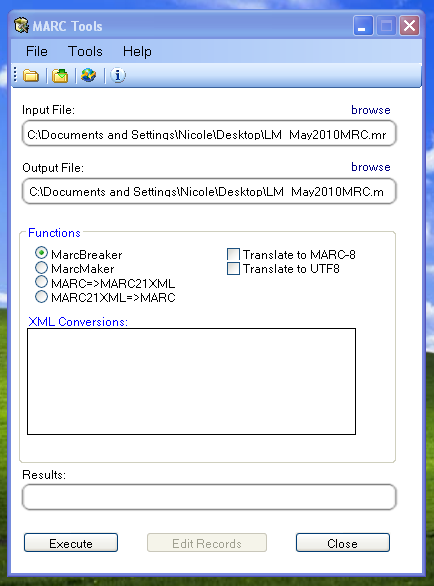
在螢幕下方將出現處理記錄的摘要

按 『編輯紀錄』 繼續新增館藏紀錄
畫面出現 MARC 記錄

按工具 > 新增/編輯欄位
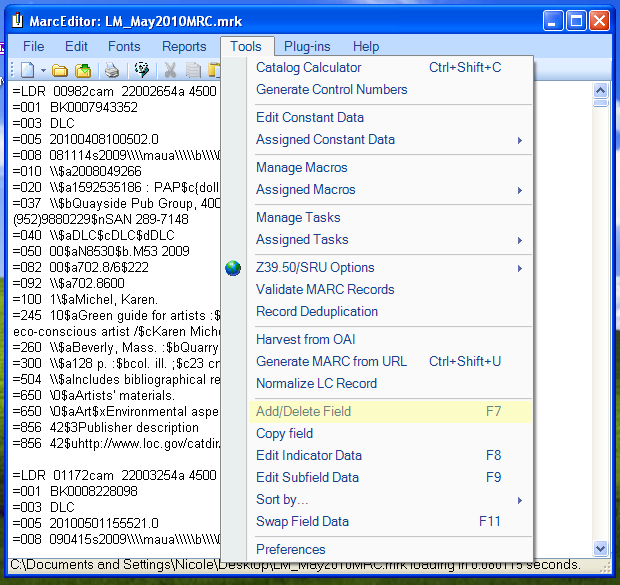
進入 Koha 的館藏資訊

在欄位盒鍵入 942
在欄位資料盒,鍵入 \\$c 及其館藏類型代碼 (在此例是 \\$cBOOK)
按 『插入最後』 選項
按 『新增欄位』
鍵入館藏紀錄資料
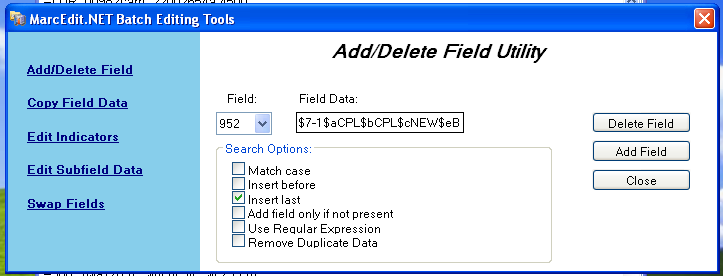
在欄位盒,鍵入 952
在欄位資料盒,鍵入 $7ORDERED_STATUS$aPERM_LOC$bCURR_LOC$cSHELVING_LOCATION$eSOURCE_OF_ACQ$yITEM_TYPE
ex. $7-1$aCPL$bCPL$cNEW$eBrodart$yBOOK
安裝 Koha 時,-1 是訂購狀態的預設值
可以編修其他欄位的資料 – 如:改變館藏代碼,讓所有的館藏放在一起 (8)、自動填入採訪日期 (d)、填入公開附註 (z)。
使用 $ 做為分欄代碼;每列新增一個分欄讓多個館藏可以匯入 MARC 紀錄 (在上例中,四個館藏,各有對應的分欄)
確認在管理 > 容許值裡,在欄位鍵入正確的代碼
按 『插入最後』 選項
按 『新增欄位』
關閉欄位編輯視窗
按檔案 > 進入 MARC 編輯

選定儲存檔案的位置
進入 Koha 系統,遵照 匯入 MARC 紀錄 <stage-marc-records-for-import-label> 的指示。
進入之後,到館藏記錄並分別修改其條碼,將把館藏狀態由訂購中改為不外借欄位的空白列。
說明
向代理商取得館藏記錄時,可要求代理商提供 MARC 記錄;這樣,才能夠匯入它,覆寫原來的記錄,並自動置換需要的資料。


